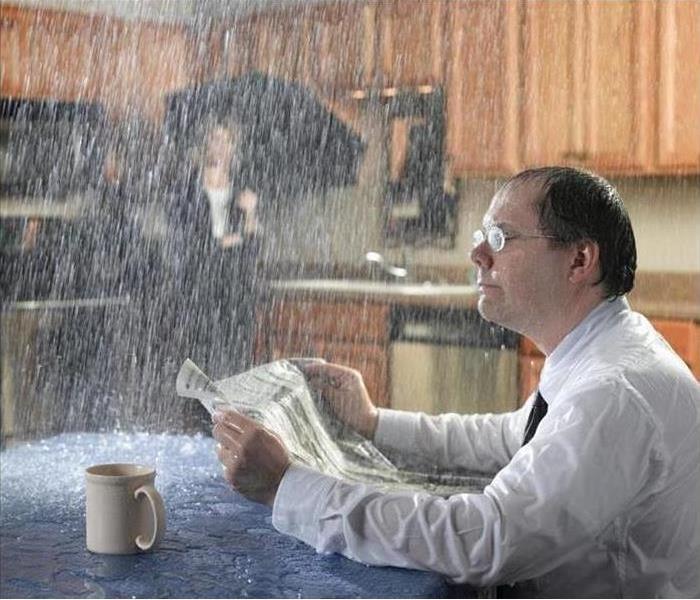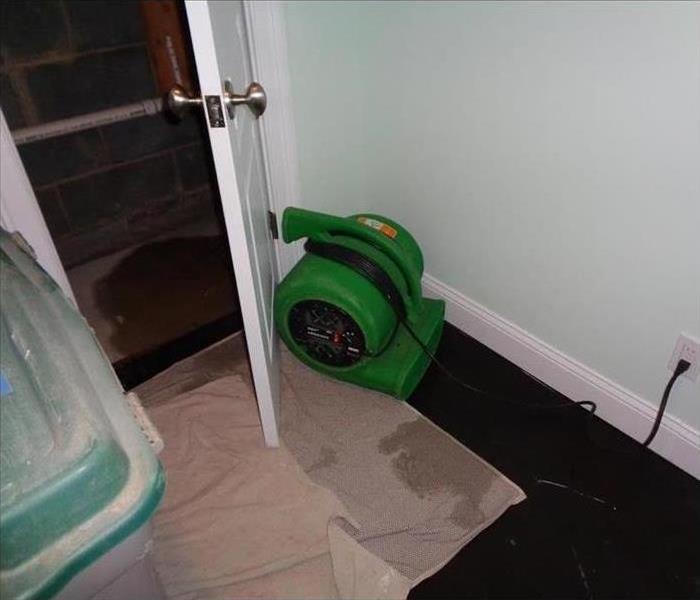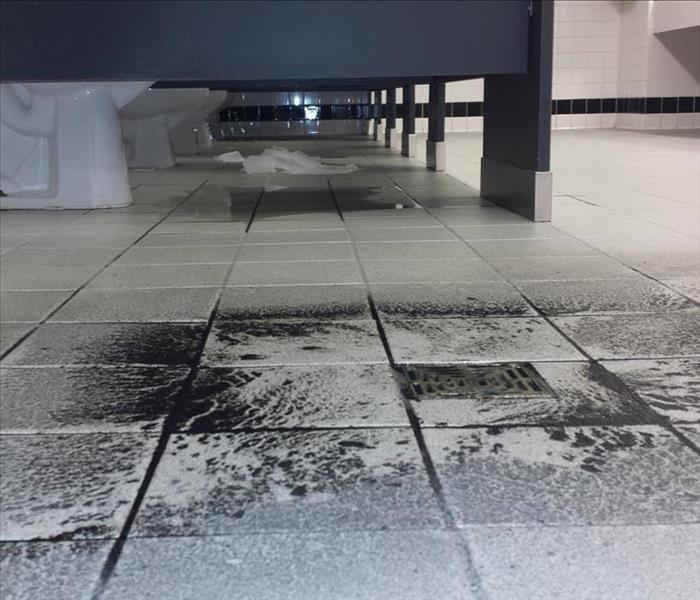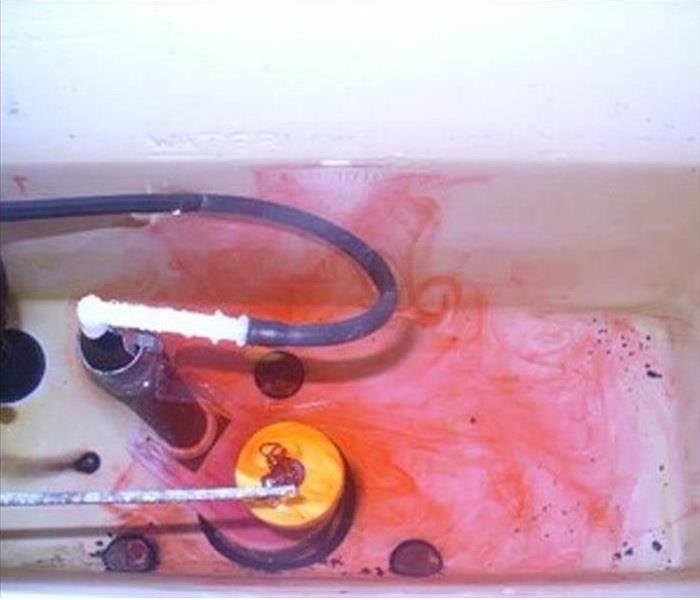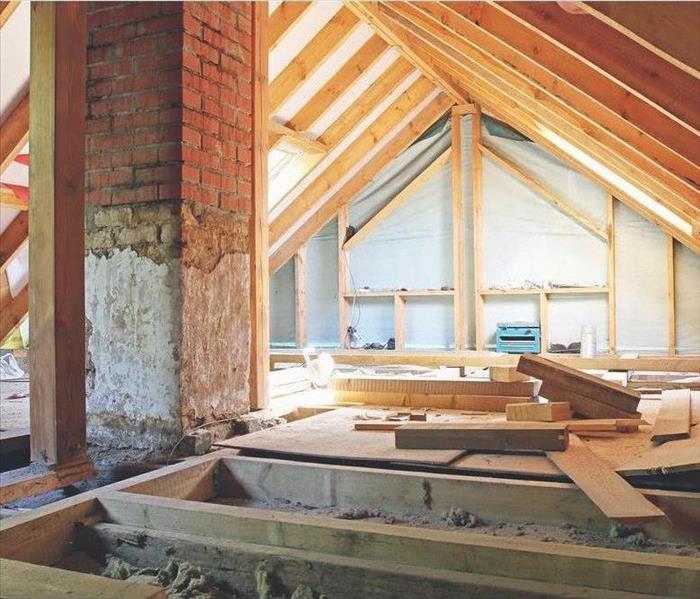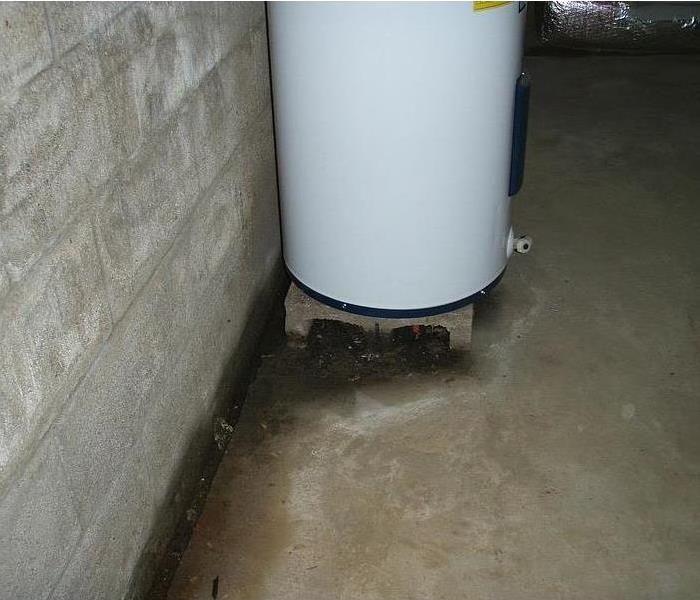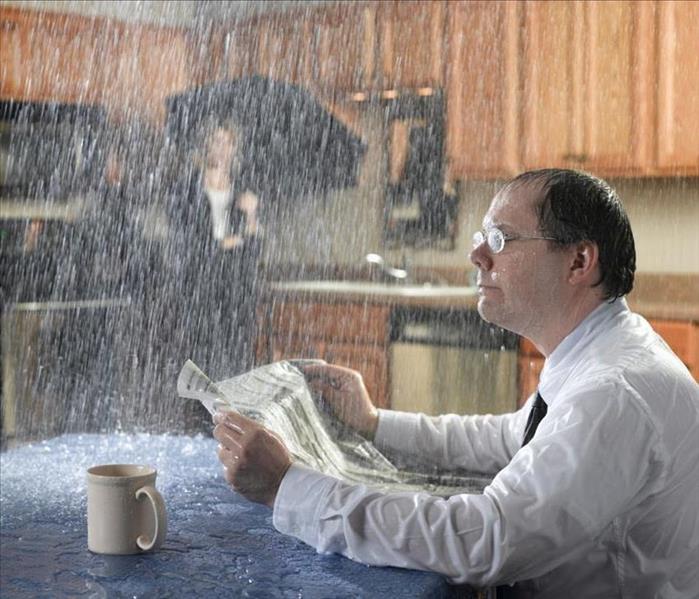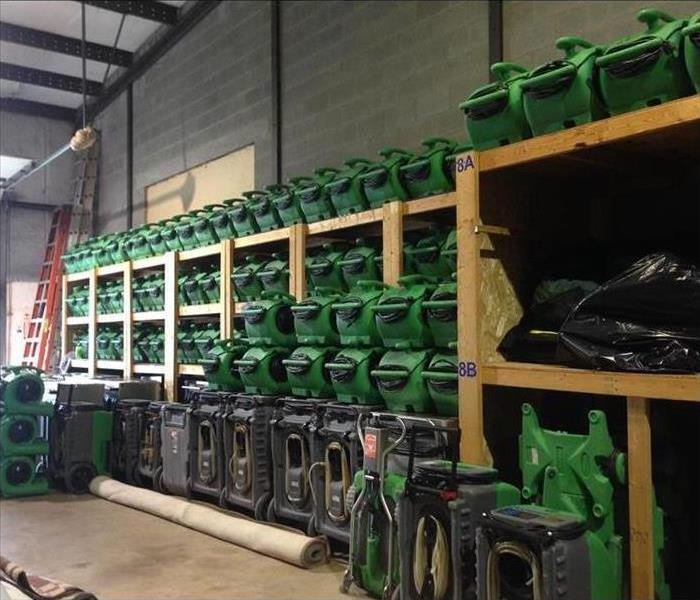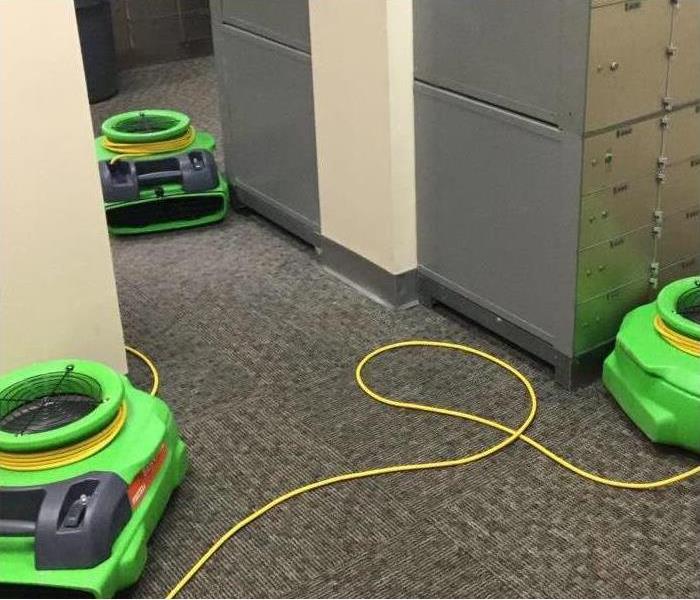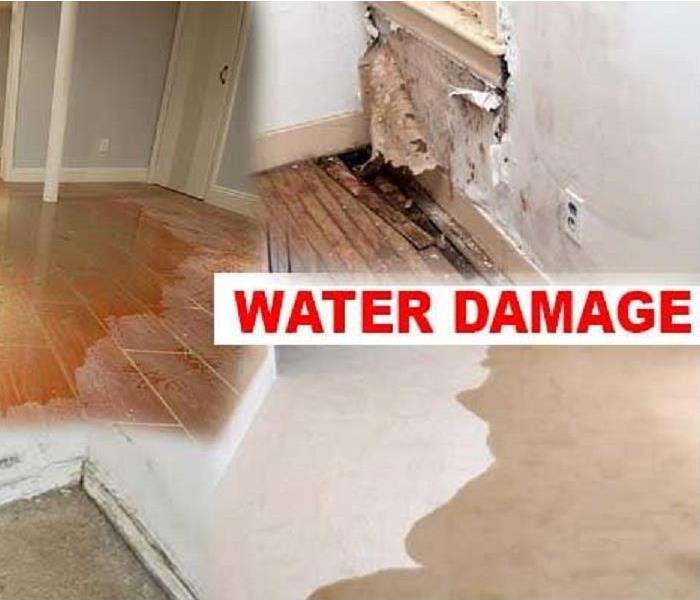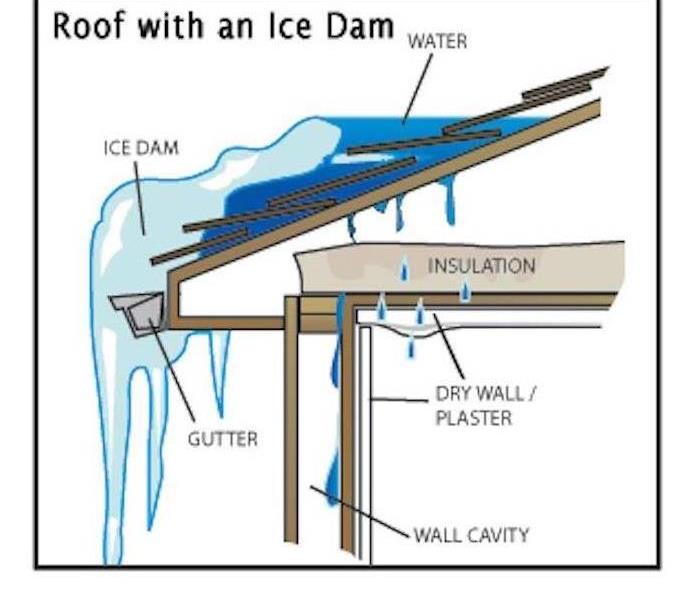Recent Water Damage Posts
Ways To Prevent Flood Damage In Your Home
8/2/2023 (Permalink)
No homeowner wants to watch their belongings washed away in one single day. This is why many of them take preventative measures to protect their home from flooding. As a homeowner, you should take these precautions as well.
In the long run, it will protect your property from being prone to water damage and flooding. Here are a few steps you can take to prevent flood damage in your home.
#1. Landscaping
Many people underestimate the power of a landscaping job well done. This is perhaps the best solution for keeping your home safe from flood damage. Keep your landscaping groomed by always keeping your gutters and splash pads clean.
This will ensure that no debris is blocking the flow of water going away from your home. Apart from that, you can utilize a rain barrel to collect the rainwater runoff.
It will protect the rainwater from pooling too much and you can use it for watering plants in your yard and garden.
#2. Monitor The Foundation Of Your Home
This is the most basic maintenance you need to do for your home. Foundations of homes can develop cracks over time. These cracks can let water seep in and this can widen the cracks further.
If the cracks get too wide then your house will be damaged by flooding. So, to protect your home from this you need to monitor your foundation and fill up any cracks with mortar or masonry caulk if they appear.
However, if your foundation continues to have cracks with time then you will need to call a professional to fix this issue as this is the biggest reason for flood damage.
#3. Seal Open Areas Of Your Home
Even if you monitor the foundation and fill the cracks, you still need to seal other areas in your home. These include walls, windows, and doorways.
Give them an extra coat of protection by applying a sealant. This will prevent rainwater from coming into your home. It is the biggest protector of homes from harsh weather conditions.
#4. Install Drain Plugs
This is the most overlooked measure but it is also just as important as any other. That is because your home can be prone to flood damage because of your sewage. If it backs up then it can get clogged which will eventually lead to flood damage.
This is why you should install drain plugs inside the floor drains in your basement. Doing so will ensure that your home doesn't get flooded through the toilet or sinks. Installing drain plugs is an integral component of keeping your home safe from flood damage.
Final Words
These are the top four ways you can utilize to protect your home from extensive flood damage. Taking these preventative measures early on will keep you from having an extensive problem in the future.
If there is any damage in your home and you need restoration then call our experts at SERVPRO. We will be happy to assist you and make sure your home is safe from all sorts of damage. Get in touch with us now.
Ways to Diagnose Water Damage in a Property
8/2/2023 (Permalink)
Water damage is a collective term that is coined to refer multiple impairments that have occurred due to persistent water attacks on a system thus destroying the material through various destructive processes, for instance, decaying of wood, corrosion of steel, mould or bacterial growth and so forth. Thus water damage can be problematic if not diagnosed immediately in its early destructive stages but property owners usually tend to neglect the issue as they reckon it as a consequence of either defective plumbing or may be due to structural defects.
Water damage that we notice is nothing as compared to the internal damage that it has caused the foundations of your property since most water damage begins deep in the walls leading to structural loss hence this can only be repaired by the aid of a trained professional who will not only analyze the issue but will also repair it.
So, here is how we can diagnose if the property has been damaged by water or not:
Dark or Wet Water Blotches:
The first and foremost sign that you should be looking while detecting the water damage is the wet stains of water that are usually found on the walls or ceilings. These yellowish water circlets are very easy to identify as they are quite obvious.
Inflated Drywalls:
At times the dry walls of the house, building or any other property tend to absorb moisture that is present within the walls, due to which they get swollen or simply puff out, therefore, it is imperative to check every wall to inspect for the inflated walls. These inflated walls are another sign indicating severe water damage.
Crumbling Wooden Items:
The most vulnerable material to water damage is wood as the wood fibres tend to swell and shrink. They shrink when discharge water and swell when absorb it. Swollen wood is more liable to crack and crumble down if not fixed instantly, so if you are suddenly observing your wooden furniture or any other wood-based item fractured and swollen thus you need to get it fixed promptly before this water leakage is successful in dilapidating it.
Tattered Walls:
Tattered or run-down walls are another clue for water damage. Excessive moisture within the walls makes the paint clammy and damp thus slowly and gradually, the paint starts peeling off or in some areas, it bubbles out. So if you notice patched walls or discoloured and bumping paint do not hesitate in calling water damage control department.
Mould and Bacterial Growth:
One major signal that screams "water damage" is the growth of moulds, bacteria and other minute viable organisms on your property. Apart from damaging your stuff, they are also a threat to your life since they may pose some fatal health issues. Mould and bacterial growth simply tell you that the water damage is severe and needs to be examined properly.
Some numerous signs and indications may signal for water damage, some can be easily identified like the dampness of the walls, fractured ceilings while some require a professional's expertise to resolve the matter for instance terrible exterior etc. whatever the cause is, water damage is an alarming issue that must not be left unnoticed.
Water Damage Restoration Tips And Tricks
8/2/2023 (Permalink)
Has your home or office experienced any water damage? Taking immediate action will only minimize the damage further. This is why you need to take action as soon as possible. Even though you need the services of experts in water damage remediation, there are many things that you can do yourself to minimize the loss. So, if your property has been damaged by water you need to follow some tricks and tips. Following these tips will ensure that the damage is minimized and will also ensure the safety of people present on the site. Want to know what these tips and tricks are? Keep reading then.
Dry Out The Affected Area
To minimize the damage, you must dry out the affected area as soon as possible. The presence of moisture in the affected area will only damage it further. This is why you need to be as thorough as possible. In smaller spaces, you can use fans to dry out the area affected by water. But, fans will not be effective in large spaces. So, if you need to dry out the larger space you can rent a large capacity dehumidifier.
Disinfect The Area
Once the area has been dried out and the damaged components have been removed, you need to disinfect the whole area before you start using it. Disinfecting the area is important so that the mold does not grow there. There are many ways through which you can disinfect the area but mostly bleach is used by the people. If you are not comfortable with using bleach, there are many other options that you can use instead.
Repair The Ceiling First
The ceilings that are damaged with water are riskier than other areas. This is why you need to repair them first or else they will collapse. If the damage is beyond control, you will need to remove the affected ceiling or boards. If it is repairable, then you can repair it as well. To repair the leaking ceiling, you must find the source of the leak first. Meanwhile, you need to make sure that the water does not cause any structural damage to your property.
Replace Damaged Wood
The wood that has been damaged by water will rot and develop mold on it. This is why it needs to be replaced as soon as possible. But, before replacing the damaged woods, you need to thoroughly clean the area beneath the wood. Also, you need to be careful about the placement as well and make sure that the structure has the right support.
Contact Professionals
The professionals can take of your damaged property in ways that you cannot do it yourself. So, if your property has been damaged by water, it is advisable that you avail the services of a professional company that can restore the place to its original form.
If your property has been damaged by water, you should take immediate action to restore the place back to its original form. It is an extremely important job that needs expert supervision. So, if you are looking for a team of professionals that would take care of your property, you must contact SERVPRO and avail the professional services.
Tips To Prevent Basement Flooding
8/2/2023 (Permalink)
Flooding damage is expensive to repair. To save yourself from this cost you must take preventative measures so you don’t end up putting a dent in your pocket.
The main causes of flooding are overflowing gutters, cracks in the foundation, leaky windows, and water seeping into the walls. To make sure that all of this doesn't happen to your home, here are a few measures you can take.
Clean Your Gutters
An inefficient drainage system is the biggest cause of flooding. This is why you must clean your gutters and drainage system and get rid of any debris that may cause a blockage.
This will ensure the water to flow freely and drain efficiently without causing any damage to your home.
Maintain Proper Landscaping
You may be wondering what landscaping has got to do with basement flooding. However, if your hard grades towards your house then you are at a higher risk of basement flooding.
Your home grade needs to be directed away from the house. This is why your lawn should be properly sloped. To fix this problem you can opt for many landscaping solutions that can direct the water away if need be.
Inspect And Repair Any Cracks In Foundation
A small crack in the foundation or a window can cause the entire basement to flood. This is why you must have a routine foundation inspection so that such cracks can be filled and taken care of.
You can inspect it yourself and fill the crack with epoxy. However, if there is still leaking from somewhere then you should call a professional as soon as possible.
Get Window Well Covers Installed
If your basement has windows and they are protected by a well cover then they should be. This is a great way of letting some light into your basement while protecting it from water.
You can get a clear acrylic window well cover to get the most out of them. They will keep any water and pests out from your basement ensuring cleanliness.
Maintain Your Sump Pump
Failure of sump pump maintenance is also one of the major causes of flooding. This is because a sump pump defends your home against many things such as flooding, mold, other water damage, etc.
However, for it to fulfill all these functions you need to maintain it too. Before any harsh weather conditions or storms, you should always get your sump pump checked.
If there are any problems then they should be quickly fixed so that your home can be prevented from flooding damage.
Final Words
Your home is your investment and your safe place. This is why maintaining it should be your topmost priority. However, if for any reason there is basement flooding or other water damage then you should immediately call a professional.
We offer all kinds of cleaning services and our expertise in this industry is unparalleled. For more information on what we offer, feel free to get in touch with us now!
When Should You Contact a Water Damage Restoration Company?
9/21/2022 (Permalink)
When Should You Contact a Water Damage Restoration Company?
If you’ve experienced water damage in your home, it can be hard to know where to start. Should you try to clean up the mess yourself? Call a plumber? Contact an insurance company? Get estimates from several restoration companies? The answer is that first and foremost, if there is standing water or significant amounts of water coming out of your pipes, contact a professional 24-hour emergency service ASAP. Once the immediate danger has been taken care of, call one or two reputable restoration companies for estimates on how much it will cost to get your home back into shape.
When should you call a water damage restoration company? You might be asking yourself that question because your basement flooded and the carpet is soaked or your washing machine overflowed and leaked into the kitchen. Not sure if you need to call a water damage restoration company? We're here to help! In this blog post, we'll discuss when it's time to contact a professional for assistance with water damages in your home so that you can reduce any long-term effects of these types of disasters.
When the Damage Is Too Much For You to Handle On Your Own
Sometimes the damage can be too much to handle for you on your own and you know you need a professional to get rid of your water problem. If the damage is too much for you to handle on your own, call a water damage restoration company immediately.
When You Have Standing Water or Pipes That Are Leaking
If there's standing water in your home or if there are pipes that have been compromised and are leaking, it's important that you contact a 24-hour emergency service as soon as possible so they can get out to your location ASAP. The longer the water sits inside of your walls or carpeting, the more likely it will be that mold will begin to grow and/or cause structural problems within the building itself. If this occurs, not only do you run a higher risk of developing health issues due to exposure to growths caused by mold spores but also having all this water damage repaired will be a lot more expensive.
When You Need a Fast Turnaround Time for Repairs to Your Home or Business
Not only is it important that you contact a professional as soon as possible, but you also want to find one who can offer same-day service or at least 24 hours’ notice of when they plan on arriving for repairs. The faster the turnaround time from the moment your call has been made until help arrives, the better off your home and property will be in terms of minimizing any further long-term effects after water damage occurs. Also keep in mind that if there are outlets or appliances which have been destroyed due to this occurrence, not calling a restoration company quickly enough could mean being without these vital amenities for quite some time.
Ways to Secure Your Home during a Flood
9/21/2022 (Permalink)
Ways to Secure Your Home during a Flood
The last thing you want to worry about when there is a flood in your area is whether or not your home will be safe. Floods can happen anywhere and at any time, so it's important to take precautions beforehand to make sure that you are fully prepared for the worst. That being said, here are some ways you can secure your house during a flood:
Grade your lawn away from the house
If you have a slope in your lawn leading up to the house then this will make it easier for water to enter. Take some time before the flood season begins and grade your yard away from your home so that there is less chance of water collecting around your foundation.
Install window well covers
Floods tend to happen quickly, which means that if there's anything obstructing windows on lower levels (like window wells) - they could prevent people inside the home from getting out safely when needed. To avoid any potential risks or problems, install window well covers that can be removed easily by anyone who needs them during an emergency situation. This way everyone stays safe while waiting for rescue teams arrive!
Create sand bags
Sandbags are great because they can be taken down and put back up again as many times as you need them, which is perfect if there's a flood season that follows multiple storms. When first approaching your home during a flood it might look like the only thing left to do is abandon ship in favor of higher ground - but by creating sand bags around entry points (like doors) you'll greatly reduce the possibility of flooding in the home when things finally start to recede.
Leave space between siding & mulch
In severe cases, flooding can even cause mulch to start decomposing which is a major risk for mold as well as other health problems. In order to avoid these risks, leave about an inch of space around the base of your house so that water has room to flow away from it instead of collecting at its foundation. This will reduce chances of damage and ensure that everyone inside remains safe during a flood!
Block All Entrances and leave no space for the water to come in
Make sure there is no space for the water to collect around your home's foundation or windows and doors. Put anything you can find to block entrances in front of all doorways. It is important that you do not allow any gaps between items as this will encourage flooding into the house when it occurs again. This also includes allowing plenty of room around windows so that they are able to open safely during an emergency situation! If possible - leave at least a foot gap from siding on the side of your house nearest where flood waters are likely to enter (like near garage doors) so that everyone inside has enough time to escape if necessary before water rises too high within the home.
Blanket all windows with plastic sheeting so the water cannot sleep in.
Once you have blocked off entrances, it is important to protect any openings that are left vulnerable by covering them up as much as possible. If there are glass windows on your home - use plastic sheeting or tarps over top of these until the flood waters subside and remove once problem has been averted! High winds can cause this material to fly away during a storm making it even more vital that everyone inside knows how best to secure their house properly before things get out of hand! Make sure all roof vents are securely covered just like other unprotected areas around your home's exterior too if at all possible because anything not protected will be especially susceptible during floods.
Water Damage Restoration Companies like SERVPRO can save your property and its value
9/21/2022 (Permalink)
Water Damage Restoration Companies like SERVPRO can save your property and its value
It is important to know that there are water damage restoration companies out there who can help you if your property has been damaged. SERVPRO is one of the best restoration companies in the country, and they provide professional services for both residential and commercial properties. Their teams will come on site with all necessary equipment to begin their work as quickly as possible, so your property can be restored back to its original condition. Whether it's water damage or fire damage, SERVPRO professionals will help save your property!
How Can a Water Damage Restoration Company Boost the Value of Your Property?
Water damage restoration companies can help save your property, but it's also important to know that a water removal company can make sure you get the best price possible when selling. If your home or business has been damaged by flooding from severe weather conditions, SERVPRO professionals will take care of everything for you. They'll extract all standing water and restore your property back to its original state. If you're selling, having a professional water damage restoration company come in and make your home look good as new will give the buyer peace of mind that everything is up to par. They'll be more confident buying from you, resulting in better offers!
Restoration companies not only dry up your house, they also remove mold and the results are usually long lasting when there is a professional company involved. This can also increase the resale value of your house. Clean sewerage system and up to date and well maintained plumbing all add up to the overall value of the property.
If You Are Looking For a Water Damage Restoration Company In Your Area Then What Should You Do
Water damage restoration companies are available all over America, so don't hesitate to contact one if your property has been damaged by any kind of water or flooding event. Not only can they help save your home or business with their services but they can also increase the value when it comes time for resale. Searching online is easy too; if you are in Woodbury, then you can get in touch with professional at SERVPRO. You can contact us anytime of the day or night, and we'll come onsite right away. We work around the clock to make sure your property is drying up as quickly as possible!
Without proper restoration after water damage, you will never be able to get the right price for your house. SERVPRO is one of the best water damage restoration companies in America and they will make sure you get maximum dollar for your home or business.
A Water Damage Restoration Company Like SERVPRO Can Be A Good Investment For Your Property!
Water damage can cause a lot of stress, but you don't have to go through it alone because there are many water removal services available to help save your property and increase its value when it comes time for resale. If you want peace of mind that everything will be alright after suffering from any flooded area, then we suggest getting in touch with SERVPRO today.
How to Pick a Water Damage Restoration Company
9/14/2022 (Permalink)
How to Pick a Water Damage Restoration Company
Are you looking for a water damage restoration company? If so, then this blog post is for you! There are many factors to consider when hiring a water damage restoration company. Understanding these questions before making your decision will ensure that the right choice is made and all of your needs are met. Check out our helpful tips below to find out more about what questions to ask and how to make an informed decision on which company to hire.
See If the Company is certified
Get a quote from the company that you have chosen. Check their license number to ensure they have insurance coverage in case something goes wrong during restoration services. If you can’t get an estimate on site then ask for one over the phone or email before hiring them so that there will be no surprise fees at the end of it all! Be sure to do some research into every company by looking up their reviews (be wary of Yelp). Read consumer reports online where other people who were satisfied with these companies leave feedback about their experiences. The more information out there means better chances of finding someone reliable!
Check the online reviews
See what other people are saying about the company. If you’re not sure who to hire, check out the reviews and ratings of each company. This can help guide your decision when trying to find a water damage restoration company in your area! The more positive feedback that is found online about the business means it will be much easier for you to choose them. You should always try and set up an appointment with these companies so they can give you better estimates on how long it will take to get this task done as well as their rates. If possible try and do some research into what other people have said beforehand too because then there won't be any surprises at the end of this process!
Check Out Their Reputation
It is important that we know where our money goes after hiring someone. We can look up the company's license number to see if they are insured. If you aren't able to get an estimate on site, ask for one over email or phone before hiring them so that there will be no surprise fees at the end of it all! Do some research into every company by looking up their reviews (be wary of Yelp). You should also check out consumer reports online where other people who were satisfied with these companies leave feedback about their experiences. The more information out there means better chances of finding someone reliable!
Check if they have insurance coverage in case something goes wrong during restoration services
See if the company is insured so in case there is any problem during the restoration process the insurance can take care of it. This is why it is very important to always hire an insured damage restoration company.
How to Save Your Belongings from Water Damage
8/16/2022 (Permalink)
How to Save Your Belongings from Water Damage
Water damage can be a really scary thing to experience. What do you do if your belongings get wet and moldy? The answer is simple: don't panic! We have put together this blog post to help give you some tips and tricks for saving your possessions from water damage. Read on for more information about what to do in the event of a flood, how to prevent water damage, and more.
Keep Your Valuable at a High Point during a Flood
During a flood, the first thing you are likely to think about is what valuables can be saved. If there isn't an immediate threat of your home being flooded, try moving them to higher points in order to keep them safe from water damage. The main things that should be moved would be anything digital or electronic-based because these could easily become destroyed by moisture in the air. You also want to make sure any important documents and photos are kept out of harm's way since they contain sensitive information which needs protecting! Keeping items at high points will help ensure they stay dry during a flood so don't forget this step if one becomes imminent!
Seal Your Belongings in Zip lock Bags before Putting Them Away
If you feel like there's a chance of your belongings getting wet, it is important to seal them up in zip lock bags before putting them away. This will help ensure they stay dry during the flood and any furniture or other items won't get damaged by moisture either! If something does happen, at least you can be more confident that your valuables are safe inside their packaging.
Remove All Your Belongings from the Basement
If you have a basement, it is best to remove all your belongings from that area. This might seem like an extreme way of preventing water damage, but basements are known for being susceptible to flooding so there's no point in taking any risks! If you don't want anything getting wet or damaged because of the flood, this is one simple step which will go a long way toward keeping everything nice and dry during the event.
Avoid Keeping Anything outside the House during Flood Warning
If you live in a flood-prone area, it is best to avoid keeping anything outside the house during a flood warning. This means that if you have something like an outdoor fridge or freezer, leave them where they are because there's no point putting your belongings at risk of being damaged by water. If the items do get wet and moldy, you will still be able to use them but discarding them might not even be necessary!
Don’t Put Your Furniture near Pipes or Drainage Systems
If you have a lot of furniture in the house, it is best to put them away from pipes or drainage systems. If they get wet, these items can cause water damage and moldy smells within your home which no one wants! Try placing all heavy pieces further back against walls where they won't be near anything that will cause problems when there's a flood. This simple step could save several possessions from being damaged by moisture during floods so make sure any big pieces are kept well clear of problem areas!
How To Keep Your Home Safe From Flooding
10/1/2021 (Permalink)
How To Keep Your Home Safe From Flooding
As the storm weather approaches, you want to ensure that your home is completely safe and flood-proof. Having to deal with flood damage, later on, can be quite taxing, both, mentally and physically. So, the best thing to do is assess what needs to be done beforehand so that you can keep yourself and your home safe from any kind of flooding. Let’s look at what you need to do to ensure this.
- Assess All The Possible Entryways For Water
The first thing that you will need to do before anything else is to assess whether there is any possibility of floodwater coming into your home. You will easily be able to tell this by taking a look at any gaps or slopes around your home.
Doing so is essential if you want to take the right steps to keep your home safe from flooding. Otherwise, at the last moment, you will be running around trying to stop water from coming into your home.
- Get The Relevant Renovations Made
If you have been through similar situations before as well, then you know how important it is to renovate your home. Once you have assessed the entryways of water, you will have to ensure that they are completely blocked so that you can keep floodwater out of your home. Don’t wait until the last moment, make sure that you get these done early so that you can be prepared.
- Clear Out Gutters
One of the main issues that come with flooding is the blockage of gutters. To keep flooding at bay, you will have to ensure that you clear out the gutters and the pipelines so that the water can run through them without any issues.
If you do not do this, then the possibility of your gutters overflowing and water coming inside becomes more likely. So, get your gutters cleaned out to lower the possibility of this happening to your home.
- Cover Any Gaps Around Your Home
One of the main reasons why water finds a way inside your home is because of the gaps all around. When you’re aware of an upcoming storm or the particular season approaching, then you should make sure to cover all these areas up.
If you’re looking for an effective way to do this, then try using sandbags to prevent water from coming in. It works great as the weight of the sand blocks the gaps and can easily be molded into the area you want to fit it in. So, try to do this as well to keep water out.
Who To Call In Case Of Flooding?
If you find yourself in a situation where you’re not able to keep the water out of your home, then you’re sure to find your home filled with water. In such a situation, you will need to reach out to professionals to help clear out all the damage from your home.
How a Water Softener Can Prevent Water Damage
9/20/2021 (Permalink)
How a Water Softener Can Prevent Water Damage
Having hard water in your home can be a problem that becomes costly over time. Hard water is mainly groundwater that contains dissolved minerals. When this water is combined with heat as it flows through the piping system of your home, it can leave behind residue and buildup which can damage the pipes in the long run.
Hard water is simply water that has collected calcium and magnesium from the surface of the earth before it flows through your pipes. While it is not exactly harmful to your skin or health, it can be a contributing factor towards water damage in your home.
What is a Water Softener?
To find a solution to your hard water problems, it is recommended to invest in a water softener. This simple device processes the hard water and removes the void of minerals present in the water through an ion-exchange process. The ion-exchange process replaces the mineral ions in the water with sodium and potassium ions – thus converting the hard water into soft water.
A water softener can be especially useful for homeowners who have prominent water damage in their homes that is caused by hard water.
Signs That You Have Hard Water
Since a majority of the US has hard water flowing through the pipes, it is difficult to determine whether or not your home actually needs a water softener. Below are the few signs of water damage caused by hard water:
- Water marks on faucets despite cleaning them
- Lime and chalk buildup in the sinks and shower heads
- Smelly water
- Low water pressure caused by damaged pipes
- Damaged water appliances and fixtures
Benefits of a Home Water Softener System
- Saving Money
The biggest benefit of installing a water softener in your home is that it can prevent you from spending hundreds of dollars on water damage repair. Soft water will not allow for any mineral buildup in your pipes, resulting in a smooth flow of water with regular pump pressure. By replacing hard water with soft water, you can prevent havoc on your appliances such as dishwashers or laundry machines and save costs on frequent repairs or replacement.
- Less Cleaning Required
If you have hard water running through your home, you may constantly find yourself cleaning the sinks and showers because there is mineral buildup visible around the edges. The dishes and the laundry may never appear fully clean because of all the mineral ions present in the water. Installing a water softener system at home will allow you to prevent all of this problems since soft water will not allow for any mineral or soap buildup around your faucets and sinks. This means that you will spend less time cleaning and have a cleaner house as well.
- Preventing Water Damage
Water damage can be a huge problem in your house if the pipes start leaking internally or externally. Since the repair cost and time of water damage can be extensive, it is important to avoid the instance of any water-related damage in your home. By opting for a water softener system in your home, you can keep your pipes and fixtures working effectively without incurring a risk of water damage.
How To Keep Your Home Safe From Flooding
9/20/2021 (Permalink)
How To Keep Your Home Safe From Flooding
As the storm weather approaches, you want to ensure that your home is completely safe and flood-proof. Having to deal with flood damage, later on, can be quite taxing, both, mentally and physically. So, the best thing to do is assess what needs to be done beforehand so that you can keep yourself and your home safe from any kind of flooding. Let’s look at what you need to do to ensure this.
- Assess All The Possible Entryways For Water
The first thing that you will need to do before anything else is to assess whether there is any possibility of floodwater coming into your home. You will easily be able to tell this by taking a look at any gaps or slopes around your home.
Doing so is essential if you want to take the right steps to keep your home safe from flooding. Otherwise, at the last moment, you will be running around trying to stop water from coming into your home.
- Get The Relevant Renovations Made
If you have been through similar situations before as well, then you know how important it is to renovate your home. Once you have assessed the entryways of water, you will have to ensure that they are completely blocked so that you can keep floodwater out of your home. Don’t wait until the last moment, make sure that you get these done early so that you can be prepared.
- Clear Out Gutters
One of the main issues that come with flooding is the blockage of gutters. To keep flooding at bay, you will have to ensure that you clear out the gutters and the pipelines so that the water can run through them without any issues.
If you do not do this, then the possibility of your gutters overflowing and water coming inside becomes more likely. So, get your gutters cleaned out to lower the possibility of this happening to your home.
- Cover Any Gaps Around Your Home
One of the main reasons why water finds a way inside your home is because of the gaps all around. When you’re aware of an upcoming storm or the particular season approaching, then you should make sure to cover all these areas up.
If you’re looking for an effective way to do this, then try using sandbags to prevent water from coming in. It works great as the weight of the sand blocks the gaps and can easily be molded into the area you want to fit it in. So, try to do this as well to keep water out.
Who To Call In Case Of Flooding?
If you find yourself in a situation where you’re not able to keep the water out of your home, then you’re sure to find your home filled with water. In such a situation, you will need to reach out to professionals to help clear out all the damage from your home.
Impact of Water Damage On The Property Value
9/20/2021 (Permalink)
Impact of Water Damage On The Property Value
Have you ever confused the term "water damage" with life-threatening water associated natural catastrophes like flooding or hurricanes etc.? Well, this is very likely to happen, but the term water damage is not used in this context rather it is a term that describes multiple damages caused by water leakage on your property thus making it decrepit in many ways.
It is a very slow and profound kind of deterioration as water travels along parallel surfaces thus eliciting its effect bit by bit. The destruction takes place in places that you've never noticed before, usually occurring deep within the walls, floors and ceilings. Destruction due to water mainly happens due to faulty plumbing possibly due to corroded and dripping pipes and toilets in addition to this, it is visible and prominent in places like bathrooms, kitchen and even refrigerators thus opening doors for multiple issues like fractured and swollen walls, growth of moulds, nasty smell, bumping and inflated paint etc.
Water damage has for sure negative impacts on the resale of the property and realtors or even property owners often face difficulties in making a sale deal for an already run-down property. One might think that what relation does water have with the property's value? This query is reasoned by stating fact that sellers generally highlight the pros and cons of the property when it is being sold having no clue about the destabilized foundations of the property chiefly done by the excessive water leakage until the new owner conducts the inspection and finds out about the declining state of the building.
Following are some ways through which water damage succeeds in lowering your house value:
Deflation in the price:
Water damage lowers your property's capital value as the price estimated for the restoration of the house is more as compared to its actual value thus whether you purchase a dilapidated property which is completely void from inside or you buy it and then spend large amounts of money on its restoration, Whichever the way is, you surely will be losing quite an amount of money.
Nil Electrical System:
Apart from making the property tattered, water damage disrupts the electrical layout of the building and a damaged electrical system is not only a threat to an individual's life but it further lowers the market value of the site.
Higher Chances of Re-occurrence:
A place that has been under the spell of water damage, might fall in the same pit again. This also makes buyers cautious once they are familiar with the problematic situation and ultimately your expectations of asking price are usually not met.
Water damage is more destructive than one can imagine and is brought into notice when the situation has aggravated tremendously. The control of water damage is a very expensive process as numerous problems need to be fixed for instance mould remediation, repairing of foundational and structural damages hence a lot of money is required for restoring a water damaged tumbled down mess to uplift its value.
4 Immediate Steps to Handle a Water Damage Emergency
9/14/2021 (Permalink)
5 Immediate Steps to Handle a Water Damage Emergency
Water damage can be infuriating. It is classified as one of the most serious emergencies that your property could suffer from – one that could possibly have long-term implications as well.
There are many ways that your property could get damaged by water, such as a heavy storm, flash floods, extreme rainfall, damaged pipes, overflowing water appliances, or even a leaking roof. Regardless of where your water damage stems from, it is mandatory to address the problem immediately to prevent further damage and to allow for repair strategies to be helpful.
When you face a water damage emergency at home, you should already have a plan in place that tells you exactly how to handle the situation. Here are a few steps that should ideally be part of your contingency plan:
- Protecting Yourself
The reason why water damage is considered extremely serious is because not only will there be floating water around your home, but the water can also further create more emergencies around the house. If the water is contaminated, there can be serious health effects if you come into contact with it. If you let the water reach electrical appliances, there can be a short circuit in the house or lead to electrocuted water.
To protect yourself, the first step in a water damage emergency should be shut off all electricity in your home. In case the water damage is caused by flooding, it is important to evacuate the home and reach a safe destination ASAP. Remember to wear protective clothing such as gloves and boots when you come in contact with the water to avoid the risk of contaminated or electrocuted water. You should also protect important possessions first – including important documents and electronic devices.
- Stop the Damage
In order to prevent further damage to your property, it is important to identify the source of the water damage and stop it immediately. If you have a burst pipe, you can shut off the water supply. If there is a flood in the area, you can use sandbags to lessen the impact. If you are suffering a ceiling leak, you should identify the exact point of leakage and reach out to a roofing expert.
- Call the Insurance Company
Since most houses in the US are insured, it is important to call the insurance company as soon as you identify water damage on your property. They are likely to guide you regarding what to do next, including getting a claims adjuster and taking photographs of the property damaged. This step is important to save money on damage repair in the future since your insurance company is likely to have it covered.
- Dry Everything
If it is possible, you should begin drying your wet furniture and flooring as soon as possible. Leave your rugs out in the sun to dry and turn on the fans to help dry out the entire house. This step is essential to eliminate the possibility of mold growth on your property due to still water and moisture in the home.
5 Immediate Steps to Handle a Water Damage Emergency
8/10/2021 (Permalink)
Water damage can be infuriating. It is classified as one of the most serious emergencies that your property could suffer from – one that could possibly have long-term implications as well.
There are many ways that your property could get damaged by water, such as a heavy storm, flash floods, extreme rainfall, damaged pipes, overflowing water appliances, or even a leaking roof. Regardless of where your water damage stems from, it is mandatory to address the problem immediately to prevent further damage and to allow for repair strategies to be helpful.
When you face a water damage emergency at home, you should already have a plan in place that tells you exactly how to handle the situation. Here are a few steps that should ideally be part of your contingency plan:
- Protecting Yourself
The reason why water damage is considered extremely serious is because not only will there be floating water around your home, but the water can also further create more emergencies around the house. If the water is contaminated, there can be serious health effects if you come into contact with it. If you let the water reach electrical appliances, there can be a short circuit in the house or lead to electrocuted water.
To protect yourself, the first step in a water damage emergency should be shut off all electricity in your home. In case the water damage is caused by flooding, it is important to evacuate the home and reach a safe destination ASAP. Remember to wear protective clothing such as gloves and boots when you come in contact with the water to avoid the risk of contaminated or electrocuted water. You should also protect important possessions first – including important documents and electronic devices.
- Stop the Damage
In order to prevent further damage to your property, it is important to identify the source of the water damage and stop it immediately. If you have a burst pipe, you can shut off the water supply. If there is a flood in the area, you can use sandbags to lessen the impact. If you are suffering a ceiling leak, you should identify the exact point of leakage and reach out to a roofing expert.
- Call the Insurance Company
Since most houses in the US are insured, it is important to call the insurance company as soon as you identify water damage on your property. They are likely to guide you regarding what to do next, including getting a claims adjuster and taking photographs of the property damaged. This step is important to save money on damage repair in the future since your insurance company is likely to have it covered.
- Dry Everything
If it is possible, you should begin drying your wet furniture and flooring as soon as possible. Leave your rugs out in the sun to dry and turn on the fans to help dry out the entire house. This step is essential to eliminate the possibility of mold growth on your property due to still water and moisture in the home.
Water Damage Timeline
9/22/2020 (Permalink)
Here are the reasons you should mitigate your water damage sooner than later.
Water Damage Timeline
Within Minutes
- Water quickly spreads throughout your property, saturating everything in its path
- Water is absorbed into walls, floors, upholstery, and belongings
- Furniture finishes may bleed, causing permanent staining on carpet
- Photographs, books, and other paper goods start to swell and warp
Hours 1-24:
- Drywall begins to swell and break down
- Metal surfaces begin to tarnish
- Furniture begins to swell and crack
- Dyes and inks from cloth and paper goods spread and stain
- A musty odor appears
48 Hours to 1 Week
- Mold and mildew may grow and spread
- Doors, windows, and studs swell and warp
- Metal begins to rust and corrode
- Furniture warps and shows signs of mold
- Paint begins to blister
- Wood flooring swells and warps
- Serious biohazard contamination is possible
After 1 week
- Restoration time and cost increase dramatically; replacing contaminated materials and structural rebuilding may be extensive
- Structural safety, mold growth, and biohazard contaminants pose serious risk to occupants
SERVPRO of Cherry Hill/Haddonfield specializes in the cleanup and restoration of residential and commercial property after a fire, smoke, or water damage event. We respond promptly, and dry your home quickly, minimizing the damage that your home sustains.
Water Damage Cleanup FAQ
9/18/2020 (Permalink)
- How long will it take my property to dry?
Drying time is determined by a combination of factors including the location, duration and source of water, the types of building materials, the weather conditions and how quickly emergency services begin. Through consistent monitoring and evaluation of the drying process, we can determine when the drying is complete. Your carpet may feel dry to the touch, but padding and sub-floors may still be wet underneath. While there are no rules to determine how long your property will take to dry, we can tell you it may take between three to five days or more, depending on the conditions.
- How do I know when my property is completely dry?
Proper testing with our specialized equipment is the correct way to determine if things are completely dry. Touch alone may be a false indicator.
- Will turning up the heat help dry things out?
Not necessarily. We will adjust the temperature to its optimum setting for the proper drying conditions. Please do not change the setting or shut off the system; doing so may prolong the drying process.
- My wood floors are wet and buckling. Will they have to be replaced?
Wood flooring must be evaluated during the drying process. We employ specialized drying systems and dehumidifiers which enable us to create an environment where wood floors can dry more efficiently and resume their original shape. Due to the density of hardwood flooring and urethane finishes, drying may take up to three weeks or longer. If you filed a claim, your insurance adjuster will work with you to make the final decision as to whether floors will need to be refinished or replaced. - What about my wet furniture?
The extent of damage and the construction of the furniture will determine if your furniture can be restored. Your furniture must be dried before damage can be adequately assessed. Non-salvageable furniture will be documented for you and if any items need to be discarded, a customer release form will need to be signed.
- Do I need to move out of my property during the water damage restoration process?
If you file an insurance claim, you may receive guidance from your insurance representative. However, this is a decision you must reach on your own. Here are several things to consider. Safety is paramount. Our equipment is as childproof as possible, but we require your supervision for making sure no children play with it. Air movers and dehumidifiers will create some noise and make your property drafty for a few days. It is important that the equipment remains on, so if the noise is disruptive to you, you might want to consider an alternate place to stay.
- What is that smell?
It is not unusual to smell odors during the drying process. Increased heat and humidity can also lead to increased odors that may be coming from the drying building materials, or dormant spill and accident areas. Do not confuse these normal odors for the odor of mold.As the drying process continues and humidity levels drop, you will notice these odors disappearing on their own. Deodorizers are often used to minimize these effects as well.
- Does everything need to be moved out during restoration?
Not usually. If items need to be moved out, we will let you know in advance.
- My ceilings are wet. What needs to be done?
Our technicians will evaluate moisture content, determine the severity of the damage and may have to remove some of your ceiling for ventilation. Wet insulation can also be a hazard and may need to be removed.
- Should I open the windows to help the drying process?
Opening your windows to assist the drying process is not always recommended. Outside weather conditions may vary, so the technicians will determine when and if the outside air is appropriate.
- Can I walk on the area during the drying process?
It is strongly suggested that you keep the traffic to a minimum. Wearing shoes is recommended for your safety.
A few reasons your carpet may not be salvageable:
– Delamination (occurs when the backing separates from the carpet fiber)
– Loss of adhesion (may be caused my prolonged exposure to water or age of the carpet)
– Permanent Stains
– Carpet covers wood flooring (to salvage the wood flooring)
– Sewage contamination
- Why does my specialty floor need to be removed?
Non-porous flooring can trap water and prevent it from drying properly.
- Why did the technician leave wet carpet on my stairs?
Carpet on the stairs is generally not removed for safety reasons. Exposed tack strip or staples, especially on steps is dangerous. However, there are situations where removing carpet from steps is necessary to prevent damage to hardwood steps or in the case of sewage contamination. Removing tack strip is not advised, as this may damage the hardwood or the sub-floor. Extreme caution must be when ever tack strip is exposed or when the carpeted stairs are damp. If carpet left on the stairs is unsalvageable, it will be removed when new carpet is installed.
- How will you match my carpet pad?
A sample of your pad is brought to the office for a match. When available, an identical pad will be used. When your original pad is not available, we will provide a pad of the same quality, thickness and density. Similar pad may differ in color based upon the time it was manufactured.
- What will you do with my area rugs?
Rugs are taken to our warehouse for special care. They need to be dried carefully to minimize bleeding and colors and discoloration. Your rugs will be dried, cleaned and returned.
- Why are air movers and dehumidifiers used?
When water damage has occurred, water can be absorbed into the drywall (sheetrock), baseboards, sub-flooring, etc. Drying these surfaces requires high velocity air movers to accelerate the release of absorbed water into the air. Dehumidifiers are necessary for removing this excess moisture to help protect property and create conditions for efficient drying. Please do not turn off or move drying equipment without first calling ServiceMaster Clean.
- Who is responsible for monitoring the drying equipment?
Our water damage mitigation specialists will place and monitor equipment to achieve optimal results in the shortest amount of time. Please make sure no one turns the equipment off or moves it. Please notify our office immediately if the power goes off or if the equipment turns off.
- What will it cost to run the equipment?
Based on average electrical rates, it may cost about one dollar per day to operate the drying equipment.
- What about sewage contamination?
Hard surfaces can be cleaned and sanitized. Affected items that cannot be sanitized require disposal. Porous materials such as drywall, ceiling tiles, insulation, particleboard, paneling, etc. that have been directly affected should be removed during the emergency service visit.
Pros and Cons of Flat Roofs
9/18/2020 (Permalink)
Home and business owners throughout Southern New Jersey are considering upgrading their roofing may want to consider the advantages as well as disadvantages of installing a flat roof rather than one featuring sloped construction. SERVPRO of Cherry Hill/Haddonfield understands that flat roofs are becoming increasingly popular because of their affordability, but they must be properly sealed in order to maintain their structural integrity as well as properly maintained in order to prevent roof leaks.
There are several important advantages of selecting a flat roof over one that is sloped. Flat roofs are easier to access and stand on for the purposes of roof inspection. Their horizontal surface offers more stability than a sloped roof. They are much more affordable to install as well as re-coat than other styles of roofing. A flat roof is also viewed as more aesthetically appealing for use in warmer climates.
One major disadvantage that flat roofing has over a sloped roof is that its stability decreases as its size increases. A very large flat roof usually cannot avoid flooding after a period of heavy rains, and there is an increased risk of collapse from the weight of this water. In order to avoid flooding problems, the synthetic rubber coating that has been applied to the surface of the roof must be checked on a regular basis. Proper maintenance is also essential to avoiding roof leaks.
Home and business owners whose buildings currently have a flat roof that has not been checked or undergone regular maintenance should contact a licensed roofer for an inspection. If you do have a leak-- contact SERVPRO of Cherry Hill/Haddonfield immediately 24 hours a day, 7 days a week. Our professional team will ensure that water damage is repaired and get you back into your home or business in no time!
Commercial Water - 3 Signs of Irrigation System Problems
9/16/2020 (Permalink)
Three Signs You May Have Water Trouble Your Way
Curb appeal isn’t just for homes. Ensuring your property is appealing and welcoming makes a big impression on customers and employees. To ensure a luscious green lawn and decorative plants looking their best, and irrigation system is a great solution. Most systems are easy to use and reliable, but not properly maintaining them or ignoring issues can lead to flooding that makes its way into the property, potentially creating the need for a water damage and restoration professional to clean up the mess. Below are three signs that there may be water trouble headed your way.
Malfunctioning Sprinkler Head
At some point, an irrigation system will have a sprinkler head that gets damaged. This can happen from mowing, vehicles or improper pressure settings. Signs of a broken one include:
- Plastic casing is damaged
- Unit doesn’t come up
- Sprinkler head is missing
- Sprinklers with heads that are completely broken off
Low Water Pressure
A sure sign of irrigation problems is low water pressure. If the head isn’t popping up but not damaged or a minimal amount of water is coming out, there is an underlying issue. Potential culprits could be a misfiring back flow device or a leak. If there is a soggy area, it may mean the latter. If there is no obvious leak, compressed soil or tree roots could be causing the problem.
Inactive Zone
If one zone is not working, blocked electrical signals are often the cause. There could be insufficient voltage, which requires a new controller, or there could be damaged wires. The valve’s solenoid may also need to be replaced. If multiple zones aren’t working, it could again be related to power properly getting to the controller, which may mean replacing the transformer.
While an irrigation system can do wonders for a property, being diligent regarding maintenance and regularly checking this it is working properly are necessary to avoid added water issues.
Important Reminder in Responding to Water Damage
9/14/2020 (Permalink)
Although it may seem easier and relatively harmless to let water dry on its own, property owners need to understand the dangers of failing to properly respond to water damage. Despite the extra expense associated with hiring professional technicians, the cost and level of stress will be magnified exponentially when the problem is left untreated, as secondary damage is likely to result.
Reasons to Avoid Delay
When the water removal and cleanup process is not initiated immediately, you may see the following:
- Warped wood framing
- Weakened subflooring
- Broken or bulging ceiling tiles
- Rusted metal fasteners or supports
- Deteriorating drywall
- Peeling paint or wallpaper
SERVPRO’s 24/7 Response
Because we know how important it is to quickly respond to a water damage emergency, SERVPRO of Cherry Hill/Haddonfield prides itself on its 24-hour service. Our crew is ready for your call any time of the day or night, weekdays and weekends.
SERVPRO’s Customized Response
SERVPRO professionals perform in-depth assessments to ascertain the ideal action plan in restoring your property in a timely manner. Additionally, our technicians use the latest methods and top-of-the-line equipment to deliver the best results.
For an immediate and personalized response from our team at SERVPRO of Cherry Hill/Haddonfield, call us at (856) 662-2772.
SERVPRO - 24 Hour Emergency Service
8/25/2020 (Permalink)
SERVPRO of Cherry Hill/Haddonfield is available 24 hours a day for water emergencies, large or small. When you are dealing with water damage, immediate action is crucial. A delay of just a few hours can greatly increase the severity of the water damage.
We Answer the Phone Ready to Help
Call Today – (856) 662-2772
We understand that when you call us, you may be feeling confused, stressed, and vulnerable. You need an expert to guide you through this crisis. SERVPRO of Cherry Hill/Haddonfield has the specific water damage training and experience to help you through this tough time.
What to Expect
When you call, we will ask several questions regarding your water damage emergency. These questions will help us determine what equipment and resources to bring, including how many trained SERVPRO Professionals may be needed.
Our SERVPRO Representative will ask several questions:
- Your name and contact information
- Your insurance information (if applicable)
- The street address of the water-damaged home or business
- When did the flooding or water damage occur?
- What caused the water damage (if known)?
- Is there electricity available (on-site)?
If you experience Water Damage – Call SERVPRO of Cherry Hill/Haddonfield
Using Food Coloring to Diagnose a Leaking Toilet
9/20/2019 (Permalink)
If you have a heavy leak in your toilet, it's easy to diagnose - the faint sound of the toilet tank constantly replenishing is a dead give away. What about a slow leak? Diagnose it with food coloring.
If you have a slow leak in your toilet tank, hundreds of gallons are just slowly and silently cascading down the side of your toilet bowl every month. Fortunately you can easily detect if the uptick in you water bill is from a slow leak or not.
A simple test for toilet water leaks, place a half a dozen or so drops of food coloring into the toilet tank. Leave the toilet alone for a half hour or more. Come back and check to see if the water in the bowl of the toilet has become tinted with the food-coloring dye from the tank. If it has, you've got a leak between the tank and the bowl.
Roof Leaks & Homeowner's Insurance
9/19/2019 (Permalink)
Get help in claiming your homeowner's insurance caused by roof leaks.
Many homeowners find out that the damage-causing roof leaks are not covered by their homeowner’s insurance. This is often the case unless the roof has been damaged by the wind that caused it to leak.
Does Homeowners Insurance Cover Roof Leaks?
What determines whether or not your homeowner's insurance covers leaks in your roof, and any resulting damage is dependent upon what caused the leak. If, for instance, a windstorm, tornado or hail damaged your roof, your homeowner's insurance would most likely cover repairs or replacement. But if a maintenance issue like wear and tear is the reason, then you would in most instances be responsible for the costs.
Homeowners need to keep up with their home’s maintenance and day to day repairs. This is especially true when it comes to your home’s first line of defense– the roof. If a tree falls in a brutal storm and careens through your shingles, it’s good to know someone’s got your back to help cover leaks and arising repairs. That’s why it’s important to read over your homeowner's policy and seek advice from your insurer so that you know what’s covered by your homeowner's insurance.
How to Spot Roof Leaks
Spotting a roof leak early on could prevent more extensive repairs like water damage to your ceiling and mold growth in your insulation. However, finding the roof leak’s point of origin may prove difficult — sometimes even more so than fixing the leak itself. That’s because water will often infiltrate the roof in one location but trickle down to another location, where it starts to dampen the ceiling and walls.
If you find yourself in this position, please call SERVPRO of Cherry Hill/ Haddonfield today for help.
Choose a Highly Trained SERVPRO Professionals to Clean Your Water Damaged Property
9/18/2019 (Permalink)
Why Choose a SERVPRO Franchise Professional?
- They're Faster to Any Size Disaster
SERVPRO Franchise Professionals are dedicated to responding immediately to water and storm damage emergency.
- They're Highly Trained Water Damage Specialists
They specialize in water and storm damage restoration, the cornerstone of our business.
- They have the Resources to Handle Storm and Disasters
SERVPRO Franchise Professionals have a national network of over 1,700 Franchises across the country and elite Disaster Recovery Team strategically located throughout the country.
Regardless of the Storm Damage, They Can Help
Storms occurs with little warning and can be especially devastating, so you'll need the company that you can trust to rise to the occasion. Regardless of the type of storm. SERVPRO Franchise Professionals can handle any size disaster. During catastrophic storms and major events, our Disaster Recovery Team can respond quickly with additional resources.
- Flooding caused by heavy rains
- Hurricanes and tidal surges
- Tornadoes and wind damage
- Ice and snowstorms
- Wild fires
Possible Losses Caused by Water
9/17/2019 (Permalink)
Water damage describes a large number of possible losses caused by water intruding where it will enable attack of a material or system by destructive processes such as rotting of wood, growth, rusting of steel, de-laminating of materials such as plywood, and many others.
The damage may be imperceptibly slow and minor such as water spots that could eventually mar a surface, or it may be instantaneous and catastrophic such as flooding. However fast it occurs, water damage is a major contributor to loss of property.
An insurance policy may or may not cover the costs associated with water damage and the process of water damage restoration. While a common cause of residential water damage is often the failure of a sump pump, many homeowner's insurance policies do not cover the associated costs without an addendum which adds to the monthly premium of the policy. Often the verbiage of this addendum is similar to "Sewer and Drain Coverage".
Those individuals who are affected by wide scale flooding may have the ability to apply for government and FEMA grants through the Individual Assistance program. On a larger level, businesses, cities, and communities can apply to the FEMA Public Assistance program for funds to assist after a large flood. For example, the city of Fond du Lac Wisconsin received $1.2 million FEMA grant after flooding in June 2008. The program allows the city to purchase the water damaged properties, demolish the structures, and turn the properties into public green space.
Causes
Water damage can originate by different sources such as a broken dishwasher hose, a washing machine overflow, a dishwasher leakage, broken/leaking pipes, and clogged toilets. According to the Environmental Protection Agency, 13.7% of all water used in the home today can be attributed to plumbing leaks.[3] On average that is approximately 10,000 gallons of water per year wasted by leaks for each US home. A tiny, 1/8-inch crack in a pipe can release up to 250 gallons of water a day.[4]According to Claims Magazine in August 2000, broken water pipes ranked second to hurricanes in terms of both the number of homes damaged and the amount of claims (on average $50,000 per insurance claim costs in the US. Experts suggest that homeowners inspect and replace worn pipe fittings and hose connections to all household appliances that use water at least once a year. This includes washing machines, dishwashers, kitchen sinks and bathroom lavatories, refrigerator ice makers, water softeners and humidifiers. A few US companies offer whole-house leak protection systems utilizing flow-based technologies. A number of insurance companies offer policy holders reduced rates for installing a whole-house leak protection system.
As far as insurance coverage is concerned, most damage caused by bad weather is considered flood damage and normally is not covered under homeowners insurance. Coverage for bad weather would usually require flood insurance.
Categories
Category 1 Water - Refers to a source of water that does not pose substantial threat to humans and classified as "clean water". Examples are broken water supply lines, tub or sink overflows or appliance malfunctions that involves water supply lines.
Category 2 Water - Refers to a source of water that contains a significant degree of chemical, biological or physical contaminants and causes discomfort or sickness when consumed or even exposed to. Known as "grey water". This type carries micro organisms and nutrients of micro organisms. Examples are toilet bowls with urine (no feces), sump pump failures, seepage due to hydrostatic failure and water discharge from dishwashers or washing machines.
Category 3 Water - Known as "black water" and is grossly unsanitary. This water contains unsanitary agents, harmful bacteria and fungi, causing severe discomfort or sickness. Type 3 category are contaminated water sources that affects the indoor environment. This category includes water sources from sewage, seawater, rising water from rivers or streams, ground surface water or standing water. Category 2 Water or Grey Water that is not promptly removed from the structure and or have remained stagnant may be re classified as Category 3 Water. Toilet back flows that originates from beyond the toilet trap is considered black water contamination regardless of visible content or color.
Classes
Class of water damage is determined by the probable rate of evaporation based on the type of materials affected, or wet, in the room or space that was flooded. Determining the class of water damage is an important first step, and will determine the amount and type of equipment utilized to dry-down the structure.[7]
Class 1 - Slow Rate of Evaporation. Affects only a portion of a room. Materials have a low permeance/porosity. Minimum moisture is absorbed by the materials.
Class 2 - Fast Rate of Evaporation. Water affects the entire room of carpet and cushion. May have wicked up the walls, but not more than 24 inches.
Class 3 - Fastest Rate of Evaporation. Water generally comes from overhead, affecting the entire area; walls, ceilings, insulation, carpet, cushion, etc.
Class 4 - Specialty Drying Situations. Involves materials with a very low permeance/porosity, such as hardwood floors, concrete, crawlspaces, plaster, etc. Drying generally requires very low specific humidity to accomplish drying.
Restoration
See also: Convectant drying
Different removal methods and measures are used depending on the category of water. Due to the destructive nature of water, chosen restoration methods also depend heavily on the amount of water, and on the amount of time the water has remained stagnant. For example, as long as carpet has not been wet for longer than 48 hours, and the water involved was not sewage based, a carpet can usually be saved; however, if the water has soaked for longer, then the carpet is probably irreparable and will have to be replaced.[8] Water damage restoration can be performed by property management teams, building maintenance personnel, or by the homeowners themselves; however, contacting a certified professional water damage restoration specialist is often regarded as the safest way to restore water damaged property.
Standards and regulation
While there are currently no government regulations in the United States dictating procedures, two certifying bodies, the Institute of Inspection Cleaning and Restoration Certification (IICRC) and the RIA, do recommend standards of care. The IICRC-recommended standard is IICRC S500.
Fire and Water Restoration companies are regulated by the appropriate state's Department of Consumer Affairs - usually the state contractors license board. In California, all Fire and Water Restoration companies must register with the California Contractors State License Board.[10] Presently, the California Contractors State License Board has no specific classification for "water and fire damage restoration."
Procedures
Water damage restoration is often prefaced by a loss assessment and evaluation of affected materials. The damaged area is inspected with water sensing equipment such as probes and other infrared tools in order to determine the source of the damage and possible extent of area affected. Restoration services would then be rendered to the residence in order to dry the structure, sanitize any affected or cross contaminated areas, and deodorize all affected areas and materials. After the labor is completed, water damage equipment including air movers, air scrubbers, dehumidifiers, wood floor drying systems, and sub floor drying equipment is left in the residence. Industry standards state that drying vendors should return at regular time intervals, preferably every twenty-four hours, to monitor the equipment, temperature, humidity, and moisture content of the affected walls and contents.
Why is My Air Conditioner Leaking Water Inside my Home?
9/10/2019 (Permalink)
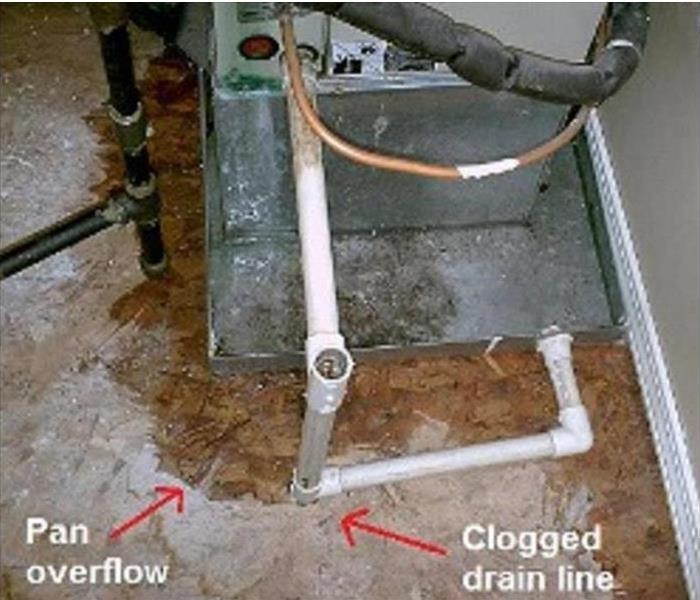 Water damage from an AC pan overflow and a clogged drain line
Water damage from an AC pan overflow and a clogged drain line
First, turn off your AC to prevent serious water damage and hazardous electrical issues. Next, we highly recommend calling a HVAC company for help.
Why water forms in an AC’s indoor unit
Condensation is a natural reaction that occurs inside all AC units.
You see, your AC’s job is to pull heat and humidity from the air inside your home. To do that, your system pulls in warm air through an indoor vent (called a return grille) and moves it across your inside unit’s cold evaporator coil to cool the air down.
When this happens, moisture forms on the evaporator coil. Just like the condensation that forms on a glass of ice cold water on a hot summer day.
Normally, the condensation on the coil drips into a drain pan and down a condensate drain pipe that leads it outside of your home (or into your plumbing system).
Now that you know why the condensation happens and the parts involved, here are a few common problems that can cause water to leak inside your house.
Clogged condensate drain line or rusted pan
If your drain line is clogged–commonly by dirt, algae, insects or a dirty evaporator coil–water drainage is limited; causing a buildup of water with nowhere to go other than your home.
And because it is so hot and humid, your AC runs more often so it doesn’t take long for large amounts of water to build up.
Also, the drain pan may be rusted through, allowing the water to fall through the pan and cause disastrous leaks and dangerous electrical issues inside your home. So, you’ll definitely need to replace the pan.
Improperly installed condensate trap
If your AC is fairly new, the problem could be with the way your system’s condensate trap was installed. An improperly designed condensate trap can block drainage and cause the drain pan to overflow with water.
What to do: You’ll need a professional to know what to look for in a condensate trap design and to see if it needs to be reinstalled.
Frozen evaporator coil
Condensation on your cold evaporator coil can also freeze. If it does, there’s a clear problem with your AC. It can even freeze all the way down the refrigerant lines to the outside unit.
And when it melts, there can be a lot of unwanted water in unwanted places throughout your home.
Common causes of a frozen coil include:
- Dirty air filter
- Low refrigerant
- An airflow problem
Other issues...
There are a number of problems that cause water leakage from your AC but these are a few of the most common. We understand this stuff can get pretty complicated.
Note: Depending on where the inside unit is and what specifically is causing water to leak inside your home, the damage could be pretty significant and extremely dangerous. Many, if not all, of these problems require a professional to ensure safety and proper resolution.
Contact a Certified Water Damage and Mold remediation company, to resolve any Microbial issues,
Water Damage can be Deceptive
9/6/2019 (Permalink)
Water Damage in Cherry Hill NJ, Water damage can be deceptive, Flood Damage in Cherry Hill NJ,
Water damage can be deceptive. Water penetrates into structural cavities creating trapped pockets of saturation. The detection of water in these areas can often only be discovered with sophisticated moisture detection meters.
Undetected moisture will continue to cause damage. This damage, at a minimum, will cause odors. Greater damage will surface when materials delaminate, shrink, split and further deteriorate to where costly repairs are required.
More than just removing excess water, IICRC-certified restorers have the knowledge and equipment to further dry a home or facility (including substructure materials) completely back to preloss conditions. Through timely response and the careful monitoring of water damage, mold and other health issues can be prevented. If water damage has been present too long, mold will occur.
All IICRC-certified professionals have the training and experience to identify moisture sources, evaluate mold growth (visible or suspected), contain damage, remove contamination and dry materials to ensure that mold will not return.
While there are many methods for drying structural components and contents, the “in-place” drying system has been taught in the industry and used by drying contractors since the early ’80s. In those days, this method of drying components, without significant removal of furnishings or fixtures, was somewhat restricted, due to limitations imposed by extraction, evaporation and dehumidification equipment. In recent years, however, drying technology (extraction, evaporation, dehumidification), along with better understanding of psychometric, has advanced in major ways so that in-place drying has, in some cases, become far more safe and practical.
Hidden Water Damage - Cherry Hill
9/3/2019 (Permalink)
Hidden water damage happens when an unfound leak damages wall, floors, or other things in your home. Water damage that is hidden are usual slower and harder to detect but these steps will help you spot water damage before it becomes a bigger issues but if it does make sure you call your local SERVPRO® to help fix any of your issues.
Check These Places for Hidden Water Damage
One of the most common places for hidden water damage is under the sink. If you are not sure if there is something occurring run the water and if you see a small leak then you are closing to confirming. And never wait because a small leak can become a larger leak and make it even more of a hassle to fix.
Another place to check to make sure you does not have water damages are walls. Walls start to give signs of water damage by discoloration and becoming a soft spot because there are pipes behind walls and the leaking of pipes just like under the sink even the smallest of leaks can cause the biggest of problems.
Water Damage Restoration in Cherry Hill
SERVPRO® will come in and take care of your water damage need in the Cherry Hill/Haddonfield area. Whether it a small leak that causes big water damage or a water damage emergency you can trust you’re professional restoration team for quick and efficient work day or night. Call SERVPRO® of Cherry Hill/Haddonfield.
Inspecting Water Removal
8/27/2019 (Permalink)
The water damage restoration process begins with a detailed inspection of your property, including a damage assessment. SERVPRO of Cherry Hill/Haddonfield, NJ is determining the scope of the damage so he or she can develop an appropriate plan of action. Being careful and cautious is also a Priority. Also, Making sure electrical items, Appliances, and Outlets are Not a Hazard.
They Identify and Stop the Water Source
They check for the source of water in your home and business and stop it. The water source must be stopped before the drying process can begin.
- Stop the Source
- Check for Contaminated Water
They Identify the Type of Water
SERVPRO of Cherry Hill/Haddonfield, NJ must identify the category and classification of water to restore your property safely to industry specifications. The type of water contamination will affect the specific restoration processes used to restore your property.
- White / Category 1 Water
- Gray / Category 2 Water
- Black / Category 3 Water
They Survey the Extent of the Water Damage and Inspect the Premises
They inspect and test your home to discover the extent of the damage. Additionally, they will look for safety concerns and explain them to you. If you are aware of any safety issues, such as asbestos or lead, please share them.
- Survey Damage
- Complete Safety Inspection
They Move or Block Furniture
They move furniture and property contents and block items to help prevent rust or furniture stains on wet carpet.
The water extraction step removes the majority of the water from your home or property. By performing a thorough water extraction, SERVPRO of Cherry Hill/Haddonfield, NJ helps reduce the drying time and help to prevent mold and secondary water damage. They use powerful pumps and truck-mounted vacuum units to quickly remove hundreds or thousands of gallons of water from your property.
Move-Out / Pack-Out
If your home requires extensive restoration or cleaning, SERVPRO of Cherry Hill/Haddonfield, NJ can conduct an organized, efficient move-out to protect your belongings from further damage.
Emergency Water Removal
Highly trained technicians will begin the water removal process almost immediately. Depending on the amount of water, they may use powerful submersible pumps in addition to industrial strength, wet/dry vacuums. This step helps to reduce drying time and helps to prevent mold and secondary water damage.
- Remove Excess Water
- Use Submersible Pumps and Industrial Wet/Dry Vacuums
Inspect the Carpet Pad and Carpet
SERVPRO of Cherry Hill/Haddonfield, NJ will inspect the carpet and pad and determine if it should be removed to protect the subfloor.
- Inspect Carpet Pad and Remove If Needed
- Inspect Carpet and Remove If Needed
Water Removal Equipment
- Moisture detectors, hygrometers, and other meters measure the extent of moisture saturation.
- Infrared cameras may be used to find “hidden” water behind walls and ceilings.
- Submersible and gas-powered pumps are used for continuous pumping of high-level water.
- Truck-mounted and portable extraction units perform efficient water removal.
Is Water Damage Hiding from you?
9/21/2018 (Permalink)
Signs of Water Damage
No one ever truly understands the power of rain or water and the damage it can do to your home or business. Once water has found its way inside your house, it can travel anywhere, creating hidden problems. So, even after that big puddle recedes, there may be some underlying problems lurking behind the scenes. here with some helpful tips on how to identify water damage, SERVPRO of Cherry Hill/Haddonfield urges you to pay attention,
- Smell the air!
- Spot the stains!
- Peeling pain.
- Sagging spaces and finicky floors.
If you notice any of these signs, call the professionals at SERVPRO of Cherry Hill/Haddonfield to investigate and avoid further damage. SERVPRO is here 24/7 to help you breath a little easier.
Sewage Cleanup and Restoration
9/19/2018 (Permalink)
Water from the sewer system backups should be considered very dangerous. This water is grossly unsanitary and may contain bacteria and viruses that could cause serious illness. Special training and equipment is necessary to safely clean this type of contamination.
Three types of contaminated water:
Category 1 "Clean Water"
This is water from a clean water source, such as a broken clean water supply line or faucet. If left untreated, category 1 water can quickly degrade into category 2 or 3 water depending upon such factors as time, temperature, and contact with contaminations.
Category 2 "Gray Water"
This waster has a significant level of contamination that could cause discomfort or illness if ingested. Source for category 2 water may include washing machine overflow; toilet overflow with some urine, but no feces; or dishwasher overflow.
Category 3 "Black Water"
This water is grossly unsanitary and could cause sever illness or death if ingested, and any contact should be avoided. Sources for category 3 water could include flooding from rivers or streams, water from beyond the toilet trap, water from the toilet bowl with feces, or standing water that has begun to support microbial growth.
Contact SERVPRO of Cherry Hill/Haddonfield to make your sewage damage look "Like it never even happened."
Use Food Coloring to Diagnose a Leaking Toilet
9/13/2018 (Permalink)
If you have a heavy leak in your toilet, it's easy to diagnose - the faint sound of the toilet tank constantly replenishing is a dead give away. What about a slow leak? Diagnose it with food coloring.
If you have a slow leak in your toilet tank, hundreds of gallons are just slowly and silently cascading down the side of your toilet bowl every month. Fortunately you can easily detect if the uptick in you water bill is from a slow leak or not.
A simple test for toilet water leaks, place a half a dozen or so drops of food coloring into the toilet tank. Leave the toilet alone for a half hour or more. Come back and check to see if the water in the bowl of the toilet has become tinted with the food-coloring dye from the tank. If it has, you've got a leak between the tank and the bowl.
How to Prevent Water Damage in Your Attic
9/7/2018 (Permalink)
Water and moisture in your attic can cause you headaches and costly repairs. Mold can grow and compromise your indoor air quality, and water can weaken the structural integrity of your home. To stop water damage in your attic, you need to know what causes moisture in your attic - roof leaks, improper attic ventilation and insulation and appliance failures.
- Look for Roof Leaks in Your Attic
Check the insulation and wood for signs of water damage, such as discoloration and mold growth.
Make sure your attic vents - soffit, ridge, and gable-mounted vents - openings are not blocked by something like insulation.
- Insulate Your Attic
- Vent Appliances to the Outside
- Maintain Attic Appliances
Contact your local SERVPRO of Cherry Hill/Haddonfield for all of your water damage needs.
Water Heater Flood Remediation Services
8/28/2018 (Permalink)
A water heater flood can be one of the most sudden and damaging things that can occur to a home.
It does not take long for floors, walls, and personal belongings to be ruined. Of course, situations like these are the reason that we have flood insurance. The problem can be tough knowing where to begin repairing the damage. That's why you need a good emergency flood restoration on your contact list. If a situation like this comes up, you want to be prepared so that life can get back to normal as fast as possible.
A common problem is water heaters going bad due to temperature changes. Extreme climate changes can weaken the lines that bringing in cold water and sending out hot water.
Contact SERVPRO of Cherry Hill/Haddonfield for to restore your water heater flooded home "Like it never even happened."
Roof Leaks & Homeowner's Insurance
8/23/2018 (Permalink)
Get help in claiming your homeowner's insurance caused by roof leaks.
Many homeowners find out that the damage causing roof leaks is not covered by their homeowner’s insurance. This is often the case unless the roof has been damaged by wind that caused it to leak.
Does Homeowners Insurance Cover Roof Leaks?
What determines whether or not your homeowners insurance covers leaks in your roof, and any resulting damage, is dependent upon what caused the leak. If, for instance, a windstorm, tornado or hail damaged your roof, your homeowners insurance would most likely cover repairs or replacement. But if a maintenance issue like wear and tear is the reason, then you would in most instances be responsible for the costs.
Homeowners need to keep up with their home’s maintenance and day to day repairs. This is especially true when it comes to your home’s first line of defense– the roof. If a tree falls in a brutal storm and careens through your shingles, it’s good to know someone’s got your back to help cover leaks and arising repairs. That’s why it’s important to read over your homeowners policy and seek advice from your insurer so that you know what’s covered by your homeowners insurance.
How to Spot Roof Leaks
Spotting a roof leak early on could prevent more extensive repairs like water damage to your ceiling and mold growth in your insulation. However, finding the roof leak’s point of origin may prove difficult — sometimes even more so than fixing the leak itself. That’s because water will often infiltrate the roof in one location but trickle down to another location, where it starts to dampen the ceiling and walls.
If you find yourself in this position, please call SERVPRO of Cherry Hill/Haddonfield today for help.
Water Removal
8/21/2018 (Permalink)
Emergency Water Removal
Highly trained technicians at SERVPRO of Cherry Hill/Haddonfield will begin the water removal process almost immediately. Depending on the amount of water, they may use powerful submersible pumps in addition to industrial strength, wet/dry vacuums.
Inspect the Carpet Pad and Carpet
SERVPRO of Cherry Hill/Haddonfield inspect the carpet and pad and determine if it should be removed to protect the subfloor.
- Inspect carpet pads and remove if needed.
- Inspect carpet and remove if needed.
Water Removal Equipment
- Moisture detectors, hygrometers, and other meters measure the extent of moisture saturation.
- Infrared cameras may be used to find "hidden" water behind walls and ceilings.
- Submersible and gas-powered pumps are used for continuous pumping of high-level water.
- Truck-mounted and portable extraction units perform efficient water removal.
Cherry Hill/Haddonfield Water Cleanup and Remediation
8/11/2018 (Permalink)
Water damage in Cherry Hill/Haddonfield can occur in all kinds of ways - storm flooding, sewer pipe clogs, leaky water pipes and appliance and blocked drains, toilets and sinks. At SERVPRO of Cherry Hill/Haddonfield we can serve both residential homes and commercial buildings. From basements to attics and all spaces in between, we're here to serve you in your time of need.
At SERVPRO of Cherry Hill/Haddonfield we know emergencies can happen at any time and when they do, it's vital to have water cleanup and repairs preformed as soon as possible. We're available 24/7 for repairs and cleanup to prevent further water damage.
Contact SERVPRO of Cherry Hill/Haddonfield today for more information!
Cherry Hill/Haddonfield 24 Hour Emergency Water Damage Service
6/13/2018 (Permalink)
SERVPRO of Cherry Hill/Haddonfield is available 24 hours a day for water emergencies, large or small. When you are dealing with water damage, immediate action is crucial. A delay of just a few hours can greatly increase the severity of the water damage.
We answer the phones ready to help. We understand that when you call us, you may be feeling confused, stressed, and vulnerable. You need an expert to guide you through this crisis. SERVPRO of Cherry Hill/Haddonfield has the specific water damage training and experience to help you through this tough time. We specialize in water damage restoration - in fact, it's the cornerstone of our business.
When you call, we will ask several questions regarding your water damage emergency. These questions will help us determine what equipment and resources to bring, including how many trained SERVPRO Professionals may be needed.
Our SERVPRO Representatives will ask several questions:
- Your name and contact information
- Your insurance information (if applicable)
- The street address of the water-damaged home or business
- When did the flooding or water damage occur?
- What caused the water damage (if known)?
Fire And Water Damage Restoration Companies, Have Standards
11/30/2017 (Permalink)
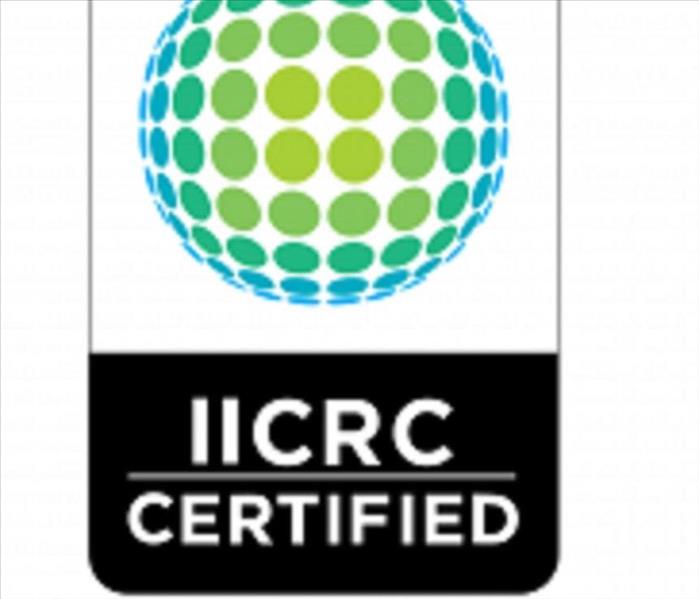 Fire And Water Damage Restoration Companies, Have Standards
Fire And Water Damage Restoration Companies, Have Standards
Fire and water damage restoration are essential services that protect families and their homes from severe issues. Whether it’s bad wiring, a flood, or a burst pipe, these professionals are capable of making the home safe to live in again. But getting it back to that state takes some real expertise and manpower, and it’s the kind of expertise that a certified firm can provide the best. There are serious health implications involved as well, so a homeowner wouldn’t want anyone else handling the job.
Why should a homeowner only consider a certified firm for fire and water damage restoration?
Floods and flames produce an immediate threat, and of course families are going to be pressed by the imminent danger, but these disasters can cause long-term problems as well. Pools of contaminated water, like those left behind by a storm or sewage backflow, are infested with a variety of pathogens and are also catalysts for explosive microbial growth. Molds, in particular, are common organisms found in the wake of contaminated moisture, and can take root in the home in as little as 48 hours if the problem is not dealt with by then. Mold is a significant concern, especially for families with young children, as it can cause lingering respiratory and behavioral complications. Mold can also spread quickly if it is given the chance to release airborne spores.
Flames leave behind a different kind of pest. Ash is a copious byproduct of burned out material, and it is both light and acidic. This means it can easily be swept up by air currents in the home and settle on a variety of items it can damage. If it is not cleaned up right away, it will begin etching glass, corroding metal, and discoloring drywall and porcelain. Ash can also irritate the throat, nose and lungs, inflaming conditions like asthma and allergies. This will happen over a matter of days, so a prompt response is required to stop it in its tracks.
Fire and water damage restoration firms are qualified to halt and reverse the spread of molds, ash, and other hazards. Given the time-sensitive nature of their work, reputable crews are normally available around the clock and can begin work immediately. A certified firm, one that has been trained by an organization like the Institute of Inspection, Cleaning and Restoration Certification (IICRC), will have the tools and methods needed to make the home safe to live in again. With proper training, professionals will be able to quickly establish a workspace inside the home, drain the excess water, and eliminate debris caused by the disaster. Over the next several days, they can set up equipment to expedite the drying process, saving any materials they can that have been exposed to water, or wash away ash residue, which has a tendency to get everywhere. These professionals can also inspect the building thoroughly for common trouble areas and confirm that there is no lingering moisture or ash hiding in wait.
By the time a certified firm has completed their work, the building will be transformed back to its original state, waiting for the family to settle back in and continue their lives.
11 Tips to Protect and Prevent Pipes from Freezing
11/24/2017 (Permalink)
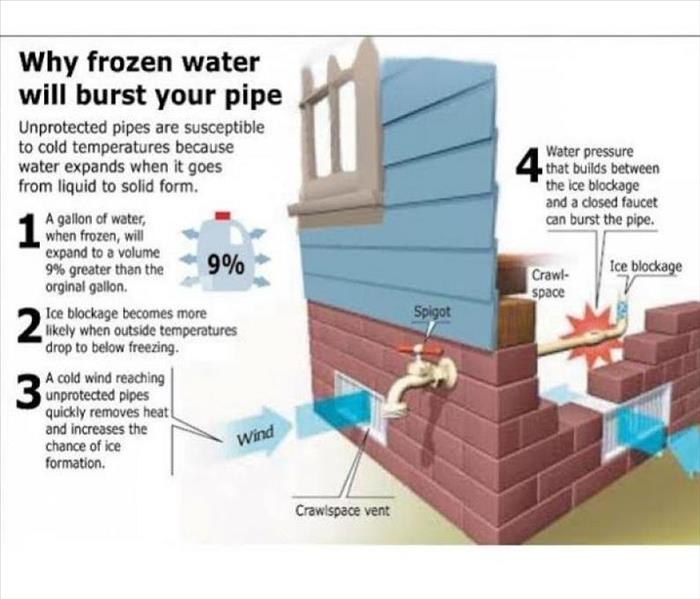 11 Tips to Protect and Prevent Pipes from Freezing
11 Tips to Protect and Prevent Pipes from Freezing
Why Pipe Freezing is a Problem
Water has a unique property in that it expands as it freezes. This expansion puts tremendous pressure on whatever is containing it, including metal or plastic pipes. No matter the strength of a container, expanding water can cause pipes to break.
Pipes that freeze most frequently are:
Pipes that are exposed to severe cold, like outdoor hose bibs, swimming pool supply lines, and water sprinkler lines.
Water supply pipes in unheated interior areas like basements and crawl spaces, attics, garages, or kitchen cabinets.
Pipes that run against exterior walls that have little or no insulation.
How to Protect Pipes From Freezing
Before the onset of cold weather, protect your pipes from freezing by following these recommendations:
Drain water from swimming pool and water sprinkler supply lines following manufacturer's or installer's directions. Do not put antifreeze in these lines unless directed. Antifreeze is environmentally harmful, and is dangerous to humans, pets, wildlife, and landscaping.
Remove, drain, and store hoses used outdoors. Close inside valves supplying outdoor hose bibs. Open the outside hose bibs to allow water to drain. Keep the outside valve open so that any water remaining in the pipe can expand without causing the pipe to break.
Add insulation to attics, basements and crawl spaces. Insulation will maintain higher temperatures in these areas.
Check around the home for other areas where water supply lines are located in unheated areas. Look in the garage, and under kitchen and bathroom cabinets. Both hot and cold water pipes in these areas should be insulated.
Consider installing specific products made to insulate water pipes like a "pipe sleeve" or installing UL-listed "heat tape," "heat cable," or similar materials on exposed water pipes.
Consider relocating exposed pipes to provide increased protection from freezing.
How to Prevent Frozen Pipes
Keep garage doors closed if there are water supply lines in the garage.
Open kitchen and bathroom cabinet doors to allow warmer air to circulate around the plumbing. Be sure to move any harmful cleaners and household chemicals up out of the reach of children.
When the weather is very cold outside, let the cold water drip from the faucet served by exposed pipes. Running water through the pipe - even at a trickle - helps prevent pipes from freezing.
Keep the thermostat set to the same temperature both during the day and at night. By temporarily suspending the use of lower nighttime temperatures, you may incur a higher heating bill, but you can prevent a much more costly repair job if pipes freeze and burst.
If you will be going away during cold weather, leave the heat on in your home, set to a temperature no lower than 55° F.
Do You Have an Evacuation Plan and Procedure
11/21/2017 (Permalink)
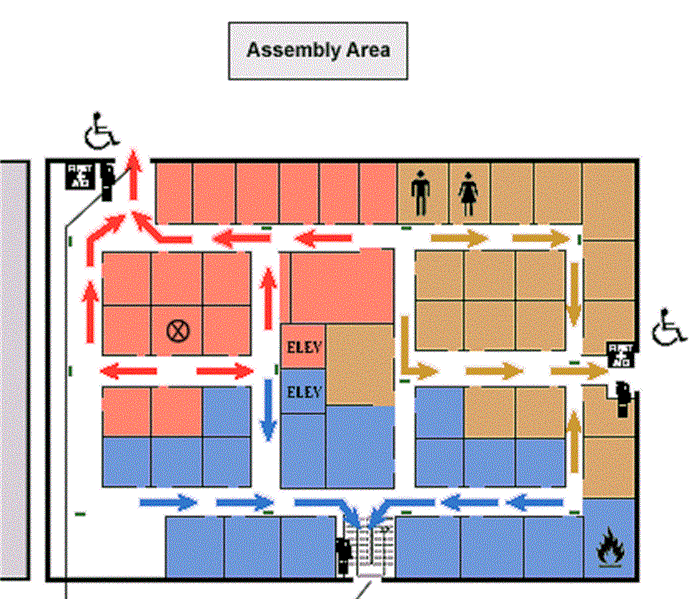 Do You Have an Evacuation Plan and Procedure
Do You Have an Evacuation Plan and Procedure
For smaller organizations, the plan does not need to be written and may be communicated orally if there are 10 or fewer employees. [29 CFR 1910.38(b)]
At a minimum, the plan must include but is not limited to the following elements [29 CFR 1910.38(c)]:
- Means of reporting fires and other emergencies
- Evacuation procedures and emergency escape route assignments
- Procedures for employees who remain to operate critical plant operations before they evacuate
- Accounting for all employees after an emergency evacuation has been completed
- Rescue and Medical Duties for Employees Performing Them
- Names or job titles of persons who can be contacted
Although they are not specifically required by OSHA, you may find it helpful to include the following in your plan:
- A description of the alarm system to be used to notify employees (including disabled employees) to evacuate and/or take other actions. The alarms used for different actions should be distinctive and might include horn blasts, sirens, or even public address systems.
- The site of an alternative communications center to be used in the event of a fire or explosion.
- A secure on- or offsite location to store originals or duplicate copies of accounting records, legal documents, your employees' emergency contact lists, and other essential records.
A floor plan shows the possible evacuation routes in the building. It is color coded and uses arrows to indicate the designated exit. A room containing hazardous materials is indicated in the lower right hand corner of the building by the flame symbol. The assembly area is indicated outside the primary exit at the top of the building.
An evacuation floor plan with three exits, has the primary exit designated in the upper left by red arrows, with two main flows coming toward it indicated by bent arrows, the red rooms, and red elevator. Persons in the upper left half of the building are directed toward this exit.
The secondary exit is located centrally on the adjacent outer wall on the right side of the building. Persons in the top hallway and second hallway are directed with tan arrows from the tan colored rooms toward this exit. A male and female figure (representing restrooms) are indicated in the first tan colored rooms in the upper hallway. The individuals should exit along the hallway toward the secondary exit at the right side of the building. Both the primary and secondary exits are marked with handicapped signs.
There is a third exit in the last hallway, centrally located in the outer wall opposite the outer wall with the primary exit and adjacent to the outer wall with the secondary exit. Persons in the third hallway are directed by blue arrows from the blue colored rooms and blue elevator to exit out this doorway. This exit is not designated for handicapped persons as stairs are indicated.
Colored boxes indicate a row of rooms along the outer walls, with hallways parallel to the rows of outer rooms on three sides of the building. The outer wall on the left side of the building has a hallway along the outer wall. Four sets of six colored rooms are along the internal corridors and there are three large rooms centrally located with internal hallways connecting the top and bottom of the building.
The Primary Exit is marked with an arrow from the text below the map, as is the Secondary Exit. An X inscribed in a circle marks the position of the employee, indicated in the legend, in text "You are here". On the floor plan, the employee is located in the upper left hand corner in the internal set of six red colored rooms, in the central room in the second hallway. The employee may exit the red colored room, either to the left or right (indicated by red arrows), and then proceed toward the outer wall and the upper left primary exit.
For more details visit the OSHA website:
https://www.osha.gov/SLTC/etools/evacuation/min_requirements.htm
Basement Water issues, Sump Pump, Water Damage in Haddonfield NJ, Detect and Prevent, Water damage in Mt. Laurel NJ,
10/6/2017 (Permalink)
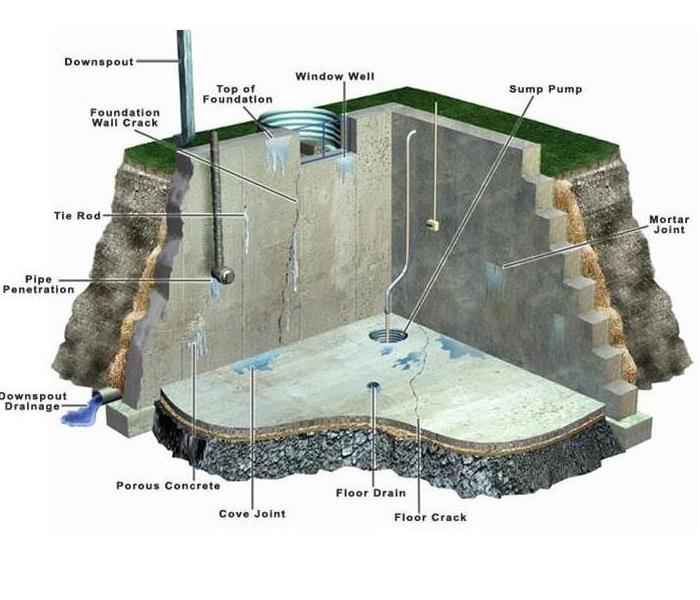 Basement Water issues, Sump Pump, Water Damage in Haddonfield NJ, Detect and Prevent, Water damage in Mt. Laurel NJ,
Basement Water issues, Sump Pump, Water Damage in Haddonfield NJ, Detect and Prevent, Water damage in Mt. Laurel NJ,
Standing water on the floor is easy to see. Less obvious signs of problems include:
Unexpected increases in your water bill
- Stains on walls, floors or ceilings
- Damaged or warped flooring
- Warped bottom panels in under-sink cabinets
- Peeling paint or wallpaper
- Corrosion on plumbing valves and fittings
Deal with problems as you find them. Clean up any water or moisture, locate the source and make repairs. Tracking down a leak isn't always straightforward — water can travel along components in the building structure, so the indications of the leak may be in a different part of the home than the leak itself. If necessary, contact a professional roofing contractor, plumber or water damage restoration specialist to help with identification and repair.
In addition to the damage that water causes, it can encourage the growth of mold on walls and floors — where it's readily visible — and in ductwork, attics and crawl spaces — where you might not notice it. A musty odor is a sign that mold may be present.
Mold can cause damage and lead to health problems — deal with it quickly. If the affected area is larger than 3 feet by 3 feet, the Environmental Protection Agency recommends you find a professional mold remediation contractor. For smaller areas, you can clean nonporous surfaces with commercial cleaning products, soap and water or a solution of a cup of bleach to each gallon of water. Follow the instructions and safety precautions for the cleaning product you use and wear appropriate safety gear. Porous surfaces such as drywall need to be replaced. For more information on mold in the home and how to clean it up, see A Brief Guide to Mold, Moisture, and Your Home on the EPA's web site.
Inspecting common sources of water leaks and taking some simple preventative measures can be an effective way to reduce the risk of water damage and mold.
Plumbing
- Every 6 to 12 months, inspect water lines, shut-off valves and fittings for fixtures such as sinks, toilets and tubs and for appliances such as washing machines, dishwashers and ice makers. Check for cracks, loose connections, kinks and corrosion. If you find a leak, turn off the water to the fixture or appliance until you can make repairs.
- Check around toilets to make sure water is not leaking at the base — an indication that the wax ring between the toilet and floor might need replacing or that there might be a crack in the base.
- If the temperature drops near the 20°F mark, allow faucets connected to vulnerable pipes — those not protected in insulated spaces — to drip. This helps minimize the risk of burst pipes by relieving pressure if the pipes freeze.
Appliances
- Replace washing machine supply hoses at least every five years. Consider using stainless-steel mesh hoses. Keep the machine properly balanced — over time, an unbalanced machine can move, pulling free the hose connections. Read Maintain Your Washer and Dryer for instructions on replacing hoses and balancing the washing machine.
- Consider turning off the water to the washing machine when it's not in use.
- Don't operate a dishwasher or washing machine while your house is unoccupied.
- Follow the manufacturer-specified maintenance for your appliances, including your water heater. Have the water heater inspected every couple of years.
Roof and Gutters
- Have your roof inspected every three years by a professional, but also check routinely for damage you can see from the ground — such as broken and missing shingles or damaged flashing. A poorly maintained roof can lead to leaks in the home and additional damage to the roof itself.
- If your roof doesn't have a drip edge or drip cap, consider having one added. This component helps keep water away from the roof deck and directs runoff into gutters.
- Keep gutters clear and well-maintained. Gutters that overflow, leak or don't drain properly allow water to seep into your roof and into your foundation, crawlspace or basement. See Gutter Cleaning and Repair for steps to keep your gutters working correctly.
- Make sure gutter downspouts direct rainwater away from the home's foundation. Use extensions to carry water at least 6 feet from the house.
Exterior Walls and Foundation
- Inspect the exterior of your home. Caulk around gaps at plumbing and ventilation entry and exit points. See How to Caulk for instructions. Repair cracked mortar joints.
- Check to see if roots from shrubs near your home have caused damage that can allow water to enter the foundation. You may need to remove shrubs that are close to the house to prevent problems. Roots can also damage and block in-ground pipes, causing leaks near the foundation and sewer backups in the home.
- Keep shrubbery beds and other landscape features sloped to direct water away from the home.
- Look for evidence of erosion or settling at the foundation that can indicate water problems.
Additional Tips to Avoid Water Damage
- Have your attic ventilation and insulation inspected annually and seal gaps that allow warm air into the attic — such as those around access doors and light fixtures. When warm air collects in the attic, it can lead to the formation of an ice dam — ice around the eaves that causes water from melting snow and ice to back up under the shingles and leak into your home.
- If you have a sump pump, test it several times during the year. Follow the manufacturer's maintenance instructions.
- Check your water pressure with a pressure gauge; typically these screw onto a hose bib. The pressure in an average home is around 50 to 70 pounds per square inch (psi). Higher pressure causes extra stress on pipes and fittings and can lead to leaks.
- Inspect tile and grout around showers and tubs. Make any necessary repairs. Read Replace a Broken Ceramic Tile and Repair Tile Grout for step-by-step instructions.
- Check for leaks around windows during rains and seal any you find.
- Use exhaust fans in the kitchen and bathroom to move excess moisture out of the house. Moisture in the air can condense on cool surfaces and cause problems. Read Controlling Moisture and Humidity in the Home for more ways to reduce indoor moisture.
- Locate your water shut-off valve so you can quickly turn off water to the home in an emergency. See Shut Off Your Home Water Supply for instructions on locating the valve.
9 Affordable Ways to Dry Up Your Wet Basement For Good, Water damage in Hadonfield NJ, Water damage in Mt. Laurel NJ,
10/2/2017 (Permalink)
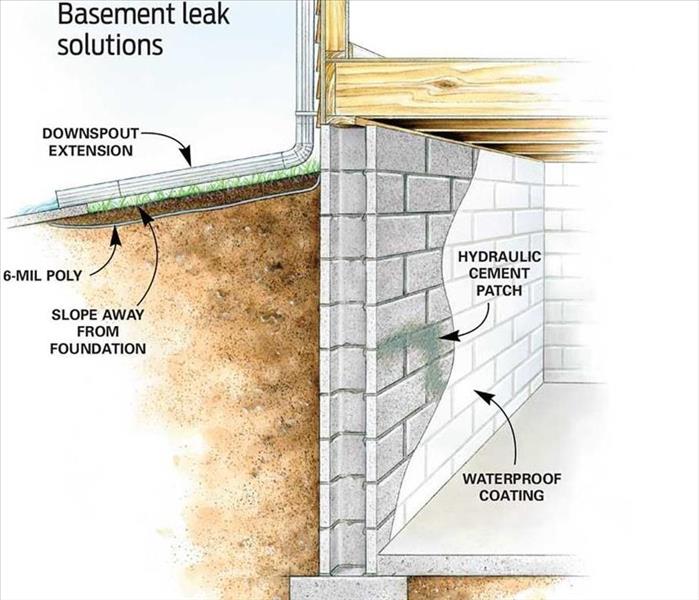 9 Affordable Ways to Dry Up Your Wet Basement For Good, Water damage in Hadonfield NJ, Water damage in Mt. Laurel NJ,
9 Affordable Ways to Dry Up Your Wet Basement For Good, Water damage in Hadonfield NJ, Water damage in Mt. Laurel NJ,
Diagnose the Water Problem
Water or moisture in basements comes from two sources. One source is indoor humidity that condenses on cold surfaces, much like water droplets form on a cold drink on a humid day. The other is water—or water vapor—that comes from outside. Rainwater, melting snow or groundwater can saturate the soil around your foundation and leak in. Water can leak through cracks, or it can penetrate porous concrete or masonry walls in the form of water vapor. To figure out what's causing the problem, tape aluminum foil to your basement wall and inspect it a few days later. Moisture on the outside surface of the foil indicates high indoor humidity. Moisture behind the foil means moisture is leaking through the walls.
Get Rid of Excess Humidity
Eliminating the sources of humid air will help dry out your basement. Seal leaky dryer vents with foil tape to prevent unwanted humid air from entering your basement. Don't just use duct tape; it'll eventually fall off. Add a vent fan to your basement bathroom and make sure your family turns it on during showers. Keep your basement windows closed during humid weather. And if you're still getting condensation on cool surfaces, run a dehumidifier to lower the indoor humidity.
Insulate Pipes
Condensation dripping from cold pipes can contribute to basement water problems. Cover cold water pipes with foam pipe insulation to stop condensation. The foam insulation is inexpensive and easy to cut with scissors.
Insulate Walls
Insulate exterior walls to prevent condensation. In cold climates, insulating basement walls also saves energy and reduces your heating bill. But don't cover the walls with insulation if water is leaking in from outside; you'll just create a potential mold problem.
Keep Water Away From the Foundation
If your basement leaks after heavy rains or after snow melts, making sure water is diverted away from your foundation may solve the problem. It's common for the soil alongside your house to settle over time, creating a moat that collects runoff and directs it down your foundation wall and into the basement. Lawn edging and gravel along the foundation can make things worse. Solve the problem by creating a 6-ft.-wide slope that drops about 4 in. away from the foundation. For extra insurance, cover the sloping soil with a layer of 6-mil poly. Then hide the poly with mulch, gravel or a layer of soil covered with grass. This will keep water from soaking in near the foundation.
Add Gutters and Extend Downspouts
If your basement leaks after it rains and you don't have gutters, consider adding them. Gutters catch the rain and channel it to the downspouts, which direct it away from the house. Whether you're installing new gutters or already have them, be sure the downspouts have 4- to 6-ft. horizontal extensions to move the water away from the house.
Plug Holes and Cracks in the Foundation
Holes and cracks in your foundation can let moisture and water seep into your basement. Plugging them probably won't solve basement leaks, but it'll help. Hydraulic cement works great for patching holes in a foundation because it can set up even under water, and it expands as it sets to seal the hole and lock the plug in place. Use a cold chisel or an angle grinder fitted with a masonry-cutting disc or diamond blade to enlarge the hole or crack into an inverted “V,” with the narrow part of the “V” on the surface of the wall. Then follow the package instructions for mixing and using the hydraulic cement.
Waterproof the Walls
Waterproofing materials that go on like paint fill the pores in the concrete or masonry walls and prevent water from leaking in. To be effective, these coatings must be applied to bare concrete or masonry walls. Start by removing loose material with a wire brush. Then clean off any white powdery “efflorescence” with masonry cleaner. Follow the safety and application instructions carefully. A common mistake when using masonry waterproofing products is to spread them too thin. The goal is to fill every pinhole to create a continuous waterproofing membrane. Brush the coating in all directions to completely fill every pinhole. Add a second coat after the first dries.
Install a Drainage System
The best permanent fix for chronic basement leaks is to install drainage tubing below the basement floor that's connected to a sump basket and pump. You can install a system like this yourself, but breaking out the concrete floor, burying the tubing, and patching the floor is a lot of backbreaking work. Materials to do an average basement will cost $600 to $1,000. Expect to spend $3,000 to $8,000 for a professionally installed system in a standard-size basement.
When to Replace Your Hot Water Heater, Water damage in Mt. Laurell NJ, Water Damage in Haddonfield NJ,
9/29/2017 (Permalink)
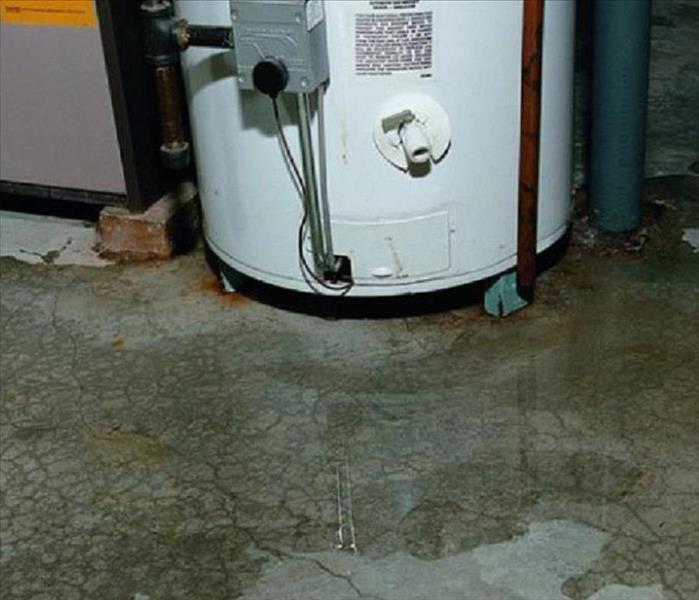 When to Replace Your Hot Water Heater, Water damage in Mt. Laurell NJ, Water Damage in Haddonfield NJ,
When to Replace Your Hot Water Heater, Water damage in Mt. Laurell NJ, Water Damage in Haddonfield NJ,
If your water heater is leaking or not heating up, you may be able to repair it rather than replace it. Regular maintenance will extend the life of your water heater. Some repairs, such as replacing a pressure-relief valve or heating element are pretty simple. Follow our tips to troubleshoot your gas or electric water heater issues and learn how long a water heater should last.
Safety First
Some water heater repairs are simple. However, if you aren't comfortable working with gas or electricity, always call a professional.
Repair or Replace
Based on the manufacturer's suggested service life, the life expectancy of a water heater is about 8 to 12 years. That varies with the location and design of the unit, quality of installation, maintenance schedule and water quality.
If your water heater is more than 10 years old, leaks around the base of the tank, and / or works erratically or not at all, it's probably time for replacement. However, before you begin the replacement process, make sure that an electrical problem, such as a blown fuse or tripped breaker, is not the reason for the unit's failure.
Troubleshooting Common Issues
Perhaps the most common problem connected with a water heater is water that isn't as hot as you want it to be. This is usually caused by a faulty thermostat or a defective heating element. Check the following when your water is not hot enough:
Electric water heater
- Make sure that the power is connected. Reset the thermostat.
- Flush the heater to remove sediment from the tank.
- Insulate the hot water pipes.
- Replace the heating element or thermostat.
- Raise the temperature setting on the thermostat.
Gas water heater
- Make sure that the gas is connected and the pilot light is lit.
- Flush the heater to remove sediment from the tank.
- Insulate the hot water pipes.
- Clean the gas burner and replace the thermocoupler (a safety device that shuts off the gas automatically if the pilot flame goes out).
- Raise the temperature setting on the thermostat.
Other common problems and possible solutions
- Hissing or sizzling noises: Sediment may have collected in the tank. Drain the tank until the water clears. Remove and soak elements in a pan filled with white vinegar for up to an hour and scrape off the collected scale.
- Leaking pressure-relief valve: Replace valve.
- Leaking water supply pipes: Tighten the fittings. If that doesn't work, shut off the water and replace the fittings.
Water Heater Maintenance
Today’s water heaters are manufactured to require little or no maintenance, but these maintenance tips could prolong the life of your water heater:
- Drain the water heater twice a year to rid it of collected sediment that causes corrosion. This also increases efficiency.
- Test the pressure-relief valve by lifting the valve’s handle and letting it snap back. This should release a burst of water into the overflow drainpipe. If it doesn’t, install a new valve.
- Lower the temperature setting on the thermostat to 120 degrees Fahrenheit. This reduces damage to the tank caused by overheating.
When Replacement Is Necessary
If you're replacing a water heater, you can replace it with the same type of unit. However, upgrade possibilities should be considered. For example, you may choose to increase or decrease the unit's holding capacity to accommodate a changing family. Or, you may opt to go tankless.
When looking for a water heater, consider these features:
- Gallon capacity (40-gallon and 50-gallon heaters are the most common)
- Recovery rate (the number of gallons the heater will heat in an hour)
- Dimensions (width and height — physical space may limit your ability to upgrade your unit's capacity; will the heater fit in the space you have for it?)
- Energy efficiency ratings (a sticker on the side should list the estimated annual cost of operation for the unit)
Before making repairs or purchasing a new water heater, check the nameplate on the side of your current unit. Here you will find helpful information including the tank capacity, insulation R-value, installation guidelines, working pressure, model and serial number. If you have an electric water heater, the nameplate will also list the wattage capacity and voltage of the heating elements.
- How will you dispose of your old water heater? Check local codes governing disposal of such appliances.
- Will you be able to physically handle the unit? Water heaters are bulky and heavy. You will need assistance.
- Do you have the tools necessary to do the job? Water heater installation requires adjustable wrenches, screwdrivers, a hacksaw and pliers. You may also need a propane torch if your installation uses copper pipe.
- Do you have time to do the job? Once you start replacing a water heater, you have to finish.
Caution
If you intend to convert from electric to gas or vice-versa, or if you don't feel comfortable doing the repair or maintenance work, hire a professional.
Caution
Make sure your home is equipped with carbon monoxide detectors when gas-powered appliances are present.
Why Is My Air Conditioner Leaking Water Inside My House, Water damage restoration in Haddonfield NJ, Water damage restoration in Mt. Laurel NJ,
9/22/2017 (Permalink)
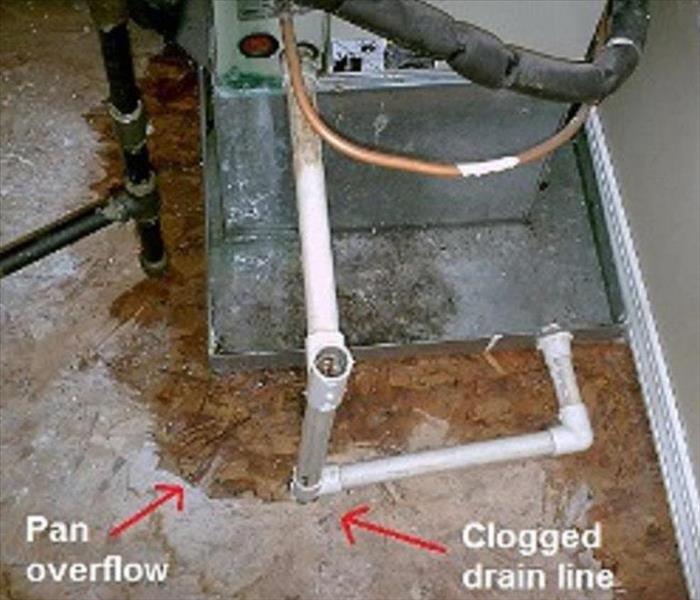 Why Is My Air Conditioner Leaking Water Inside My House, Water damage restoration in Cherry Hill NJ, Water damage restoration in Moorestown NJ,
Why Is My Air Conditioner Leaking Water Inside My House, Water damage restoration in Cherry Hill NJ, Water damage restoration in Moorestown NJ,
First, turn off your AC to prevent serious water damage and hazardous electrical issues. Next, we highly recommend calling a HVAC company for help.
Why water forms in an AC’s indoor unit
Condensation is a natural reaction that occurs inside all AC units.
You see, your AC’s job is to pull heat and humidity from the air inside your home. To do that, your system pulls in warm air through an indoor vent (called a return grille) and moves it across your inside unit’s cold evaporator coil to cool the air down.
When this happens, moisture forms on the evaporator coil. Just like the condensation that forms on a glass of ice cold water on a hot summer day.
Normally, the condensation on the coil drips into a drain pan and down a condensate drain pipe that leads it outside of your home (or into your plumbing system).
Now that you know why the condensation happens and the parts involved, here are a few common problems that can cause water to leak inside your house.
Clogged condensate drain line or rusted pan
If your drain line is clogged–commonly by dirt, algae, insects or a dirty evaporator coil–water drainage is limited; causing a buildup of water with nowhere to go other than your home.
And because it is so hot and humid, your AC runs more often so it doesn’t take long for large amounts of water to build up.
Also, the drain pan may be rusted through, allowing the water to fall through the pan and cause disastrous leaks and dangerous electrical issues inside your home. So, you’ll definitely need to replace the pan.
Improperly installed condensate trap
If your AC is fairly new, the problem could be with the way your system’s condensate trap was installed. An improperly designed condensate trap can block drainage and cause the drain pan to overflow with water.
What to do: You’ll need a professional to know what to look for in a condensate trap design and to see if it needs to be reinstalled.
Frozen evaporator coil
Condensation on your cold evaporator coil can also freeze. If it does, there’s a clear problem with your AC. It can even freeze all the way down the refrigerant lines to the outside unit.
And when it melts, there can be a lot of unwanted water in unwanted places throughout your home.
Common causes of a frozen coil include:
- Dirty air filter
- Low refrigerant
- An airflow problem
Other issues...
There are a number of problems that cause water leakage from your AC but these are a few of the most common. We understand this stuff can get pretty complicated.
Note: Depending on where the inside unit is and what specifically is causing water to leak inside your home, the damage could be pretty significant and extremely dangerous. Many, if not all, of these problems require a professional to ensure safety and proper resolution.
Contact a Certified Water Damage and Mold remediation company, to resolve any Microbial issues,
What to Do When Your Refrigerator Water Line Leaks, Water damage in Haddonfield NJ, Water damage in Mt. Laurel NJ,
9/21/2017 (Permalink)
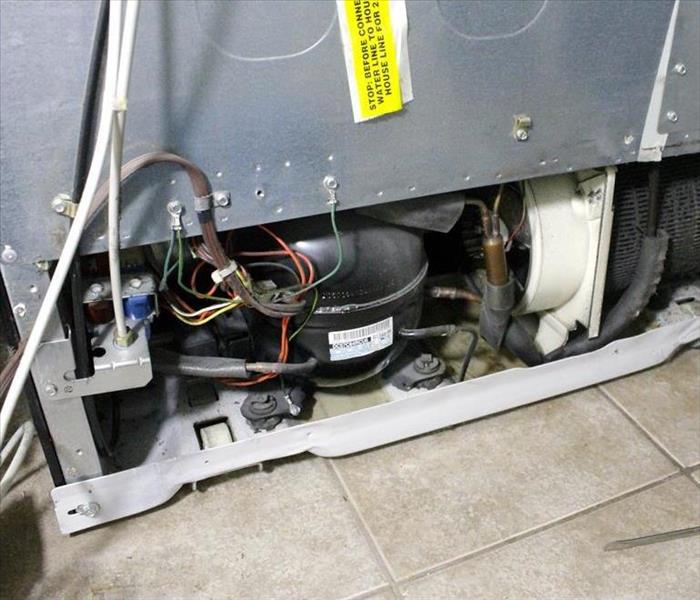 What to Do When Your Refrigerator Water Line Leaks, Water damage in Haddonfield NJ, Water damage in Mt. Laurel NJ,
What to Do When Your Refrigerator Water Line Leaks, Water damage in Haddonfield NJ, Water damage in Mt. Laurel NJ,
The refrigerator is one of the hardest working appliances around the home, so when one breaks down or suffers a leak, the experience can have consequences. If you find that your fridge’s water line has a leak, there are a few simple steps you can follow to troubleshoot the problem and have it running again in no time.
What To Do When Your Refrigerator Water Line Leaks
The first step is to identify the leak. The refrigerator water line connects the household water supply to a refrigerator with an ice maker or water dispenser. The water line typically runs at the back of the fridge. Once the leak has been identified, here is what you can do to fix the problem.
- Turn off the valve that supplies water to the refrigerator and then unplug the refrigerator to turn off the appliance. You will likely find the water shut off valve located beneath the kitchen sink or in some cases, behind the refrigerator itself.
- If the valve is located behind the fridge, carefully pull the appliance away from the wall and turn off the valve.
- You will now have to loosen the compression nut that secures the supply line to the water intake valve. This can be done with the assistance of an adjustable wrench by turning the nut counter clockwise and then disconnecting the supply line.
- Once loosened, remove the compression nut to disconnect the supply line from the valve.
- If the supply line is broken or torn in places, replace the old line with a new one making sure that its length and dimensions are the same as the original water line. Material choices range between copper, plastic and stainless steel water lines.
- To fix the new water line in place, thread one end of the supply line to the shut off valve under the sink and tighten until it is snug in place. When using a copper or plastic line, make sure to first slide on a compression nut secured with a compression sleeve or ring onto the end of the line. A stainless steel water line comes with a built in rubber gasket that stops the connection from leaking.
- Thread the other end of the supply line to the water intake valve and tighten it until snug.
- Turn on water and check for any leaks. If there is still a drip, tighten the nuts a bit more.
Purchasing a new water line
When the line is badly damaged and needs replacement there are a few things to keep in mind. For instance, one of the factors at this point would be to choose a line material that will offer durability and long lasting utility. Another is the price tag attached to the new purchase.
Plastic water lines
In terms of materials, plastic lines are the most cost effective but also least durable. The biggest threat lies in these lines cracking, clogging or leaking, causing water damage. While plastic lines may seem to work well in terms of flexibility, especially where space behind the fridge is tight, many people do not prefer this type of line material.
Copper water lines
Another option is to go with copper water lines that yield superior sturdiness but are also more prone to kinkiness. A more flexible version of copper lines is available to allow pushing the tubing into position giving it some flexibility to work well in cramped spaces.
Stainless steel water lines
As an alternative stainless steel braided lines can be considered. Braided steel is a tough, non-kinking option to the more pliable plastic and the ¼ in flexible copper lines. Stainless steel also happens to be the most durable option but will tend to be the most expensive as well.
Whether the leak in your refrigerator water line is caused by a plastic, copper or stainless steel water line, remember that you can always access the professional service of our experts at Tidal Wave in Atlanta to come and resolve all water damage concerns at your home.
Contact a Certified Water Damage Remediation company, for your Refrigerator Line Leaks, and water damage clean up,
Water Damage Restoration in Haddonfield NJ, Water damage restoration in Mt. Laurel NJ, Emergency Tips,
9/19/2017 (Permalink)
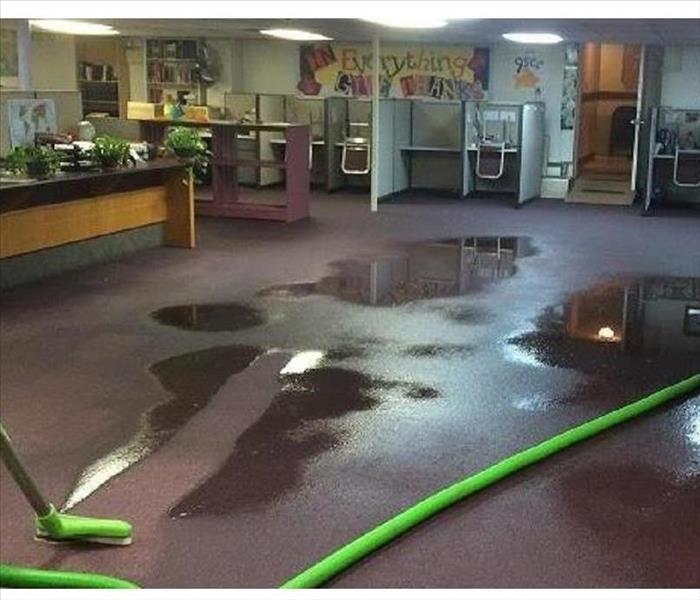 Water Damage Restoration in Haddonfield NJ, Water damage restoration in Mt. Laurel NJ, Emergency Tips,
Water Damage Restoration in Haddonfield NJ, Water damage restoration in Mt. Laurel NJ, Emergency Tips,
After any water damage situation, your primary focus should be safety:
- Is it safe to stay in the house?
- Electrical and "slip and fall" hazards are some of the most prevalent concerns.
- Only do activities that are safe for you to perform.
- Wet materials can be VERY heavy. Be careful!
What To Do After Flooding
- Remove excess water by mopping and blotting.
- Wipe excess water from wood furniture after removal of lamps and tabletop items.
- Remove and prop wet upholstery and cushions.
- Place aluminum foil or wood blocks between furniture legs and wet carpeting.
- Turn air conditioning on for maximum drying in summer.
- Remove colored rugs from wet carpeting.
- Remove art objects to a safe, dry place.
- Gather loose items from floors.
What NOT To Do After Flooding
- Don't leave wet fabrics in place. Hang furs and leather goods.
- Don't leave books, magazines or other colored items on wet carpet or floors.
- Don't use your household vacuum to remove water.
- Don't use television or other household appliances.
- Don't turn on ceiling fixtures if ceiling is wet, and keep out of rooms where ceilings are sagging.
Then Call a Certified Water Damage Restoration Contractor, for Proper Drying, Dehumidifying, Possible Demolition and Clean Up!
Water Damage in Haddonfield NJ, Water Damage in Cherry Hill NJ, and The SERVPRO Emergency READY Profile Advantage, FREE SAMPLE PROFILE, PDF Document,
9/13/2017 (Permalink)
As many as 50% of businesses close down following a disaster, according to the latest research. Of the businesses that survive, the overwhelming majority of them had a preparedness plan in place. Pre-planning can serve as an insurance policy aimed at peace of mind. And knowing you are "Ready for whatever happens" speaks trust to your clients and employees that in the event your business is affected by a disaster, they don’t necessarily have to be.
By developing a SERVPRO Emergency READY Profile for your business, you minimize business interruption by having an immediate plan of action. Knowing what to do and what to expect in advance is the key to timely mitigation and can help minimize how water and fire damage can affect your business.
- A no cost assessment of your facility.
- This means there is no need to allocate funds, giving you a great value at no cost.
- A concise Profile Document that contains only the critical information needed in the event of an emergency.
- It will only take a little time to complete and will not take you away from current projects. But it will save a lot of time if ever needed.
- A guide to help you get back into your building following a disaster.
- This can help minimize the amount of time your business is inactive by having an immediate plan of action.
- Establishes your local SERVPRO Franchise Professional as your disaster mitigation and restoration provider.
- You have a provider that is recognized as an industry leader and close by.
- Identification of the line of command for authorizing work to begin.
- This saves time so we can begin the work of mitigating the damage which can save you time and money.
- Provides facility details such as shut-off valve locations, priority areas and priority contact information.
- Having a quick reference of what to do, how to do it and who to call provides solutions in advance of an emergency so that during the emergency you are "Ready for whatever happens."
Our SERVPRO location can Email you a Sample Copy, of an Emergency Ready Profile!
Another Satisfied SERVPRO customer, Awesome Thank you Email, in attached pictures,
9/8/2017 (Permalink)
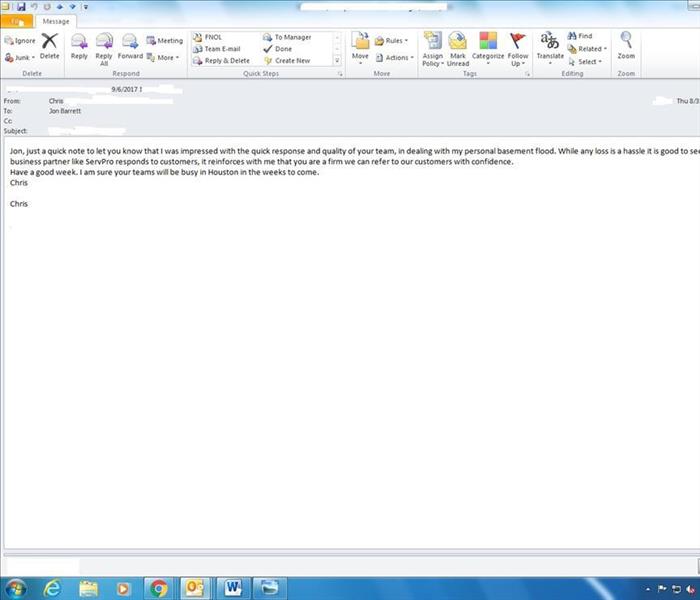 Another Satisfied SERVPRO customer, Awesome Thank you Email, in attached pictures,
Another Satisfied SERVPRO customer, Awesome Thank you Email, in attached pictures,
Another Satisfied SERVPRO customer, Awesome Thank you Email, in attached pictures,
Water Damage in Haddonfield NJ, Commercial Water damage in Mt. Laurel NJ, Water damage in Haddonfield NJ, SERVPRO Checklist,
9/7/2017 (Permalink)
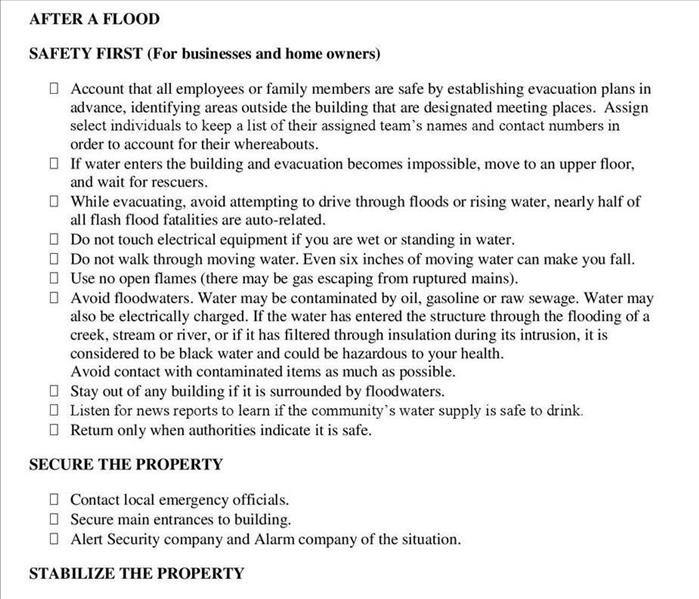 Water Damage in Haddonfield NJ, Commercial Water damage in Mt. Laurel NJ, Water damage in Haddonfield NJ, SERVPRO Checklist,
Water Damage in Haddonfield NJ, Commercial Water damage in Mt. Laurel NJ, Water damage in Haddonfield NJ, SERVPRO Checklist,
Water Damage in Haddonfield NJ, Commercial Water damage in Mt. Laurel NJ, Water damage in Haddonfield NJ, SERVPRO Checklist,
A Fast Response Is Crucial
In many cleaning and restoration situations, immediate action is needed. With over 1,700 U.S. and Canadian Franchise locations, SERVPRO is strategically positioned to be faster to any size emergency.
An immediate response helps to minimize the damage and the cleaning and restoration costs.
Water is particularly invasive, quickly spreading throughout your property and being absorbed into floors, walls, furniture, etc. SERVPRO Franchise Professionals arrive quickly and start the water extraction process almost immediately.
Water Damage Timeline
Within Minutes:
- Water quickly spreads throughout your property, saturating everything in its path.
- Water is absorbed into walls, floors, upholstery, and belongings.
- Furniture finishes may bleed, causing permanent staining on carpets.
- Photographs, books, and other paper goods start to swell and warp.
Hours 1 - 24:
- Drywall begins to swell and break down.
- Metal surfaces begin to tarnish.
- Furniture begins to swell and crack.
- Dyes and inks from cloth and paper goods spread and stain.
- A musty odor appears.
48 Hours to 1 Week:
- Mold and mildew may grow and spread.
- Doors, windows, and studs swell and warp.
- Metal begins to rust and corrode.
- Furniture warps and shows signs of mold.
- Paint begins to blister.
- Wood flooring swells and warps.
- Serious biohazard contamination is possible.
More Than 1 Week:
- Restoration time and cost increase dramatically; replacing contaminated materials and structural rebuilding may be extensive.
- Structural safety, mold growth, and biohazard contaminants pose serious risks to occupants.
9 Affordable Ways to Dry Up Your Wet Basement For Good, Water damage in Cherry Hill NJ, Water damage in Moorestown NJ,
8/28/2017 (Permalink)
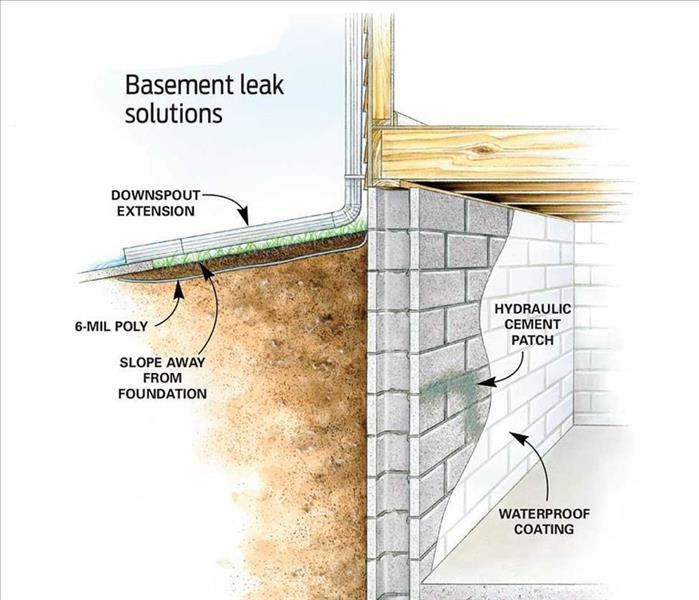 9 Affordable Ways to Dry Up Your Wet Basement For Good, Water damage in Cherry Hill NJ, Water damage in Moorestown NJ,
9 Affordable Ways to Dry Up Your Wet Basement For Good, Water damage in Cherry Hill NJ, Water damage in Moorestown NJ,
9 Affordable Ways to Dry Up Your Wet Basement For Good, Water damage in Cherry Hill NJ, Water damage in Moorestown NJ,
Diagnose the Water Problem
Water or moisture in basements comes from two sources. One source is indoor humidity that condenses on cold surfaces, much like water droplets form on a cold drink on a humid day. The other is water—or water vapor—that comes from outside. Rainwater, melting snow or groundwater can saturate the soil around your foundation and leak in. Water can leak through cracks, or it can penetrate porous concrete or masonry walls in the form of water vapor. To figure out what's causing the problem, tape aluminum foil to your basement wall and inspect it a few days later. Moisture on the outside surface of the foil indicates high indoor humidity. Moisture behind the foil means moisture is leaking through the walls.
Get Rid of Excess Humidity
Eliminating the sources of humid air will help dry out your basement. Seal leaky dryer vents with foil tape to prevent unwanted humid air from entering your basement. Don't just use duct tape; it'll eventually fall off. Add a vent fan to your basement bathroom and make sure your family turns it on during showers. Keep your basement windows closed during humid weather. And if you're still getting condensation on cool surfaces, run a dehumidifier to lower the indoor humidity.
Insulate Pipes
Condensation dripping from cold pipes can contribute to basement water problems. Cover cold water pipes with foam pipe insulation to stop condensation. The foam insulation is inexpensive and easy to cut with scissors.
Insulate Walls
Insulate exterior walls to prevent condensation. In cold climates, insulating basement walls also saves energy and reduces your heating bill. But don't cover the walls with insulation if water is leaking in from outside; you'll just create a potential mold problem.
Keep Water Away From the Foundation
If your basement leaks after heavy rains or after snow melts, making sure water is diverted away from your foundation may solve the problem. It's common for the soil alongside your house to settle over time, creating a moat that collects runoff and directs it down your foundation wall and into the basement. Lawn edging and gravel along the foundation can make things worse. Solve the problem by creating a 6-ft.-wide slope that drops about 4 in. away from the foundation. For extra insurance, cover the sloping soil with a layer of 6-mil poly. Then hide the poly with mulch, gravel or a layer of soil covered with grass. This will keep water from soaking in near the foundation.
Add Gutters and Extend Downspouts
If your basement leaks after it rains and you don't have gutters, consider adding them. Gutters catch the rain and channel it to the downspouts, which direct it away from the house. Whether you're installing new gutters or already have them, be sure the downspouts have 4- to 6-ft. horizontal extensions to move the water away from the house.
Plug Holes and Cracks in the Foundation
Holes and cracks in your foundation can let moisture and water seep into your basement. Plugging them probably won't solve basement leaks, but it'll help. Hydraulic cement works great for patching holes in a foundation because it can set up even under water, and it expands as it sets to seal the hole and lock the plug in place. Use a cold chisel or an angle grinder fitted with a masonry-cutting disc or diamond blade to enlarge the hole or crack into an inverted “V,” with the narrow part of the “V” on the surface of the wall. Then follow the package instructions for mixing and using the hydraulic cement.
Waterproof the Walls
Waterproofing materials that go on like paint fill the pores in the concrete or masonry walls and prevent water from leaking in. To be effective, these coatings must be applied to bare concrete or masonry walls. Start by removing loose material with a wire brush. Then clean off any white powdery “efflorescence” with masonry cleaner. Follow the safety and application instructions carefully. A common mistake when using masonry waterproofing products is to spread them too thin. The goal is to fill every pinhole to create a continuous waterproofing membrane. Brush the coating in all directions to completely fill every pinhole. Add a second coat after the first dries.
Install a Drainage System
The best permanent fix for chronic basement leaks is to install drainage tubing below the basement floor that's connected to a sump basket and pump. You can install a system like this yourself, but breaking out the concrete floor, burying the tubing, and patching the floor is a lot of backbreaking work. Materials to do an average basement will cost $600 to $1,000. Expect to spend $3,000 to $8,000 for a professionally installed system in a standard-size basement.
Overlooking Mitigating Water Leak Risks, Water Damage in Cherry Hill NJ, Flood Damage in Cherry Hill NJ,
8/23/2017 (Permalink)
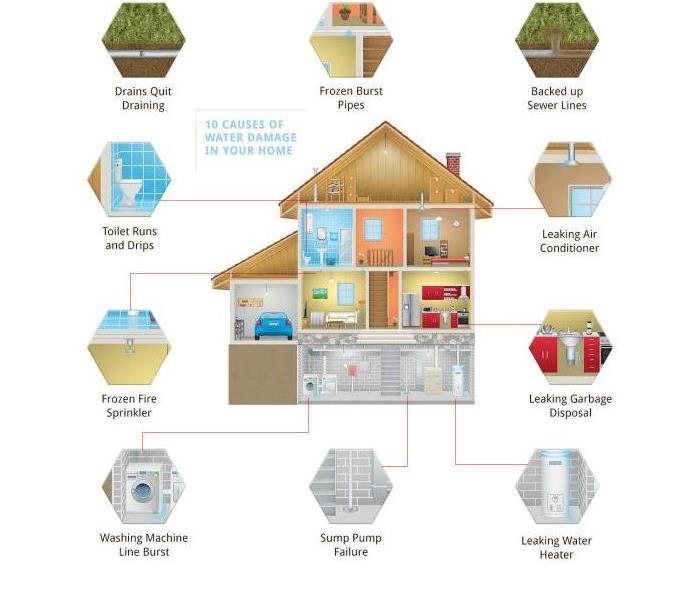 Overlooking Mitigating Water Leak Risks, Water Damage in Cherry Hill NJ, Flood Damage in Cherry Hill NJ,
Overlooking Mitigating Water Leak Risks, Water Damage in Cherry Hill NJ, Flood Damage in Cherry Hill NJ,
Overlooking Mitigating Water Leak Risks, Water Damage in Cherry Hill NJ, Flood Damage in Cherry Hill NJ,
The majority of homeowners do not view internal water leak damage as the most concerning home threat, despite the fact that water leaks are a more frequent risk than fire and theft.
Nearly 80 percent of homeowners overlook threat of costly water leaks while on vacation, the survey found.
Instances of water damage have been rising dramatically. In the past 10 years, the frequency of sudden pipe bursts has nearly doubled. In 2015, water damage accounted for nearly half of all property damage, according to the Insurance Information Institute. An online survey of 1,200 homeowners finds that just 8 percent of homeowners correctly identify August as the month with the most water leak events, and when subsequently heading out on a late-summer vacation, just 22 percent shut off the water main (despite 88 percent knowing where it is located within their home).
While homeowners are particularly vulnerable during the summer travel season, the study finds many face year-round water exposures. For instance, despite the fact that 91 percent of homeowners rate themselves as “vigilant” or “doing an okay job” at preventative home maintenance, and that close to half (45 percent) have or know someone who has experienced a water leak in the past two years, only 18 percent have installed a water leak detection device.
Of all homeowners, high-net-worth individuals are particularly at risk. When compared against other income segments, for instance, high-net-worth individuals are the most likely (55 percent) to report being “vigilant” about conducting preventative maintenance, yet are the least likely (26 percent) to rank internal water leaks as their top home-related concern. High-net-worth homeowners are also the income group least likely to periodically inspect appliance hoses (33 percent compared to 61 percent of middle class homeowners, the most of any income group), a frequent cause of internal water leaks. The adoption of certain preventative home maintenance devices, including fire, carbon monoxide and security systems, is standard practice among the majority of all homeowners, regardless of income, as they address what are perceived to be the most common property risks, But internal water leaks are a leading cause of property damage. With 57 percent of homeowners who have experienced a water leak claim in the past two years spending $5,000 or more on clean up and repair costs — and 15 percent spending $20,000 or more — many are overlooking their exposure at a significant cost.
- The majority of homeowners (63 percent) cite the threat of relocating for an extended period of time (between one month and a year) as their first or second most potentially concerning water damage-related event. With the window for a quick restoration closing just 72 hours after a leak, extended relocation is a real possibility homeowners must contend with.
- A quarter of all homeowners have never had their appliances inspected, despite being the surest way to prevent a leak from occurring.
- Many homeowners also cited the loss of irreplaceable items (59 percent) and repairing structural damage (46 percent) as the top most potentially concerning water damage-related events.
- The majority of homeowners are unfamiliar with the most common sources of internal water leaks, with close to half (49 percent) identifying the water heater as the most likely source (independent analyses indicate plumbing supply systems pose the greatest risk)
Water Damage in Moorestown NJ, Water damage can be deceptive, Flood Damage in Haddonfield NJ,
8/21/2017 (Permalink)
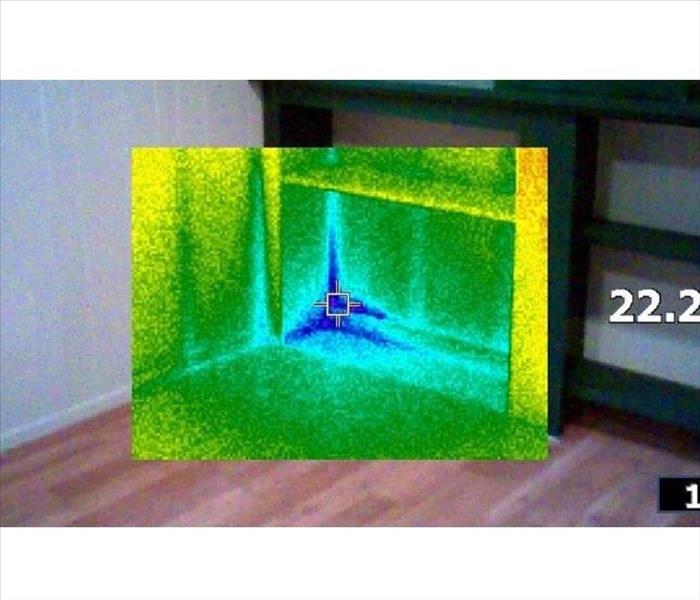 Water Damage in Moorestown NJ, Water damage can be deceptive, Flood Damage in Haddonfield NJ,
Water Damage in Moorestown NJ, Water damage can be deceptive, Flood Damage in Haddonfield NJ,
Water Damage in Moorestown NJ, Water damage can be deceptive, Flood Damage in Haddonfield NJ,
Water damage can be deceptive. Water penetrates into structural cavities creating trapped pockets of saturation. The detection of water in these areas can often only be discovered with sophisticated moisture detection meters.
Undetected moisture will continue to cause damage. This damage, at a minimum, will cause odors. Greater damage will surface when materials delaminate, shrink, split and further deteriorate to where costly repairs are required.
More than just removing excess water, IICRC-certified restorers have the knowledge and equipment to further dry a home or facility (including substructure materials) completely back to preloss conditions. Through timely response and the careful monitoring of water damage, mold and other health issues can be prevented. If water damage has been present too long, mold will occur.
All IICRC-certified professionals have the training and experience to identify moisture sources, evaluate mold growth (visible or suspected), contain damage, remove contamination and dry materials to ensure that mold will not return.
While there are many methods for drying structural components and contents, the “in-place” drying system has been taught in the industry and used by drying contractors since the early ’80s. In those days, this method of drying components, without significant removal of furnishings or fixtures, was somewhat restricted, due to limitations imposed by extraction, evaporation and dehumidification equipment. In recent years, however, drying technology (extraction, evaporation, dehumidification), along with better understanding of psychrometry, has advanced in major ways so that in-place drying has, in some cases, become far more safe and practical.
Investigating and Diagnosing Moisture Problems in Your Property, Water damage in Haddonfield NJ, Water damage in Mt. Laurel NJ,
8/11/2017 (Permalink)
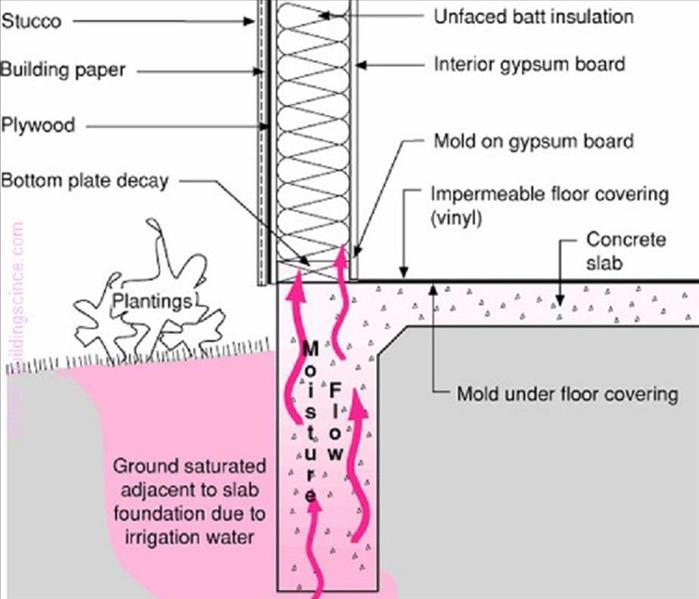 Investigating and Diagnosing Moisture Problems in Your Property, Water damage in Haddonfield NJ, Water damage in Mt. Laurel NJ,
Investigating and Diagnosing Moisture Problems in Your Property, Water damage in Haddonfield NJ, Water damage in Mt. Laurel NJ,
Investigating and Diagnosing Moisture Problems in Your Property, Water damage in Haddonfield NJ, Water damage in Mt. Laurel NJ,
Water comes in four forms: solid, liquid, vapor and adsorbed. All four forms can cause grief to building owners, designers and contractors. When water causes building problems investigating and diagnosing the problem can be challenging because water constantly changes its form inside a building and within its materials. The investigator must hunt down the water thinking like water.
Introduction
Water is supposed to be easy to understand. It only comes in four forms or states. And the rules governing water movement are straightforward:
- Water runs downhill due to gravity.
- Air carrying water vapor goes from areas of higher air pressure to areas of lower air pressure.
- Water in the vapor form diffuses from warm to cold driven by the thermal gradient.
- Water in the vapor form diffuses from more to less driven by the concentration gradient.
- Ok, not always straightforward:
- Water in a porous material diffuses on pore surfaces from more to less along the concentration gradient in the form of adsorbed water. When there is a lot of it and it fills the pores it is sometimes referred to as capillary water. In this way it can move upwards against the force of gravity – or sideways long distances. Just remember that porous materials “suck” and you’ll be ok.
Water always changes its behavior, because its form is never constant. Evaporation, condensation, capillary suction, gravitational flow, vapor diffusion and mass flow of moist air are all happening at the same time inside building cavities and inside materials.
Water plays clever tricks on us by changing forms and methods of movement along its flow path. It’s devious and treacherous and laughs at us simple-minded humans whenever it can get away with it. We have to fight it by knowing its tricks. We’ll begin with some simple stuff – diagnosing and finding rain leaks. Then we’ll get into some clever tricks water can play on us.
Rain, Rain Go Away…
Rain falls out of the sky, mostly straight down. Sometimes the wind smacks it against the walls. Diagnosing rainwater leaks is not that complicated. If things get wet after a rain, it’s probably the rain. Start at the wet spot and work backwards and upwards. This gravity thing is pretty predictable. Now, there is a catch – water likes to stick to things and it can run horizontally quite a long ways because nothing is ever completely flat. And that pesky wind can blow it uphill a ways – sometimes over things that are an inch or two high – like sills, flashings and ledges.
The best time to diagnose rainwater leaks is when it is raining. Duh. And unless you are superman and can see into walls, you should be prepared to make lots of holes to see inside of assemblies. Now, it doesn’t always rain when you are asked to look. So you can make your own rain when you need to. A garden hose works real well. Consultants get embarrassed when they charge lots of money while using a garden hose so they use a spray rack instead to make it seem more “technical” and “scientific.” But a leak is a leak whether the water comes from a hose or a calibrated spray rack spraying calibrated water at a calibrated air pressure. In fairness to consultants, standardized tests can come in real handy once you know the flow path and you want to know if the leaking windowyou found meets industry standards. Just remember to be “gentle” when you use a hose – you don’t want the momentum of the water spray forcing water into the building. The secret is misting the surface and letting gravity do the dirty deed. So fire hoses are out.
Sometimes a building only leaks rainwater when it is windy. And there isn’t always wind around when you need it – like when you are on-site looking for the leak. So make your own wind. Instead of blowing against the building from the outside, suck air out of the building from the inside to simulate wind driven rain. Turn off the supply air, and crank up the exhaust. You should probably only do this with adult supervision, but you get the picture.
Most of the time rainwater leaks are straightforward to diagnose, but sometimes finding moisture due to rainfall is not such an obvious process.
Clever Water Tricks I – The Old Rain on the Brick Sun Trick
Up to now, the story has been pretty simple. Let’s complicate it by splashing rainwater on a brick veneer. Brick is a sponge. Brick wicks water into itself because it is porous. The mortar in the joints between bricks is also a sponge. Mortar wicks water into itself because it is porous. There are also cracks between the brick and the mortar. These cracks are also “pores” and they also wick water. Remember, porous materials suck. Think of a brick veneer as a moisture reservoir that is filled during a rainstorm. So now we have this wet sponge on the outside of your building. The sun comes out. The sun beats down on the wet brick on the southwest side and makes the water in the brick hot. How hot? Probably 120 degrees F? Let’s go to the psychometric chart. Find where 120 degrees F crosses the saturation curve (100 percent RH). Hey, we’re off the chart. We have to go to the steam tables. Wow. Any guesses what direction the water in the brick wants to go? Did I mention the building this brick veneer is enclosing is air-conditioned?
The brick is wetter than the rest of the wall and wetter than the inside. The brick is hotter than the rest of the wall and hotter than the inside. The water in the brick is driven inwards out of the brick into the airspace where it turns into a vapor. Some of the water also goes to the outside, because the brick is also wetter and hotter than the outside. But let’s go back to the airspace behind the brick. It’s not likely that the airspace is free from mortar droppings and vented at the bottom and at the top so that ventilation air can flush the water vapor driven into the airspace out of the brick to the outside. Even if the cavity is clean it’s rarely vented. It may be drained, but it is seldom vented – at least not by design – although it should always be. It may be vented accidentally – and this accidental venting saves a lot of buildings. It seems that we are more often lucky rather than smart.
So inwards goes the water vapor, traveling along the temperature gradient and along the concentration gradient. How far it travels depends on what’s in its way. If it runs into something impermeable like foam sheathing or a rubber membrane on the backside of the cavity behind the brick veneer, the vapor won’t travel far. If it hits foam sheathing or a rubber membrane the vapor condenses, turns back into a liquid and runs down the back side of the airspace, hopefully to a flashing where it is directed out of the wall to the outside.
But what happens if it runs into a building paper or a housewrap that breathes? The heat driven vapor blows through it like a hot knife through butter. What is the building paper or housewrap installed over? Probably a gypsum sheathing – highly permeable to vapor. So vapor diffuses right through it. Next comes fiberglass cavity insulation, which can’t stop the vapor – it’s permeable too. The vapor goes all the way in until it hits the plastic vapor barrier. Not a good idea to put a plastic vapor barrier on the inside of a brick veneer wall that sees rain and sun. The vapor condenses on the plastic vapor barrier and runs down the wall to sit in the bottom plate track. Now we have a full range of problems to choose from: corrosion, mold, odors or staining. You can get the same effect by installing a vinyl wall covering rather than the plastic vapor barrier. Just ask the hotel industry about this practice.
Water Removal and Water Extraction, Water damage in Cherry Hill NJ, Water damage in Moorestown NJ,
8/9/2017 (Permalink)
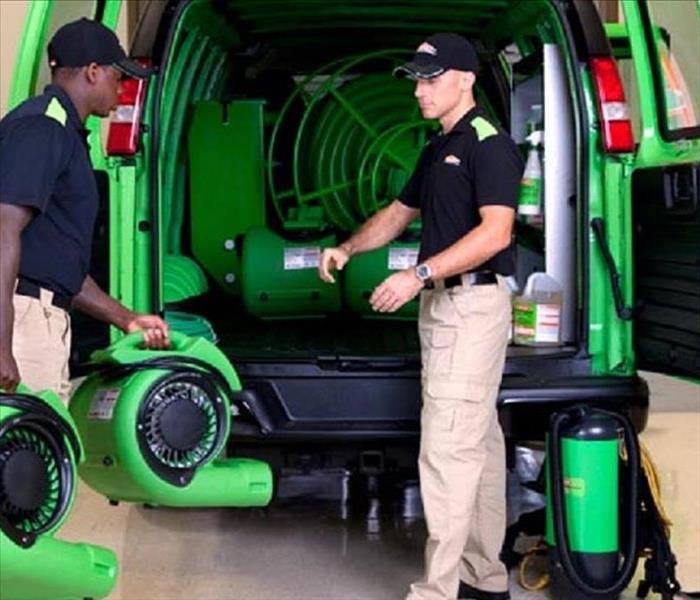 Water Removal and Water Extraction, Water damage in Cherry Hill NJ, Water damage in Moorestown NJ,
Water Removal and Water Extraction, Water damage in Cherry Hill NJ, Water damage in Moorestown NJ,
The water damage restoration process begins with a detailed inspection of your property, including a damage assessment. The SERVPRO Franchise Professional is determining the scope of the damage so he or she can develop an appropriate plan of action. Being careful and cautious is also a Priority. Also, Making sure electrical items, Appliances, and Outlets are Not a Hazard.
They Identify and Stop the Water Source
They check for the source of water in your home and business and stop it. The water source must be stopped before the drying process can begin.
- Stop the Source
- Check for Contaminated Water
They Identify the Type of Water
SERVPRO Franchise Professionals must identify the category and classification of water to restore your property safely to industry specifications. The type of water contamination will affect the specific restoration processes used to restore your property.
- White / Category 1 Water
- Gray / Category 2 Water
- Black / Category 3 Water
They Survey the Extent of the Water Damage and Inspect the Premises
They inspect and test your home to discover the extent of the damage. Additionally, they will look for safety concerns and explain them to you. If you are aware of any safety issues, such as asbestos or lead, please share them.
- Survey Damage
- Complete Safety Inspection
They Move or Block Furniture
They move furniture and property contents and block items to help prevent rust or furniture stains on wet carpet.
The water extraction step removes the majority of the water from your home or property. By performing a thorough water extraction, SERVPRO Franchise Professionals help reduce the drying time and help to prevent mold and secondary water damage. They use powerful pumps and truck-mounted vacuum units to quickly remove hundreds or thousands of gallons of water from your property.
Move-Out / Pack-Out
If your home requires extensive restoration or cleaning, SERVPRO Franchise Professionals can conduct an organized, efficient move-out to protect your belongings from further damage.
Emergency Water Removal
Highly trained technicians will begin the water removal process almost immediately. Depending on the amount of water, they may use powerful submersible pumps in addition to industrial strength, wet/dry vacuums. This step helps to reduce drying time and helps to prevent mold and secondary water damage.
- Remove Excess Water
- Use Submersible Pumps and Industrial Wet/Dry Vacuums
Inspect the Carpet Pad and Carpet
SERVPRO Franchise Professionals inspect the carpet and pad and determine if it should be removed to protect the subfloor.
- Inspect Carpet Pad and Remove If Needed
- Inspect Carpet and Remove If Needed
Water Removal Equipment
- Moisture detectors, hygrometers, and other meters measure the extent of moisture saturation.
- Infrared cameras may be used to find “hidden” water behind walls and ceilings.
- Submersible and gas-powered pumps are used for continuous pumping of high-level water.
- Truck-mounted and portable extraction units perform efficient water removal.
Water damage in Collingswood NJ, Types of Moisture Meters, to Understand Moisture Content in Substrates, Water damage in Audubon NJ,
8/1/2017 (Permalink)
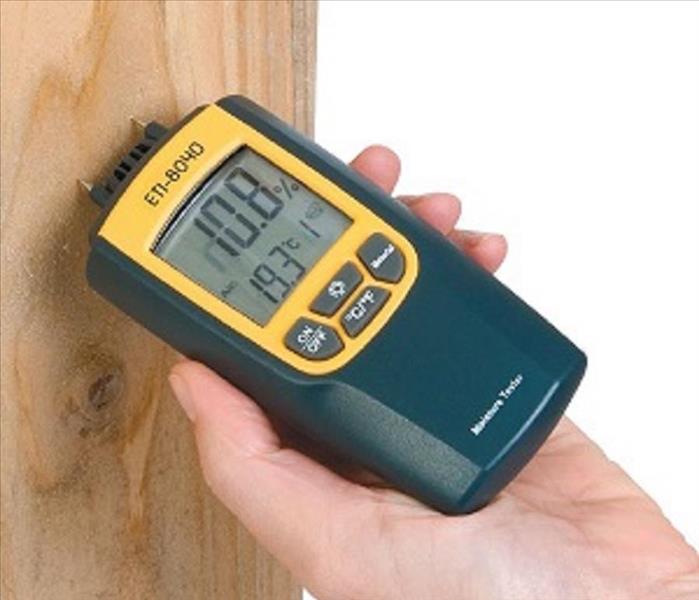 Water damage in Collingswood NJ, Types of Moisture Meters, to Understand Moisture Content in Substrates, Water damage in Audubon NJ,
Water damage in Collingswood NJ, Types of Moisture Meters, to Understand Moisture Content in Substrates, Water damage in Audubon NJ,
A moisture meter is an essential instrument used in many industries to detect moisture content in materials. Home and building inspectors rely on moisture meters to identify potential problems and damage to structures from moisture buildup. Woodworking industries, such as furniture makers, use wood moisture meters to insure a quality product. Flooring contractors use moisture meters to determine ideal conditions when installing a floor over a concrete slab or subfloor.
Indicator scales on moisture meters can vary in appearance, but all will indicate moisture content in percent (%MC). While some moisture meters offer an analog scale, others read %MC digitally. The accuracy of the %MC readings, as well as the appropriate substrate scales, vary per meter and can vary by brand and type.
Most moisture meters are calibrated to wood, which provides a relatively accurate reading in wood moisture content. Typically, this scale ranges in the 5 to 40% range. When testing the moisture content in non-wood materials, such as concrete, a relative scale of 0 to 100 is often used, where 0 is bone dry and 100 is saturated. This is a relative scale. Moisture meters include visual LED indicators related to the percent reading on the scale for dry, moderate and saturated or wet readings. Additionally, some meters also offer a third scale for readings of gypsum. These scale readings can range from 0.2 to 50% moisture content. When selecting a moisture meter for sheetrock, it is advised that a moisture meter that offers a scale reading for gypsum be used.
Color indicators on moisture meters are helpful in determining whether the material being tested is considered dry or if there is a potential problem with moisture. The green (dry), yellow (moderate) and red (high) indicators typically identify where on the scale of %MC the readings occur. This can clear up confusion where one interprets a %MC as dry versus one that is moderate and may require more thorough investigation to determine if a problem with moisture in the material exists, especially if a visible sign of moisture does not exist.
Types of Moisture Meters
There are three common types of moisture meters used for the inspection of building and structure materials: pin-type, pinless and pin/pinless/all-in-one. All three types of moisture meters offer specialized purpose and are unique to the end user's application in determining %MC in materials.
Pin-Type Moisture Meter
The first of the three types of moisture meters is the pin type. Pin-type moisture meters measure %MC at the depth of the head of the contact pins. Pin-type moisture meters have two pins on the instrument, which are used to penetrate into the test surface at a desired depth. The reading of %MC is determined by measuring the electrical resistance between the tips of the two pins. This method of inserting pins into a surface is often viewed as an invasive process for measuring %MC. Typically these moisture meters will read up to 5/16" depth.
Pin-type moisture meters use the principle of electrical resistance to measure the moisture content in materials by measuring the conductivity between the pins. The tips of the pins are relatively sharp, uninsulated and penetrate into the surface for a sub-surface reading. With pin-type meters, you can also obtain a reading by touching the pins to the surface for testing. Most pin-type moisture meters use a scale calibrated to wood, however this does not mean that the meter cannot be used to measure moisture in other substrates and materials. This type of moisture meter can also be used for, but is not limited to, concrete, drywall, ceiling tiles and painted surfaces. When using the wood scale on a pin-type moisture meter, the %MC reading can range from 5% to 40% in moisture content. Generally, the low end of this reading falls into the 5 to 12% range, the moderate range will be 15 to 17%, and the high or saturated range will read above 17%. Scales for MC% ranges are provided in the instrument instructions and should be consulted concerning measuring ranges for particular surface materials.
Pin-type moisture meters are useful in measuring %MC in wood flooring, drywall, painted surfaces (such as the exterior of the home), carpeting, ceiling tile and cement. A pin-type moisture meter is the best way to identify the exact location of moisture buildup. A pin-type meter uses two pins that penetrate into the test surface at the users desired depth. When insulated contact pins are used, only the uncoated tips are exposed, providing an accurate reading of moisture content at various levels of penetration. Pin-type meters are the only instruments that allow the inspector to identify exact location of moisture at a given point. Using a pin-type meter is an effective way to determine the difference between shell and core moisture content. In some cases, the depth of the reading exceeds the length of the pin on the meter. If this is the case, many meters are equipped with a connection option to add accessory probes that can be inserted further into a substrate for more accurate core or depth detection. An example would be for Exterior Insulated Finish Systems (EIFS) testing.
Pinless Moisture Meter
Pinless or noninvasive moisture meters operate on the principle of electrical impedance.
This meter provides a nondestructive measurement of moisture in wood and other substrates, such as concrete and gypsum. A noninvasive moisture meter may also be called a nondestructive or a pinless moisture meter. Scales on these meters are similar to that of pin-type meters, where the wood scale reads %MC at 5 to 30%, and nonwood materials' %MC is read on a relative scale of 0 to 100%.
Pinless moisture meters are commonly used to determine moisture content on a relative scale of 0-100% in concrete subfloors and flooring prior to laying a wood floor or other decorative flooring surface. Other common uses for a pinless moisture meter for identifying possible moisture buildup behind bathroom/shower tiles, under vinyl flooring and other finished surfaces, as well as to determine if water-borne finishes are adequately dry prior to second application.
Pinless moisture meters are capable of reading up to a typical depth of 3/4" or 1" into a subsurface. These are useful for detecting problem moisture buildup where visual indicators are nonexistent.
Pin/Pinless/All-in-One Moisture Meter
A third and possibly more useful moisture meter would be a pin/pinless/all-in-one moisture meter. This type of moisture meter utilizes both methods for measuring %MC in surfaces. Because this type of meter offers the option to measure moisture content in substrates using both methods of reading moisture, one meter may be able to identify problem areas and then also be used to pinpoint the exact location where moisture damage or buildup is occurring. Essentially, this type of meter would utilize the same scales of %MC for wood and nonwood substrates and allow the end user the versatility necessary for a full inspection in determining areas where moisture is an issue.
Ideally, due to its diversity, this type of meter could be utilized by the flooring specialist, IAQ specialist, general contractor and home/building inspector.
Accessories for Additional Monitoring Capability
Generally, pin-type and pinless moisture meters will provide moisture readings limited in depth. However, in some applications, readings of moisture deeper than 5/16" are necessary. In cases where depth measurements exceed that of a typical moisture meter, it is good to consider a meter that will accept an attachment for EIFS, deep penetration or remote testing.For deep penetration, long-insulated contact pins may be used to obtain a moisture content measurement taken at depth. Holes may need to be drilled into the surface for testing and then the extra-deep pins will be inserted into the pre-drilled holes and MC% measurement will be taken at the tip of the pins where they are not insulated. Insulating all but the tips of these pins will avoid a false moisture content reading and provide a more accurate reading just at the depth where the tips of the pins are exposed.
In order to obtain a depth without drilling holes into the surface, a hammer probe can be used to measure moisture content in wood at different levels of penetration by inserting a long pin into a wood surface for up to 1-1/2" depth readings. Hammer probes are ideal for shell and core tests to detect moisture gradients and to test lumber with wet surfaces.
Moisture problems in EIFS are typically found within stucco surfaces and stem from poor sealant application around window and door frames or are a result of faulty flashing installation. EIFS probes are used to test for %MC within these structures. An example of an insulated EIFS Probe for this specialized application is shown here:
EIFS Probe
Other applications may require measuring %MC on surfaces that are out of reach or in a relatively inaccessible area, such as under sinks or in ventilation areas. If this is the case, then using a pin-type moisture meter attachment may come in handy so the reading can still be obtained on the meter while the measurement is being taken at the source. Not all meters offer attachment ports for remote testing, EIFS testing or deep penetration. Typically this is an optional feature built into the model of moisture meter.
Water damage in Haddonfield NJ, top 10 causes of Water damage in your Property, water damage in Mt. Laurel NJ,
7/26/2017 (Permalink)
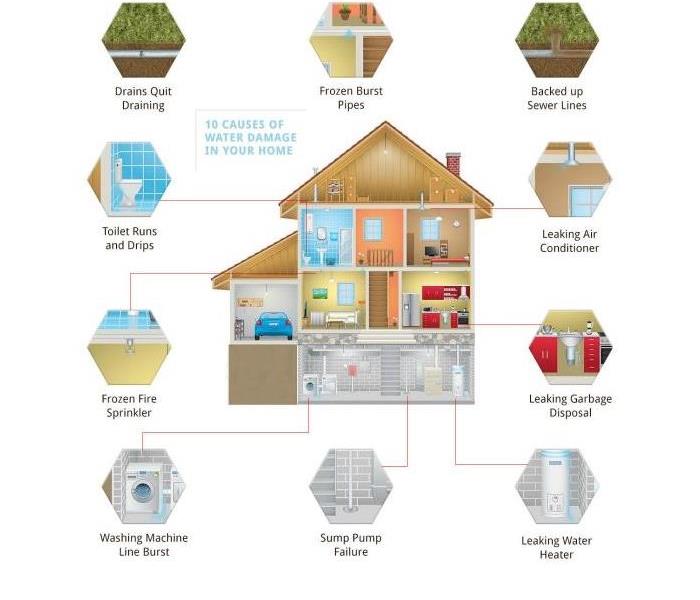 Water damage in Haddonfield NJ, top 10 causes of Water damage in your Property, water damage in Mt. Laurel NJ,
Water damage in Haddonfield NJ, top 10 causes of Water damage in your Property, water damage in Mt. Laurel NJ,
TOP 10 CAUSES OF WATER DAMAGE IN YOUR PROPERTY!
Sewage Damage, Water damage, Fire Damage, Smoke Damage, Water damage, Crime Scene Cleaning, Soot Damage, Biohazard cleaning, Camden, NJ, Woodbury, NJ, Deptford, NJ, Cherry Hill NJ, SERVPRO, Esporta Cleaning, sewage cleaning, fire damage, fire cleaning,
Old plumbing and leaky appliances around the house aren’t out to get you, but sometimes it seems that way. The weather plays a part too with winter freezes that burst pipes and spring rains that flood basements.Our cleanup and restoration teams have seen it all here in Chicago and the surrounding suburbs. In our experience, these are the 10 most common causes of residential water damage that can affect your home. Our list also includes helpful links and tips on how to handle each type of wet disaster.
1. The Toilet Runs and Drips
When it constantly runs, it’s annoying and expensive. When it springs a bad leak, it can ruin floors and walls. The trick to fixing a leaky toilet is figuring out why it’s turned into a water hazard. Once you pinpoint the problem, repairs are usually simple and inexpensive.
2. Pressure Gets to the Washing Machine
Your washing machine quickly fills with water because its supply lines are under constant pressure. Older rubber or PVC lines wear out and rupture, and that failure turns the laundry room into a flood zone. Avoid this potential mess by replacing old lines with braided stainless steel.
3. Your Garbage Disposal Floods Cabinets
Most disposal leaks are DIY fixable, but when this appliance stops working, it can go out with a splash. As the body of the unit gets old, it springs leaks around the bottom housing and floods cabinets with a dirty mix of food garbage and water. When this happens, you need to replace the disposal.
4. Your AC Soaks the Ceiling
The AC pulls humidity out of the air and condenses moisture into the unit’s overflow pan so that water travels outside through the condensate line. This drainage system quits working if the pan is damaged or the line is clogged. The results are soggy insulation and soaked ceilings.
5. The Water Heater Develops Leaks
This appliance is often located in basements, and that can make cleanup even more challenging after a bad leak. Sometimes, a water heater problem is due to condensation, but it’s more likely a faulty water outlet or drain valve. Older units can develop leaks in the bottom of the tank and flood the entire basement.
6. Frigid Temperatures Burst Pipes
This water emergency is confined to cold months, but you have to be prepared. Pipes can freeze and rupture in just a few hours, and the flooding can soak the house from ceiling to basement. Always check and insulate your plumbing before the Chicago winter settles in.
7. Fire Sprinkler Systems Freeze Too
High-rises, condos and newer homes feature these life-saving systems, but residential fire sprinklers are prone to freezing without proper winter maintenance. Cold-weather sprinkler routines keep the family safe and help avoid water damage from ruptured pipes.
8. The Sump Pump Stops Pumping
Whether it’s caused by heavy rain or appliance failure, water in the basement is a disaster when the sump pump stops working. You have to deal with water removal, thoroughly dry everything and address mold and mildew growth. It’s often best to let professionals handle basement flooding.
9. Drains Quit Draining
This simple outlet can complicate an ordinary day by leaving standing water in a tub, the kitchen sink or the basement. A stopped-up tub or sink is a big nuisance, but a clogged floor drain can result in a basement filled with water. Your DIY solutions range from drain snakes to air blasters.
10. Sewer Lines Back Up
Don’t try to handle this problem by yourself. Backed-up sewer lines are caused by blockage or heavy rainfall, and they quickly spread dangerous contaminants that create a very unhealthy environment. Sewage backup and flooding should always be taken care of by certified professionals.
Storm Damage in Cherry Hill NJ, Saharan Air Layer, Water damage in Haddonfield NJ, Roof Damage in Cherry Hill NJ,
7/25/2017 (Permalink)
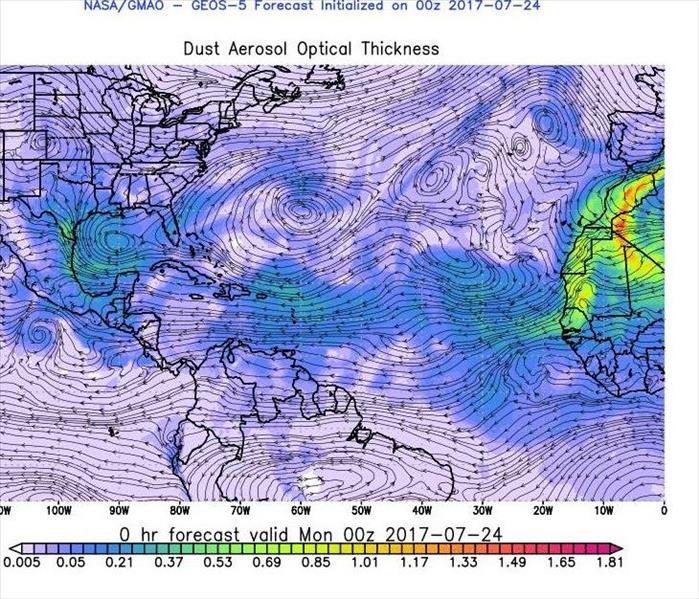 Storm Damage in Cherry Hill NJ, Saharan Air Layer, Water damage in Haddonfield NJ, Roof Damage in Cherry Hill NJ,
Storm Damage in Cherry Hill NJ, Saharan Air Layer, Water damage in Haddonfield NJ, Roof Damage in Cherry Hill NJ,
The Saharan Air Layer (SAL) is an extremely hot, dry and sometimes dust-laden layer of the atmosphere that often overlies the cooler, more-humid surface air of the Atlantic Ocean. In the Sahara Desert region of North Africa, where it originates, it is the prevalent atmosphere, extending from the surface upwards several kilometers. As it drives, or is driven, out over the ocean, it is lifted above the denser marine air. This arrangement is an inversion where the temperature increases with height. The boundary between the SAL and the marine layer suppresses or "caps" any convection originating in the marine layer. Since it is dry air, the lapse rate within the SAL itself is steep, that is, the temperature falls rapidly with height.
Disturbances such as large thunderstorm complexes over North Africa periodically result in vast dust and sand storms, some of which extend as high as 6,000 meters. These can be driven out to sea within the SAL as far west as North America.
In the case of Africa, winds blow twenty percent of dust from a Saharan storm out over the Atlantic Ocean, and twenty percent of that, or four percent of a single storm's dust, reaches all the way to the western Atlantic. The remainder settles out into the ocean or washes out of the air with rainfall. Scientists think that the July 2000 measurements made in Puerto Rico, nearly 8 million tonnes, equaled about one-fifth of the total year's dust deposits.
The SAL passes over the Canary Islands where the phenomenon is named "Calima" and manifests as a fog that reduces visibility and deposits a layer of dust over everything.
These clouds of dust are visible in satellite photos as a milky white to gray shade, similar to haze.
Findings to date indicate that the iron-rich dust particles that often occur within the SAL reflect solar radiation, thus cooling the atmosphere. The particles also reduce the amount of sunlight reaching the ocean, thus reducing the amount of heating of the ocean. They also tend to increase condensation as they drift into the marine layer below, but not precipitation as the drops formed are too small to fall and tend not to readily coelesce. These tiny drops are subsequently more easily evaporated as they move into drier air laterally or dry air mixes down from the SAL aloft. Research on aerosols also shows that the presence of small particles in air tends to suppress winds. The SAL has also been observed to suppress the development and intensifying of tropical cyclones, which may be related directly to these factors.
Water Damage in Haddonfield NJ, Flood Damage in Haddonfield NJ, Water Damage in Haddonfield NJ,
6/22/2017 (Permalink)
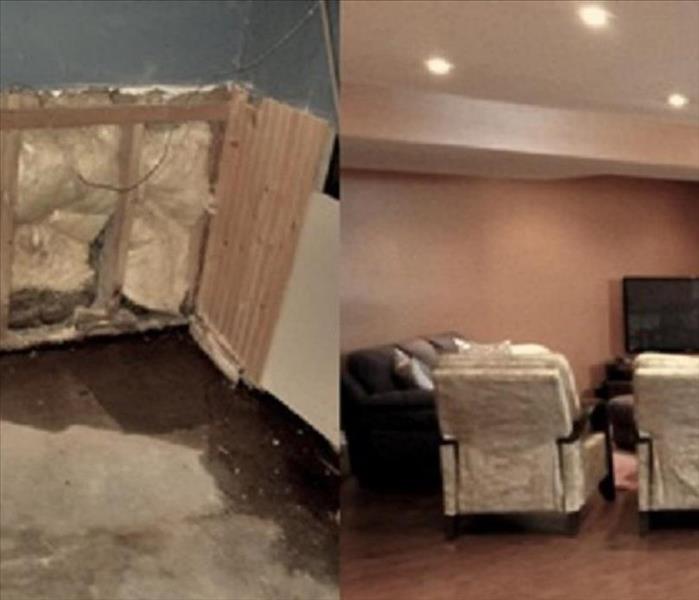 Water Damage in Haddonfield NJ, Flood Damage in Haddonfield NJ,
Water Damage in Haddonfield NJ, Flood Damage in Haddonfield NJ,
Water Damage in Haddonfield NJ, Flood Damage in Haddonfield NJ, Water Damage in Haddonfield NJ,
Water damage describes a large number of possible losses caused by water intruding where it will enable attack of a material or system by destructive processes such as rotting of wood, growth, rusting of steel, de-laminating of materials such as plywood, and many others.
The damage may be imperceptibly slow and minor such as water spots that could eventually mar a surface, or it may be instantaneous and catastrophic such as flooding. However fast it occurs, water damage is a major contributor to loss of property.
An insurance policy may or may not cover the costs associated with water damage and the process of water damage restoration. While a common cause of residential water damage is often the failure of a sump pump, many homeowner's insurance policies do not cover the associated costs without an addendum which adds to the monthly premium of the policy. Often the verbiage of this addendum is similar to "Sewer and Drain Coverage".
Those individuals who are affected by wide scale flooding may have the ability to apply for government and FEMA grants through the Individual Assistance program. On a larger level, businesses, cities, and communities can apply to the FEMA Public Assistance program for funds to assist after a large flood. For example, the city of Fond du Lac Wisconsin received $1.2 million FEMA grant after flooding in June 2008. The program allows the city to purchase the water damaged properties, demolish the structures, and turn the properties into public green space.
Causes
Water damage can originate by different sources such as a broken dishwasher hose, a washing machine overflow, a dishwasher leakage, broken/leaking pipes, and clogged toilets. According to the Environmental Protection Agency, 13.7% of all water used in the home today can be attributed to plumbing leaks.[3] On average that is approximately 10,000 gallons of water per year wasted by leaks for each US home. A tiny, 1/8-inch crack in a pipe can release up to 250 gallons of water a day.[4]According to Claims Magazine in August 2000, broken water pipes ranked second to hurricanes in terms of both the number of homes damaged and the amount of claims (on average $50,000 per insurance claim costs in the US. Experts suggest that homeowners inspect and replace worn pipe fittings and hose connections to all household appliances that use water at least once a year. This includes washing machines, dishwashers, kitchen sinks and bathroom lavatories, refrigerator ice makers, water softeners and humidifiers. A few US companies offer whole-house leak protection systems utilizing flow-based technologies. A number of insurance companies offer policy holders reduced rates for installing a whole-house leak protection system.
As far as insurance coverage is concerned, most damage caused by bad weather is considered flood damage and normally is not covered under homeowners insurance. Coverage for bad weather would usually require flood insurance.
Categories
Category 1 Water - Refers to a source of water that does not pose substantial threat to humans and classified as "clean water". Examples are broken water supply lines, tub or sink overflows or appliance malfunctions that involves water supply lines.
Category 2 Water - Refers to a source of water that contains a significant degree of chemical, biological or physical contaminants and causes discomfort or sickness when consumed or even exposed to. Known as "grey water". This type carries micro organisms and nutrients of micro organisms. Examples are toilet bowls with urine (no feces), sump pump failures, seepage due to hydrostatic failure and water discharge from dishwashers or washing machines.
Category 3 Water - Known as "black water" and is grossly unsanitary. This water contains unsanitary agents, harmful bacteria and fungi, causing severe discomfort or sickness. Type 3 category are contaminated water sources that affects the indoor environment. This category includes water sources from sewage, seawater, rising water from rivers or streams, ground surface water or standing water. Category 2 Water or Grey Water that is not promptly removed from the structure and or have remained stagnant may be re classified as Category 3 Water. Toilet back flows that originates from beyond the toilet trap is considered black water contamination regardless of visible content or color.
Classes
Class of water damage is determined by the probable rate of evaporation based on the type of materials affected, or wet, in the room or space that was flooded. Determining the class of water damage is an important first step, and will determine the amount and type of equipment utilized to dry-down the structure.[7]
Class 1 - Slow Rate of Evaporation. Affects only a portion of a room. Materials have a low permeance/porosity. Minimum moisture is absorbed by the materials.
Class 2 - Fast Rate of Evaporation. Water affects the entire room of carpet and cushion. May have wicked up the walls, but not more than 24 inches.
Class 3 - Fastest Rate of Evaporation. Water generally comes from overhead, affecting the entire area; walls, ceilings, insulation, carpet, cushion, etc.
Class 4 - Specialty Drying Situations. Involves materials with a very low permeance/porosity, such as hardwood floors, concrete, crawlspaces, plaster, etc. Drying generally requires very low specific humidity to accomplish drying.
Restoration
See also: Convectant drying
Different removal methods and measures are used depending on the category of water. Due to the destructive nature of water, chosen restoration methods also depend heavily on the amount of water, and on the amount of time the water has remained stagnant. For example, as long as carpet has not been wet for longer than 48 hours, and the water involved was not sewage based, a carpet can usually be saved; however, if the water has soaked for longer, then the carpet is probably irreparable and will have to be replaced.[8] Water damage restoration can be performed by property management teams, building maintenance personnel, or by the homeowners themselves; however, contacting a certified professional water damage restoration specialist is often regarded as the safest way to restore water damaged property.
Standards and regulation
While there are currently no government regulations in the United States dictating procedures, two certifying bodies, the Institute of Inspection Cleaning and Restoration Certification (IICRC) and the RIA, do recommend standards of care. The IICRC-recommended standard is IICRC S500.
Fire and Water Restoration companies are regulated by the appropriate state's Department of Consumer Affairs - usually the state contractors license board. In California, all Fire and Water Restoration companies must register with the California Contractors State License Board.[10] Presently, the California Contractors State License Board has no specific classification for "water and fire damage restoration."
Procedures
Water damage restoration is often prefaced by a loss assessment and evaluation of affected materials. The damaged area is inspected with water sensing equipment such as probes and other infrared tools in order to determine the source of the damage and possible extent of area affected. Restoration services would then be rendered to the residence in order to dry the structure, sanitize any affected or cross contaminated areas, and deodorize all affected areas and materials. After the labor is completed, water damage equipment including air movers, air scrubbers, dehumidifiers, wood floor drying systems, and sub floor drying equipment is left in the residence. Industry standards state that drying vendors should return at regular time intervals, preferably every twenty-four hours, to monitor the equipment, temperature, humidity, and moisture content of the affected walls and contents.
Water Damage in Haddonfield NJ, Water damage can be deceptive, Flood Damage in Haddonfield NJ,
6/21/2017 (Permalink)
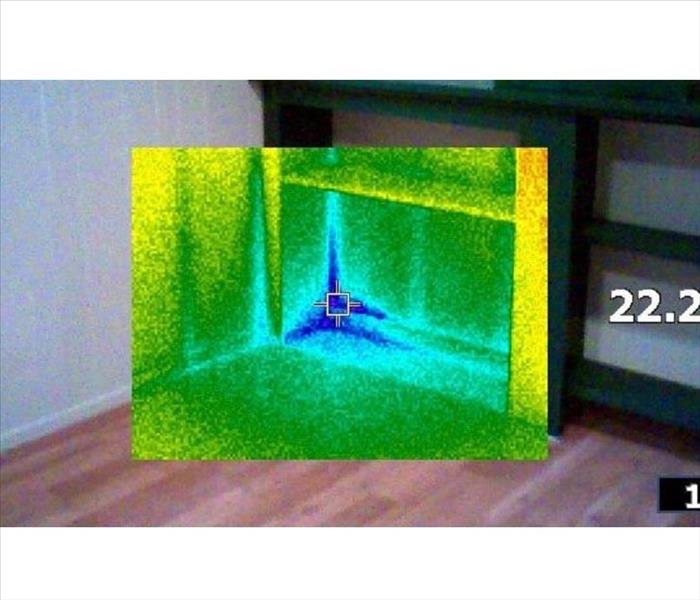 Water Damage in Haddonfield NJ, Water damage can be deceptive, Flood Damage in Haddonfield NJ,
Water Damage in Haddonfield NJ, Water damage can be deceptive, Flood Damage in Haddonfield NJ,
Water Damage in Haddonfield NJ, Water damage can be deceptive, Flood Damage in Haddonfield NJ,
Water damage can be deceptive. Water penetrates into structural cavities creating trapped pockets of saturation. The detection of water in these areas can often only be discovered with sophisticated moisture detection meters.
Undetected moisture will continue to cause damage. This damage, at a minimum, will cause odors. Greater damage will surface when materials delaminate, shrink, split and further deteriorate to where costly repairs are required.
More than just removing excess water, IICRC-certified restorers have the knowledge and equipment to further dry a home or facility (including substructure materials) completely back to preloss conditions. Through timely response and the careful monitoring of water damage, mold and other health issues can be prevented. If water damage has been present too long, mold will occur.
All IICRC-certified professionals have the training and experience to identify moisture sources, evaluate mold growth (visible or suspected), contain damage, remove contamination and dry materials to ensure that mold will not return.
While there are many methods for drying structural components and contents, the “in-place” drying system has been taught in the industry and used by drying contractors since the early ’80s. In those days, this method of drying components, without significant removal of furnishings or fixtures, was somewhat restricted, due to limitations imposed by extraction, evaporation and dehumidification equipment. In recent years, however, drying technology (extraction, evaporation, dehumidification), along with better understanding of psychrometry, has advanced in major ways so that in-place drying has, in some cases, become far more safe and practical.
Flood Damage in Haddonfield NJ, What to Do in the First 24 Hours After a Flood,
6/16/2017 (Permalink)
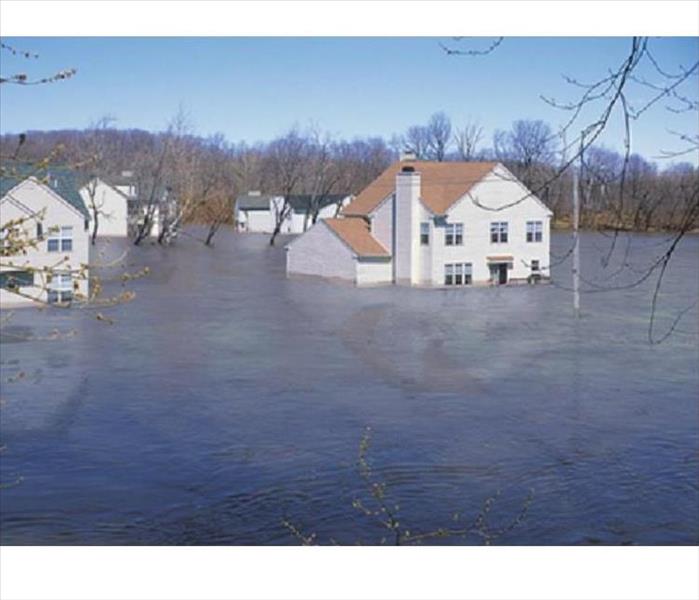 Flood Damage in Haddonfield NJ, What to Do in the First 24 Hours After a Flood,
Flood Damage in Haddonfield NJ, What to Do in the First 24 Hours After a Flood,
Flood Damage in Haddonfield NJ, What to Do in the First 24 Hours After a Flood,
After flood waters subside, document, work with your insurer, and clean up safely!
Whether a flood is caused by ground water, falling water, or home water system malfunction, there are some best practices you’ll need to employ within the first 24 hours after the flood to ensure the safety of your home and family and give you the best outcome possible with your insurance company.
If the flood was serious enough for you to leave your home, be sure you stay safe upon your return. The Federal Emergency Management Agency warns that you should check for any visible structural damage, such as warping, loosened or cracked foundation elements, cracks, and holes before entering the home and contact utility companies if you suspect damage to water, gas, electric, and sewer lines.
In addition, it’s important to have a working flashlight and turn off all water and electrical sources within the home, Even if the power isn’t operational, it’s a good idea to go to your fuse box and turn off the main, plus all of the individual fuse connections. That way, if the power is reactivated, you’re not at risk for mixing standing water and electricity.
Take Pictures: Before you remove any water or make any repairs, fully document the damage for your insurer by taking photos or video. Digital versions are best, says Ramirez, because they can be stored electronically and easily copied. If you start removing water or making repairs before you photograph the damage, you could potentially decrease the extent of your coverage, he says.
Even if the water in your home is clear, it could be contaminated by sewage or household chemicals. Be sure to throw out any food that may have come into contact with flood waters. FEMA recommends boiling water until authorities declare the water supply is safe.
Find Out if You're in a Disaster Area: Once a region has been officially declared a “disaster area” by government authorities, property owners have access to increased resources, including public services to protect and remediate the area. In addition, you may have access to financial assistance. Your insurance company will have additional information on this or you can contact FEMA directly.
Call Your Insurance Company: Since you should notify your insurer soon as possible after the flood, it’s a good idea to keep your insurance company and local agent’s phone number in your always-ready emergency bag. (Note that the NFIP works through private insurance companies, so you contact your insurer just as you would for any other type of claim). In cases where a flood has affected a region or community, your agent may be busy handling his or her own flood issues. In that case, contact the insurance company’s headquarters.
Since groundwater flood damage typically isn’t covered by conventional homeowners insurance policies, you’ll need to work with your insurer to determine the cause of the flood and the extent of your coverage.
Advise your insurance representative of the state of your home and any repairs you intend to do immediately. Be sure to follow the insurance company’s direction about whether or not to wait for an adjuster to inspect the property before making repairs. Document the damage and conversations at every stage of the process.
What can you expect in terms of time to get back to normal? It could be as little as one week if the claim and clean up is minimal to five to six months if you’re working with an insurance adjuster and contractor to complete extensive repairs.
Remove Water: Once you get the OK from your insurer to remove the water, use a sump pump, available from most hardware or home supply stores for $150 to $500, and a wet vac ($40 to $130) Be careful not to injure yourself, especially if you’re carrying buckets of water up and down stairs. Open doors and windows to allow fresh air to circulate so long as that won’t allow in more water.
Mitigate Mold Damage: Mold can develop within 24 to 48 hours of a flood, says Ashley Small of FEMA, so remove wet contents, including carpeting and bedding, as soon as possible. If an item has been wet for less than 48 hours, it may be salvageable. However, you’ll need to decide whether it holds enough monetary or sentimental value to try to do so. And notify your insurance company before removing items to ensure that you’re not affecting coverage. Always photograph the flood-soaked items.
Rugs, for example, may be dried and then cleaned professionally, which could cost $100 to $500 or more, depending on the size and number. Large pieces of furniture that are saturated will likely be difficult to dry effectively, and should often be discarded.
You may also wish to hire a flood restoration service—Look for those with Institute of Inspection, Cleaning, and Restoration Certification.
Secure the Property: As the homeowner, it’s your responsibility to secure the property so that no additional damage occurs. Put boards over broken windows and secure a tarp as protection if the roof has been damaged. Again, take photographs to prove to the insurance company that you have done everything possible to protect your home against further damage.
If the home is habitable, take precautions to keep yourself and your family safe from injury. Use flashlights to move around dark rooms, for example. If the home isn’t habitable, don’t try to stay there. Move to a shelter or alternate location. Consult your insurer to find out what provisions the company will make for temporary housing while your home is being repaired.
Water Damage in Haddonfield NJ, and The SERVPRO Emergency READY Profile Advantage, FREE SAMPLE PROFILE,
6/15/2017 (Permalink)
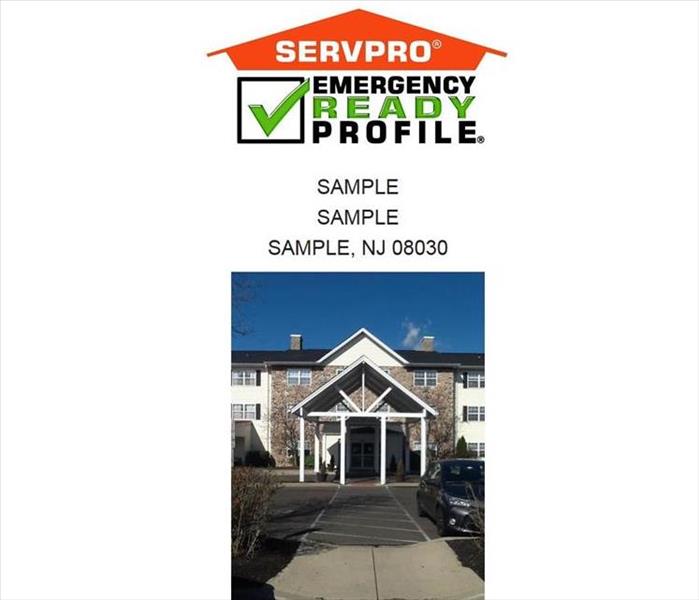 Water Damage in Haddonfield NJ, and The SERVPRO Emergency READY Profile Advantage, FREE SAMPLE PROFILE,
Water Damage in Haddonfield NJ, and The SERVPRO Emergency READY Profile Advantage, FREE SAMPLE PROFILE,
Water Damage in Haddonfield NJ, and The SERVPRO Emergency READY Profile Advantage, FREE SAMPLE PROFILE,
As many as 50% of businesses close down following a disaster, according to the latest research. Of the businesses that survive, the overwhelming majority of them had a preparedness plan in place. Pre-planning can serve as an insurance policy aimed at peace of mind. And knowing you are "Ready for whatever happens" speaks trust to your clients and employees that in the event your business is affected by a disaster, they don’t necessarily have to be.
By developing a SERVPRO Emergency READY Profile for your business, you minimize business interruption by having an immediate plan of action. Knowing what to do and what to expect in advance is the key to timely mitigation and can help minimize how water and fire damage can affect your business.
- A no cost assessment of your facility.
- This means there is no need to allocate funds, giving you a great value at no cost.
- A concise Profile Document that contains only the critical information needed in the event of an emergency.
- It will only take a little time to complete and will not take you away from current projects. But it will save a lot of time if ever needed.
- A guide to help you get back into your building following a disaster.
- This can help minimize the amount of time your business is inactive by having an immediate plan of action.
- Establishes your local SERVPRO Franchise Professional as your disaster mitigation and restoration provider.
- You have a provider that is recognized as an industry leader and close by.
- Identification of the line of command for authorizing work to begin.
- This saves time so we can begin the work of mitigating the damage which can save you time and money.
- Provides facility details such as shut-off valve locations, priority areas and priority contact information.
- Having a quick reference of what to do, how to do it and who to call provides solutions in advance of an emergency so that during the emergency you are "Ready for whatever happens."
Our SERVPRO location can Email you a Sample Copy, of an Emergency Ready Profile!
Washing Machine Hoses: A Disaster Waiting to Happen, Water Damage in Cherry Hill NJ,
6/14/2017 (Permalink)
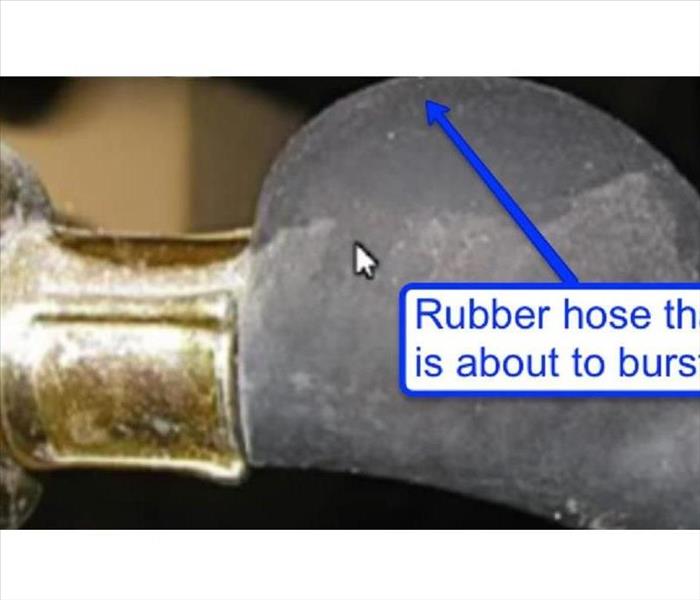 Washing Machine Hoses: A Disaster Waiting to Happen, Water Damage in Cherry Hill NJ,
Washing Machine Hoses: A Disaster Waiting to Happen, Water Damage in Cherry Hill NJ,
Washing Machine Hoses: A Disaster Waiting to Happen, Water Damage in Cherry Hill NJ, Though most property owners are careful to protect their buildings and possessions against fire, burglary, storms, and other dangerous conditions, they often overlook a situation that insurers know to be one of the most potentially destructive and costly: water damage caused by leaking or malfunctioning home appliances, especially washing machines. Unlikely as it may seem, water damage from washing machines is one of the top five causes of claims to home insurers, according to the Institute for Business and Home Safety, which analyzed 525 washing machine claims from multiple insurance companies.
Of all water damage claims related to washing machines, more than half – nearly 55% – are from water supply hoses that leaked or burst. And these claims are costly, with the average claim running to more than $6,000.
Why and How Do Washing Machine Hoses Fail? Over time, most washing machine hoses, even those that are installed properly, will eventually fail, leading to leaks or catastrophic floods caused when the hoses burst. Failure may be caused any of several factors, including age, installation error, poor-quality materials, and poor design. Under normal conditions, water in the hoses is under the same pressure as in other faucets in the building. When the hose becomes weakened, or when the connection is faulty, the water pressure will break the hose or coupling, sending water flooding out. In a typical residential plumbing system, water will spill out of a single burst hose at a rate of about 650 gallons per hour (that’s six gallons per minute, or 2½ tons per hour).
Because the supply lines to the washing machines are always “on,” water will flood from a broken hose until someone notices it and turns off the main supply line. If the hose breaks at night or when a building is unoccupied, thousands of gallons of water might flood the building before the problem is discovered. If the line breaks on a washing machine situated on an upper floor, the damage will be extensive as the water pours through the floors. Most traditional washing machine hoses are made of reinforced rubber or polymer.
These materials lose resiliency as they age, making them subject to cracks, leaks, and bursting. The IBHS study showed that failure rates increase dramatically in hoses that are more than five years old; the average age of failed hoses was 8.7 years. More than half of all failures occurred by the time the machine and its hoses were eight years old, and nearly 80% occurred before ten years. Improper installation can also damage the hose, leading to premature failure. The most common installation error is failure to leave sufficient room between the machine and the wall connection to prevent kinking or bending of the hose, particularly near the valve connections, as described below. Cracks, crimps, or blockages in the line will cause damage and lead to leaks or total failure.
Poor design (including fabrication from poor-quality materials) is probably the most significant factor in the failure of both kinds of hose commonly in use – the standard black rubber hose and the braided steel variety – though these products usually fail for different reasons, as described below. Standard black washer hoses are made of rubber tubing with a polyester reinforcement lining. The metal inserts at the coupling end are rolled and stamped from thin sheets of copper alloy. Most failures occur at the end of the hose, where the metal insert comes into contact with the tubing.
Failures generally occur for one of the following reasons: Razoring — The metal insert has a very sharp edge which is in direct contact with the rubber tube. This edge becomes progressively thinner and sharper as it is worn away by the movements of the water and by the effects of electrolysis. In a process called “razoring,” the motion of the washing machine causes the metal edge to rub repeatedly against the inside of the hose, cutting it gradually from the inside out. Stress Fractures — The metal insert is attached to the hose by a ferrule, or ring, which is crimped tightly to hold the pieces together. The crimping can cause a stress fracture in the hose, which is then subject to failure, especially as the rubber ages and begins to deteriorate.
Rusting — Corrosion (rusting) of the metal fitting can cause failure in two ways. First, as the thin metal fitting corrodes, it becomes jagged and rough and cuts into the hose as the washing machine operates. Water can leak between the hose and its outer covering, forming a bubble, a critical warning sign of imminent failure. Though a bubble may appear anywhere along the line, most breaks occur at the point where the metal fitting meets the rubber tube. Second, as the fitting continues to corrode, it can become so weak that it may eventually break apart. Braided stainless steel hoses (sometimes called “steel-clad” hoses) were designed as a reliable replacement for standard black hoses, but they, too, have been problematic. They have proven to be not much stronger than standard rubber hoses, and they are also subject to failures related to the to failures related to the materials from which they are fabricated.
Crimping — A braided stainless steel hose consists of a plastic or rubber tube covered with a braided steel sheath, which is sometimes protected with a thin nylon coating. Because of the variety of materials used, a very tight crimp is required to fasten the metal fitting securely to the hose. During the manufacturing process, this tight crimping can damage the hose by cutting into the rubber. Once the product is installed on a washing machine, the action of the water and the movements of the machine can make the cuts worse, leading to eventual failure. Corrosion — The stainless steel braided cover can oxidize when exposed to chloramine, a chemical increasingly popular in water treatment. Under these conditions, the stainless steel braided cover can weaken, fray, and even break, so that it can no longer provide strength to the hose.
Inspect Washing Machine Hoses Regularly In many cases, the hoses and fittings that connect the washing machine to the water source are visible and easy to inspect every time the machine is used. If your machine’s hoses are not visible, find out how to gain access to them in order to inspect them once a month or so. Inspect both hot and cold water lines. Most failures occur near the connection, where the hose typically bends. Here’s what to look for: Signs of Imminent Failure. Look for obvious signs of deterioration or imminent failure, such as blisters, bulges, bubbles, cracks, unraveling, discoloration, crimps, or kinks, especially near the connections and turns in the hose. Leaks. Check for moisture, drips, rust, discoloration, or leaks in, on, or around the hoses and connections or in the catch pan (if present). Check the connections to be sure that they are tightened properly, as described below. Even a small leak may indicate an imminent failure. Proper Positioning. Be sure that the washing machine is located at least four inches from the connections (usually at the wall) so that the hose is not bent or kinked. Check to see that the machine is properly balanced so that it does not “walk” during use. The motion of a “walking” machine will place added stress on the hoses and connections.
Replace Defective or Aging Hoses Immediately!
Humidity, Water Damage, Condensation, Mold, and Indoor Air Quality, in Cherry Hill NJ,
6/13/2017 (Permalink)
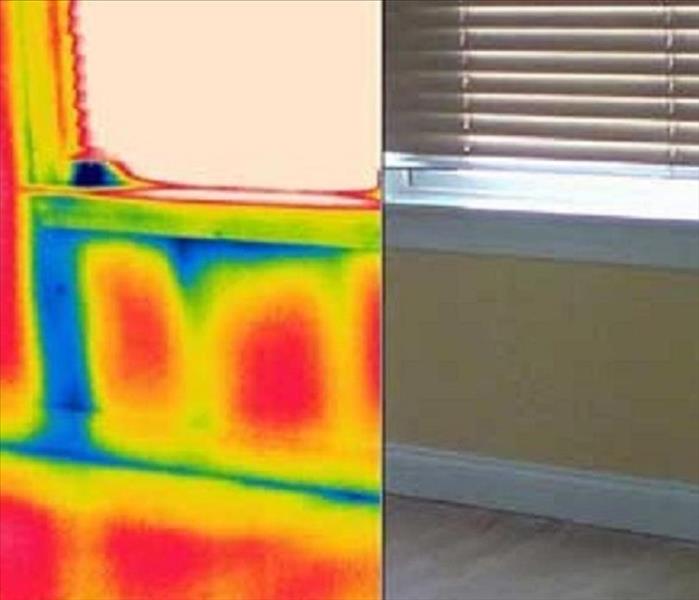 Humidity, Water Damage, Condensation, Mold, and Indoor Air Quality, in Moorestown NJ,
Humidity, Water Damage, Condensation, Mold, and Indoor Air Quality, in Moorestown NJ,
Humidity, Water Damage, Condensation, Mold, and Indoor Air Quality, in Moorestown NJ,
Moisture rides on air currents, and warm air carries more moisture than cool air
To control air flows, make sure the air barrier is continuous
An air barrier helps control airflow both through and within the building enclosure. By controlling airflow, you also control moisture.
If moist indoor air contacts a cold surface — for example, exterior sheathing in cold weather — condensation can result. An air barrier prevents those cold surfaces from being connected with humid indoor air.
Air has a maximum storage capacity for water vapor which depends on temperature. Warm air can store lots of moisture, while cold air can store very little.
As the temperature falls from 90°F down to 20°F, the amount of moisture that can be stored in the air changes by a factor of ten.
Leaky homes didn’t have condensation problems
Older buildings rarely had condensation problems in cold weather because they were so well ventilated — meaning leaky. The relative humidity in an old home would rarely rise above 25%. As we have built tighter houses (and in some cases failed to provide mechanical ventilation), the indoor relative humidity has gone up.
In a heated, tight, unventilated house, the amount of moisture in the air and the amount of condensation that can occur are dramatically different than in an old leaky house. Condensation can occur wherever water vapor can find a cold spot — on roof or wall sheathing, on the inside faces of the windows, and inside the walls.
Let's say it’s 40°F outside and the outdoor relative humidity is 50%. If you allow that outdoor air to enter a building and heat it up to 70°F, the amount of moisture in the air stays exactly the same, but the “tank” gets bigger because the storage capacity of the air increases with the temperature. As a result, the relative humidity initially drops. Then, as moisture is added to the air, the relative humidity rises, and the absolute moisture content rises as well. How do you add moisture to the air? You breathe, sweat, boil water for spaghetti, take hot showers, grow houseplants — and all of those activities generate moisture.
When does indoor humidity become a problem?
Let’s say that air leaks out of a house through holes in the enclosure. As it reaches surfaces colder than 52°F or 53°F, the air will cool. Once it reaches its full capacity to store moisture, condensation occurs.
If the temperature of the outdoor air is around 30°F, the indoor air will drop all of the moisture that it gained on the way out, dumping it on the cold sheathing surface. That’s a typical example of the air leakage condensation cycle. Since condensation in walls can cause puddles — and in extreme cases, rot the framing — condensation is something you want to avoid. Installing an air barrier is one way to help prevent condensation.
Air conditioning can also create condensing surfaces
The same phenomenon can happen in reverse in the summertime. Let’s say the outdoor air is 85°F and the relative humidity is 75%. When outdoor air leaking inward contacts a surface below about 76°F, the moisture in the air will condense. So if you have an exhaust fan in your home, the air leaking in may cause condensation on the air-conditioned surfaces — for example, on the back side of vinyl wallpaper.
If moist air leaks into a house through gaps in the wall or roof, you can have problems. But in a tight house with a good air barrier and a supply-only ventilation system, most of the air that’s drawn inside is drawn in through the air conditioner, so the first cold surfaces it sees are the cooling coils.
If you have air leaks in your building envelope, you usually can’t see the condensation —Unless you have an Infrared Camera with a Visual Inspection. However, condensation is sometimes visible in the attic; all you have to do is look for frost or dampness forming on the underside of the OSB or plywood roof sheathing.
Water damage can be deceptive, Water Damage in Cherry Hill NJ,
6/5/2017 (Permalink)
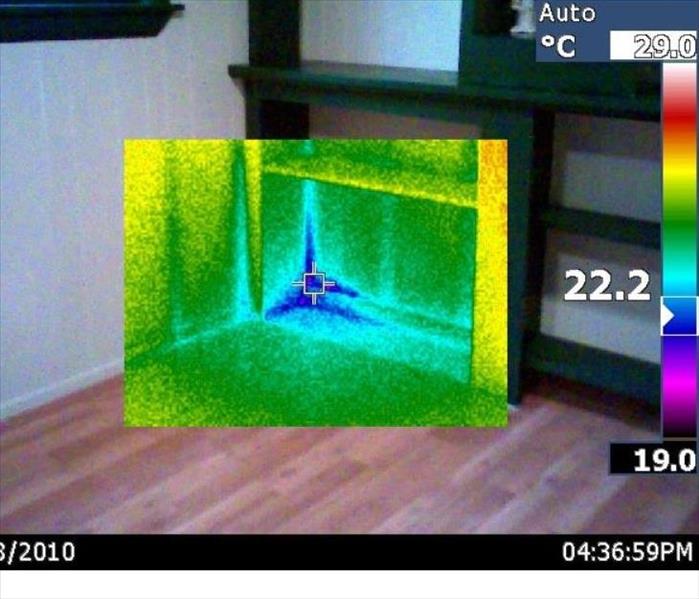 Water damage can be deceptive, Water Damage in Cherry Hill NJ,
Water damage can be deceptive, Water Damage in Cherry Hill NJ,
Water damage can be deceptive. Water penetrates into structural cavities creating trapped pockets of saturation. The detection of water in these areas can often only be discovered with sophisticated moisture detection meters. Undetected moisture will continue to cause damage. This damage, at a minimum, will cause odors. Greater damage will surface when materials delaminate, shrink, split and further deteriorate to where costly repairs are required.
More than just removing excess water, IICRC-certified restorers have the knowledge and equipment to further dry a home or facility (including substructure materials) completely back to preloss conditions. Through timely response and the careful monitoring of water damage, mold and other health issues can be prevented. If water damage has been present too long, mold will occur.
All IICRC-certified professionals have the training and experience to identify moisture sources, evaluate mold growth (visible or suspected), contain damage, remove contamination and dry materials to ensure that mold will not return.
While there are many methods for drying structural components and contents, the “in-place” drying system has been taught in the industry and used by drying contractors since the early ’80s. In those days, this method of drying components, without significant removal of furnishings or fixtures, was somewhat restricted, due to limitations imposed by extraction, evaporation and dehumidification equipment. In recent years, however, drying technology (extraction, evaporation, dehumidification), along with better understanding of psychrometry, has advanced in major ways so that in-place drying has, in some cases, become far more safe and practical.
Water Damage in Cherry Hill NJ, Detect and Prevent
5/31/2017 (Permalink)
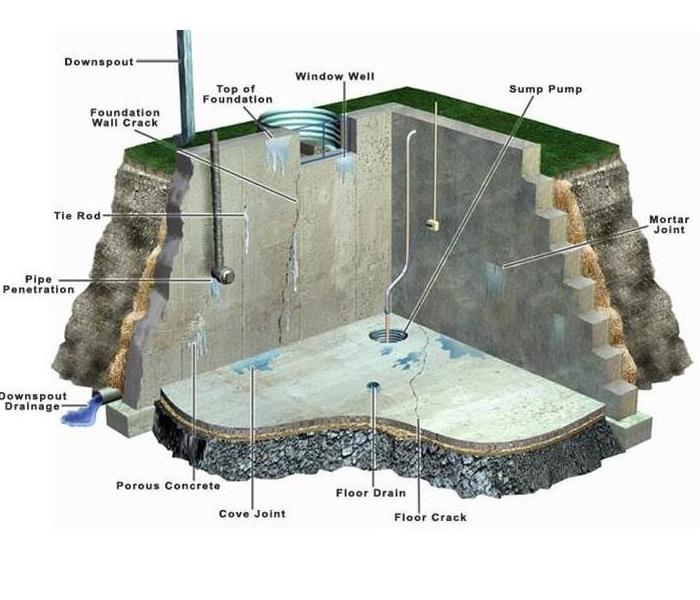 Water Damage in Cherry Hill NJ, Detect and Prevent
Water Damage in Cherry Hill NJ, Detect and Prevent
Standing water on the floor is easy to see. Less obvious signs of problems include:
- Unexpected increases in your water bill
- Stains on walls, floors or ceilings
- Damaged or warped flooring
- Warped bottom panels in under-sink cabinets
- Peeling paint or wallpaper
- Corrosion on plumbing valves and fittings
Deal with problems as you find them. Clean up any water or moisture, locate the source and make repairs. Tracking down a leak isn't always straightforward — water can travel along components in the building structure, so the indications of the leak may be in a different part of the home than the leak itself. If necessary, contact a professional roofing contractor, plumber or water damage restoration specialist to help with identification and repair.
In addition to the damage that water causes, it can encourage the growth of mold on walls and floors — where it's readily visible — and in ductwork, attics and crawl spaces — where you might not notice it. A musty odor is a sign that mold may be present.
Mold can cause damage and lead to health problems — deal with it quickly. If the affected area is larger than 3 feet by 3 feet, the Environmental Protection Agency recommends you find a professional mold remediation contractor. For smaller areas, you can clean nonporous surfaces with commercial cleaning products, soap and water or a solution of a cup of bleach to each gallon of water. Follow the instructions and safety precautions for the cleaning product you use and wear appropriate safety gear. Porous surfaces such as drywall need to be replaced. For more information on mold in the home and how to clean it up, see A Brief Guide to Mold, Moisture, and Your Home on the EPA's web site.
Inspecting common sources of water leaks and taking some simple preventative measures can be an effective way to reduce the risk of water damage and mold.
Plumbing
- Every 6 to 12 months, inspect water lines, shut-off valves and fittings for fixtures such as sinks, toilets and tubs and for appliances such as washing machines, dishwashers and ice makers. Check for cracks, loose connections, kinks and corrosion. If you find a leak, turn off the water to the fixture or appliance until you can make repairs.
- Check around toilets to make sure water is not leaking at the base — an indication that the wax ring between the toilet and floor might need replacing or that there might be a crack in the base.
- If the temperature drops near the 20°F mark, allow faucets connected to vulnerable pipes — those not protected in insulated spaces — to drip. This helps minimize the risk of burst pipes by relieving pressure if the pipes freeze.
Appliances
- Replace washing machine supply hoses at least every five years. Consider using stainless-steel mesh hoses. Keep the machine properly balanced — over time, an unbalanced machine can move, pulling free the hose connections. Read Maintain Your Washer and Dryer for instructions on replacing hoses and balancing the washing machine.
- Consider turning off the water to the washing machine when it's not in use.
- Don't operate a dishwasher or washing machine while your house is unoccupied.
- Follow the manufacturer-specified maintenance for your appliances, including your water heater. Have the water heater inspected every couple of years.
Roof and Gutters
- Have your roof inspected every three years by a professional, but also check routinely for damage you can see from the ground — such as broken and missing shingles or damaged flashing. A poorly maintained roof can lead to leaks in the home and additional damage to the roof itself.
- If your roof doesn't have a drip edge or drip cap, consider having one added. This component helps keep water away from the roof deck and directs runoff into gutters.
- Keep gutters clear and well-maintained. Gutters that overflow, leak or don't drain properly allow water to seep into your roof and into your foundation, crawlspace or basement. See Gutter Cleaning and Repair for steps to keep your gutters working correctly.
- Make sure gutter downspouts direct rainwater away from the home's foundation. Use extensions to carry water at least 6 feet from the house.
Exterior Walls and Foundation
- Inspect the exterior of your home. Caulk around gaps at plumbing and ventilation entry and exit points. See How to Caulk for instructions. Repair cracked mortar joints.
- Check to see if roots from shrubs near your home have caused damage that can allow water to enter the foundation. You may need to remove shrubs that are close to the house to prevent problems. Roots can also damage and block in-ground pipes, causing leaks near the foundation and sewer backups in the home.
- Keep shrubbery beds and other landscape features sloped to direct water away from the home.
- Look for evidence of erosion or settling at the foundation that can indicate water problems.
Additional Tips to Avoid Water Damage
- Have your attic ventilation and insulation inspected annually and seal gaps that allow warm air into the attic — such as those around access doors and light fixtures. When warm air collects in the attic, it can lead to the formation of an ice dam — ice around the eaves that causes water from melting snow and ice to back up under the shingles and leak into your home.
- If you have a sump pump, test it several times during the year. Follow the manufacturer's maintenance instructions.
- Check your water pressure with a pressure gauge; typically these screw onto a hose bib. The pressure in an average home is around 50 to 70 pounds per square inch (psi). Higher pressure causes extra stress on pipes and fittings and can lead to leaks.
- Inspect tile and grout around showers and tubs. Make any necessary repairs. Read Replace a Broken Ceramic Tile and Repair Tile Grout for step-by-step instructions.
- Check for leaks around windows during rains and seal any you find.
- Use exhaust fans in the kitchen and bathroom to move excess moisture out of the house. Moisture in the air can condense on cool surfaces and cause problems. Read Controlling Moisture and Humidity in the Home for more ways to reduce indoor moisture.
- Locate your water shut-off valve so you can quickly turn off water to the home in an emergency. See Shut Off Your Home Water Supply for instructions on locating the valve.
Roof Leaks in Cherry Hill, NJ, Shingle Damage in Cherry Hill, NJ, Chimney Leaks, and Tips for Preventing Leaks
5/24/2017 (Permalink)
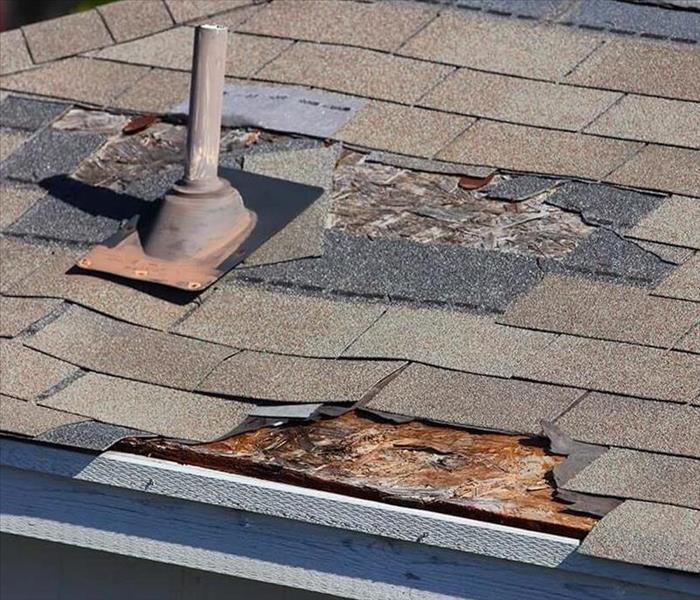 Roof Leaks in Cherry Hill, NJ, Shingle Damage in Cherry Hill, NJ, Chimney Leaks, and Tips for Preventing Leaks
Roof Leaks in Cherry Hill, NJ, Shingle Damage in Cherry Hill, NJ, Chimney Leaks, and Tips for Preventing Leaks
Check for damage in the roofing material directly above where the leak is coming in. This will likely be easier to find on a flat roof, but leaks can also come into the house a good distance from where the actual roof damage is located.If your roof is slanted, inspect areas on the roof that are higher than where the leak enters the home.
If you have an attic, inspect it with a flashlight for water stains, black marks or mold.
Run a hose along different sections of the roof and have a person inside alert you when leaking occurs.
Look for damaged, curled or missing shingles near where the leak is coming in. Look closely for exposed roofing tacks, too.
Straighten out shingles that are curled back. In colder weather, this might require that you soften the shingle edge with heat, such as an electric hair dryer. Using a torch or other open flame heat source isn't recommended since asphalt shingles may be flammable, and regardless of whether they are flame retardant or not, excess heat will ruin the shingle.
Reattach curled-back shingles after straightening with a generous amount of asphalt roof cement or compound around the exposed edges.
Replace damaged shingles. If the shingle lifts off the roof with little effort, breaks, or simply crumbles, it needs to be replaced.Remove the old shingle by lifting its edges and prying out the nail.
Scrape the area underneath it to remove any leftover roofing cement.
Use a sharp utility knife to round the back corners of the new shingle slightly.
Slide the new shingle into place and drive 1 1⁄4 inch (3.2 cm) galvanized roofing nails into each upper corner, then cover the nail heads with roof cement.
Inspect for cracks or blisters in the roofing material.
Mend the blisters. Cut a line through the middle of the blister with a utility knife, but do not cut the sound roofing felt {substrate) underneath.Squeeze out or soak up any water inside the blister. The area needs to be completely dry.
Spread a generous amount of roofing cement under the loose roofing material and press down.
Drive galvanized roofing nails along each side of the repaired blister.
Inspect areas where surfaces connect, such as a chimney or vent pipe.
Look for damage to the caulking, and reapply caulk where necessary.
Remove damaged or deteriorated caulking so the new application can bond to the roof or flashing surface.
Use a putty knife to remove the loosened old caulk.
Clean and dry the area.
Cut the tip off the caulk tube and spread a bead along the same line, working it into the crack with an applicator. Let it dry.
Larger-scale repairs will be necessary if there is damage to the flashing around the chimney or the boots around vents, as these features may need to be replaced.
Flood damage in Cherry Hill, NJ, and Insurance Property Damage Claims, What You May Need to Know
5/23/2017 (Permalink)
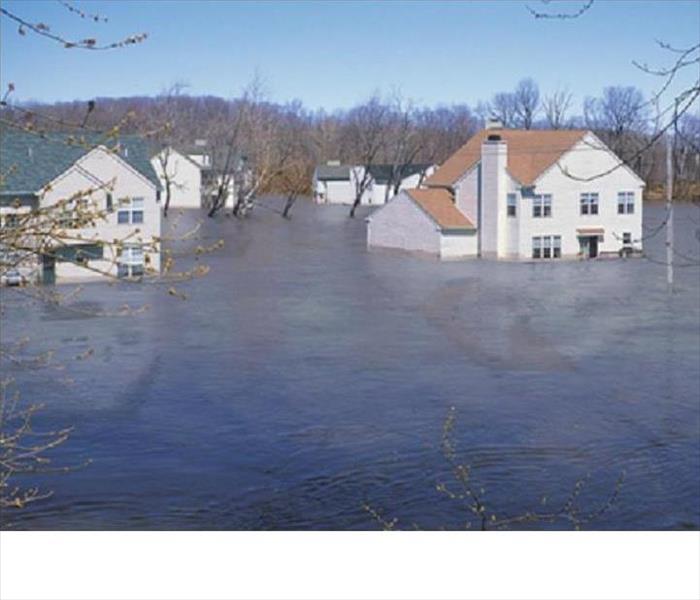 Flood damage in Cherry Hill, NJ, and Insurance Property Damage Claims, What You May Need to Know
Flood damage in Cherry Hill, NJ, and Insurance Property Damage Claims, What You May Need to Know
Rising waters and flood damage can cost tens of thousands of dollars to repair. Most homeowner, who has insurance, will want to make a claim. While all insurance companies don’t have flood coverage, usually a separate policy is purchased in areas where flood waters are a risk. While some insurance companies can take a claim over the phone, an insurance claim letter is always the best way to go. Sure you can call, but a letter can say much more and include valuable pictures. This letter needs to contain specific information about the incident, and when it occurred. All this is valuable and necessary to a claim.
Since this is a formal letter, make sure it is appropriately set up. A block style format should be observed. The name and address of the claimant, followed by the date and then the name and address of the insurance company should always be on the left hand side. A subject line would also be appropriate in this type of correspondence. Unless you know someone personally at the insurance company, you will probably need to address it with a general "To Whom It May Concern," or a “Dear Sir/Madam.”
Start the first paragraph by telling them why you are writing. As a matter of fact, make sure this is in the first sentence. You want to make sure your needs are specified loud and clear. You need to be very specific in your writing and make sure to not leave out any details. If the carpet in the basement is ruined, say so. Specify the date the incident happened and the event that triggered it. Are there other homes in the area directly affected? Make sure to put as much info as you can in the first paragraph.
Giving background information is always helpful to an adjuster. Did you call in an extraction company? Many people call in extraction services before they call the insurance company. These companies can remove the water and do their best to save furniture and carpet. Make sure to specify any methods used to try to save the items. Don't leave out problems with drywall, electric and other critical items. These are of the up-most importance. Just because you got the water out of an item, doesn't mean the problems will stop. Oftentimes, mold will set into areas that have had severe water damage.
Make sure the tone of the letter is friendly. Give information that is necessary to the claim, like account numbers, who the policy’s name is under etc. Also state what you believe your policy limits are, if known. Encourage the company to clear the matter up quickly. Give them an invitation to call or contact you as soon as possible. This letter, along with picture evidence, is a great way to get the ball rolling on your claim. The sooner you contact the insurance company, the sooner you can have your damages repaired. End your letter with a formal conclusion and contact information.
Indoor Relative Humidity and Moisture issues, Inside Your Property, in Cherry Hill, NJ
5/19/2017 (Permalink)
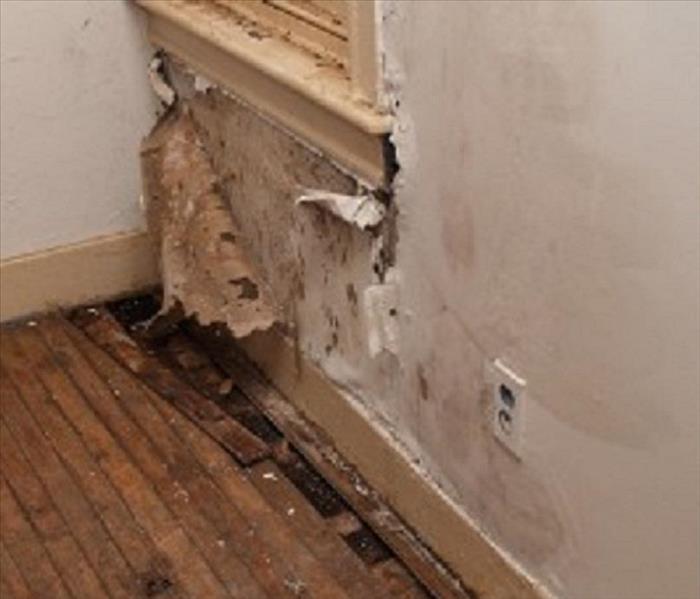 Indoor Relative Humidity and Moisture issues, Inside Your Property
Indoor Relative Humidity and Moisture issues, Inside Your Property
When indoor humidity levels are too high, condensation on windows and walls starts to cause structural damage. Damage to the house manifests in wood rot, molds, damp spots, and corroding furniture.
Costly damage caused by moisture that builds up can occur between the walls and ceilings, paint may start to peel as well as permanent wood warping/damage.Every time we cook, bathe, shower or breathe, we increase the amount of moisture in the air; when these activities occur indoors, we raise the humidity level inside our home. Humidity is the amount of water vapor in the air; it makes the air feel wet and clammy or smell musty. During a hot summer day, humidity makes the air feel even warmer, since it prevents sweat from evaporating from the skin, undermining the body's way of staying cool.
Relative humidity is the amount of water the air contains compared to the amount it could contain at a specific temperature. When the relative humidity is 100 percent, the air is retaining the most moisture possible at that temperature without precipitation. Most of us feel comfortable inside our home when the relative humidity remains between 30 and 60 percent. When the indoor humidity level is below 30 percent, the air is too dry, which can harm both a home's structural integrity and the homeowners' health. Conversely, when the level is above 60 percent, the air is too wet, which is also harmful to both the home and the homeowners. Excess humidity is a breeding ground for mold, pests and rot in homes and is more likely to cause heatstroke, heat exhaustion, headaches and dehydration than a less humid atmosphere.
To combat a high humidity level inside the home, many homeowners run the air conditioning unit. While air conditioning can reduce the humidity level, the result is high energy bills and a cold and uncomfortable living space. Rather than using air conditioning, homeowners and builders can have a whole-house dedicated dehumidification system installed. This type of system operates using the home's central air distribution system. A dehumidification system can be programmed to maintain specific humidity levels, giving homeowners the ability to customize the comfort level of their home.
Whole-house dehumidification systems can be installed in both new and existing homes. Here are a few points to keep in mind when considering installing dedicated dehumidification systems:
- Choose a dehumidification system that has built-in fan cycling. This feature will keep the humidity and temperature balance steady throughout the home instead of in just one room. It will also minimize hot and cold spots and improve the overall air quality.
- Look for a dehumidification system that has the capacity to remove up to 90 pints of moisture per day from the air. For builders, a high-capacity system will provide for the flexibility of using the system in a wide variety of homes.
Air Conditioner Problems, and Prevent AC Condensation leaking into your Property, Water damage in Cherry Hill, NJ
5/18/2017 (Permalink)
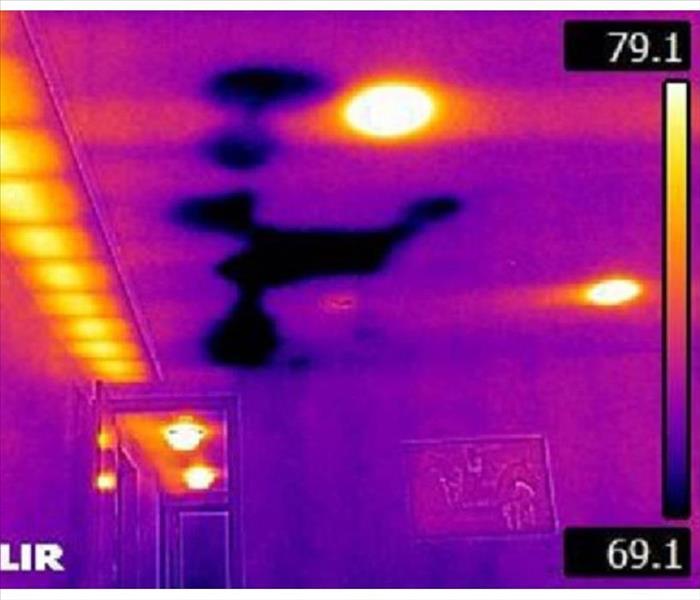 Air Conditioner Problems, and Prevent AC Condensation leaking into your Property, Water damage in Cherry Hill, NJ
Air Conditioner Problems, and Prevent AC Condensation leaking into your Property, Water damage in Cherry Hill, NJ
One of the most common air conditioning problems is improper operation. If your air conditioner is on, be sure to close your home's windows and outside doors. For room air conditioners, isolate the room or a group of connected rooms as much as possible from the rest of your home. For a list of common air conditioner problems and what to look for, check out our Energy Saver 101 infographic on home cooling.
Other common problems with existing air conditioners result from faulty installation, poor service procedures, and inadequate maintenance. Improper installation of a central air conditioner can result in leaky ducts and low airflow. Many times, the refrigerant charge (the amount of refrigerant in the system) does not match the manufacturer's specifications. If proper refrigerant charging is not performed during installation, the performance and efficiency of the unit is impaired. Unqualified service technicians often fail to find refrigerant charging problems or even worsen existing problems by adding refrigerant to a system that is already full. Learn what to ask for when hiring a technician to maintain your air conditioner.
Air conditioner manufacturers generally make rugged, high quality products. If your air conditioner fails, begin by checking any fuses or circuit breakers. Let the unit cool down for about five minutes before resetting any breakers. If a central air conditioner's compressor stops on a hot day, the high-pressure limit switch may have tripped; reset it by pushing the button, located in the compressor's access panel.
REFRIGERANT LEAKS
If your air conditioner is low on refrigerant, either it was undercharged at installation or it leaks. If it leaks, simply adding refrigerant is not a solution. A trained technician should fix any leak, test the repair, and then charge the system with the correct amount of refrigerant. Remember that the performance and efficiency of your air conditioner is greatest when the refrigerant charge exactly matches the manufacturer's specification, and is neither undercharged nor overcharged. Refrigerant leaks can also be harmful to the environment
INADEQUATE MAINTENANCE
If you allow filters and air conditioning coils to become dirty, the air conditioner will not work properly, and the compressor or fans are likely to fail prematurely.
ELECTRIC CONTROL FAILURE
The compressor and fan controls can wear out, especially when the air conditioner turns on and off frequently, as is common when a system is oversized. Because corrosion of wire and terminals is also a problem in many systems, electrical connections and contacts should be checked during a professional service call.
SENSOR PROBLEMS
Room air conditioners feature a thermostat sensor, located behind the control panel, which measures the temperature of air coming into the evaporative coil. If the sensor is knocked out of position, the air conditioner could cycle constantly or behave erratically. The sensor should be near the coil but not touching it; adjust its position by carefully bending the wire that holds it in place.
DRAINAGE PROBLEMS
When it's humid outside, check the condensate drain to make sure it isn't clogged and is draining properly. Room air conditioners may not drain properly if not mounted level.
Common Causes of AC Water Leakage
The following issues can cause water leaks in your central AC system:
Clogged Drain Line
A clogged condensate drain pipe can make your AC system’s drain pan overflow. This is probably the most frequent cause of water leakage from a central AC system, bringing many service calls to HVAC professionals as summer temperatures rise. Drain lines can become clogged with dirt, rust, algae and other debris.
Disconnected Drain Line
When AC systems are improperly installed drain pipe fittings may not be secure. Over time, they can loosen, causing the drain pipe to disconnect from the AC unit and allowing the condensate to drain through the ceiling or onto the floor. As with a clogged drain line, the location of the leak will depend on whether the primary or secondary drain pipe is the one affected and whether your central AC system is located in the attic or in your house.
Condensate Pump Problems
A malfunctioning or dirty condensate pump can also cause water leakage from your AC system, flooding your attic or basement. Due to the continual presence of water, mold and mildew can grow inside the unit, causing it to clog.
Other Potential Causes of AC Water Leakage
Water leaks can also be caused by the following issues:
- Clogged air filter
- Low refrigerant
- Cracked condensate drain pan
- No p-trap and air vent in the drain line to prevent water backup
- Condensate buildup in un-insulated ductwork
The first two issues in the list above can contribute to a frozen evaporator coil, which creates its own set of water leakage problems.
Ways to Avoid Damage from Water Leakage
Follow these tips to reduce the likelihood of water leakage issues:
- Make sure your central AC system has a secondary drain line — especially if your air handler is in the attic.
- Install a drain pan overflow shutoff switch, equipped with a float.
- Add a safety pan under your AC unit to catch drain pan overflow.
- Clean or change your HVAC air filter regularly.
- Make sure your ductwork is properly insulated.
- Have your AC refrigerant levels checked regularly.
- Make sure each drain line contains a p-trap and air vent.
- Keep your condensate pump free from mold and mildew by flushing it with a 50% bleach/water solution.
- Schedule annual HVAC maintenance to maximize performance and minimize furnace and AC repairs.
TOP 10 CAUSES OF WATER DAMAGE IN YOUR HOME AND PROPERTY!
5/11/2017 (Permalink)
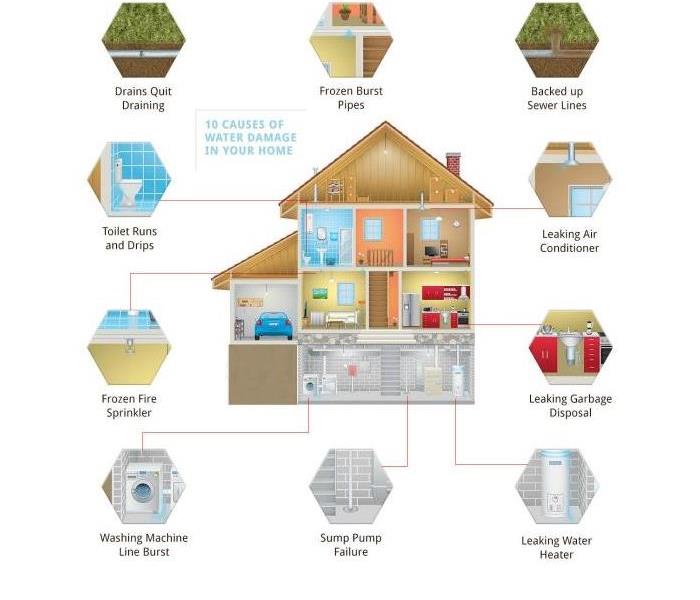 TOP 10 CAUSES OF WATER DAMAGE IN YOUR HOME AND PROPERTY!
TOP 10 CAUSES OF WATER DAMAGE IN YOUR HOME AND PROPERTY!
Old plumbing and leaky appliances around the house aren’t out to get you, but sometimes it seems that way. The weather plays a part too with winter freezes that burst pipes and spring rains that flood basements.Our cleanup and restoration teams have seen it all here in Chicago and the surrounding suburbs. In our experience, these are the 10 most common causes of residential water damage that can affect your home. Our list also includes helpful links and tips on how to handle each type of wet disaster.
1. The Toilet Runs and Drips
When it constantly runs, it’s annoying and expensive. When it springs a bad leak, it can ruin floors and walls. The trick to fixing a leaky toilet is figuring out why it’s turned into a water hazard. Once you pinpoint the problem, repairs are usually simple and inexpensive.
2. Pressure Gets to the Washing Machine
Your washing machine quickly fills with water because its supply lines are under constant pressure. Older rubber or PVC lines wear out and rupture, and that failure turns the laundry room into a flood zone. Avoid this potential mess by replacing old lines with braided stainless steel.
3. Your Garbage Disposal Floods Cabinets
Most disposal leaks are DIY fixable, but when this appliance stops working, it can go out with a splash. As the body of the unit gets old, it springs leaks around the bottom housing and floods cabinets with a dirty mix of food garbage and water. When this happens, you need to replace the disposal.
4. Your AC Soaks the Ceiling
The AC pulls humidity out of the air and condenses moisture into the unit’s overflow pan so that water travels outside through the condensate line. This drainage system quits working if the pan is damaged or the line is clogged. The results are soggy insulation and soaked ceilings.
5. The Water Heater Develops Leaks
This appliance is often located in basements, and that can make cleanup even more challenging after a bad leak. Sometimes, a water heater problem is due to condensation, but it’s more likely a faulty water outlet or drain valve. Older units can develop leaks in the bottom of the tank and flood the entire basement.
6. Frigid Temperatures Burst Pipes
This water emergency is confined to cold months, but you have to be prepared. Pipes can freeze and rupture in just a few hours, and the flooding can soak the house from ceiling to basement. Always check and insulate your plumbing before the Chicago winter settles in.
7. Fire Sprinkler Systems Freeze Too
High-rises, condos and newer homes feature these life-saving systems, but residential fire sprinklers are prone to freezing without proper winter maintenance. Cold-weather sprinkler routines keep the family safe and help avoid water damage from ruptured pipes.
8. The Sump Pump Stops Pumping
Whether it’s caused by heavy rain or appliance failure, water in the basement is a disaster when the sump pump stops working. You have to deal with water removal, thoroughly dry everything and address mold and mildew growth. It’s often best to let professionals handle basement flooding.
9. Drains Quit Draining
This simple outlet can complicate an ordinary day by leaving standing water in a tub, the kitchen sink or the basement. A stopped-up tub or sink is a big nuisance, but a clogged floor drain can result in a basement filled with water. Your DIY solutions range from drain snakes to air blasters.
10. Sewer Lines Back Up
Don’t try to handle this problem by yourself. Backed-up sewer lines are caused by blockage or heavy rainfall, and they quickly spread dangerous contaminants that create a very unhealthy environment. Sewage backup and flooding should always be taken care of by certified professionals.
Water Damage in Your Property?
4/26/2017 (Permalink)
Water damage describes a large number of possible losses caused by water intruding where it will enable attack of a material or system by destructive processes such as rotting of wood, growth, rusting of steel, de-laminating of materials such as plywood, and many others.
The damage may be imperceptibly slow and minor such as water spots that could eventually mar a surface, or it may be instantaneous and catastrophic such as flooding. However fast it occurs, water damage is a major contributor to loss of property.
An insurance policy may or may not cover the costs associated with water damage and the process of water damage restoration. While a common cause of residential water damage is often the failure of a sump pump, many homeowner's insurance policies do not cover the associated costs without an addendum which adds to the monthly premium of the policy. Often the verbiage of this addendum is similar to "Sewer and Drain Coverage".
Those individuals who are affected by wide scale flooding may have the ability to apply for government and FEMA grants through the Individual Assistance program. On a larger level, businesses, cities, and communities can apply to the FEMA Public Assistance program for funds to assist after a large flood. For example, the city of Fond du Lac Wisconsin received $1.2 million FEMA grant after flooding in June 2008. The program allows the city to purchase the water damaged properties, demolish the structures, and turn the properties into public green space.
Causes
Water damage can originate by different sources such as a broken dishwasher hose, a washing machine overflow, a dishwasher leakage, broken/leaking pipes, and clogged toilets. According to the Environmental Protection Agency, 13.7% of all water used in the home today can be attributed to plumbing leaks.[3] On average that is approximately 10,000 gallons of water per year wasted by leaks for each US home. A tiny, 1/8-inch crack in a pipe can release up to 250 gallons of water a day.[4]According to Claims Magazine in August 2000, broken water pipes ranked second to hurricanes in terms of both the number of homes damaged and the amount of claims (on average $50,000 per insurance claim costs in the US. Experts suggest that homeowners inspect and replace worn pipe fittings and hose connections to all household appliances that use water at least once a year. This includes washing machines, dishwashers, kitchen sinks and bathroom lavatories, refrigerator ice makers, water softeners and humidifiers. A few US companies offer whole-house leak protection systems utilizing flow-based technologies. A number of insurance companies offer policy holders reduced rates for installing a whole-house leak protection system.
As far as insurance coverage is concerned, most damage caused by bad weather is considered flood damage and normally is not covered under homeowners insurance. Coverage for bad weather would usually require flood insurance.
Categories
Category 1 Water - Refers to a source of water that does not pose substantial threat to humans and classified as "clean water". Examples are broken water supply lines, tub or sink overflows or appliance malfunctions that involves water supply lines.
Category 2 Water - Refers to a source of water that contains a significant degree of chemical, biological or physical contaminants and causes discomfort or sickness when consumed or even exposed to. Known as "grey water". This type carries micro organisms and nutrients of micro organisms. Examples are toilet bowls with urine (no feces), sump pump failures, seepage due to hydrostatic failure and water discharge from dishwashers or washing machines.
Category 3 Water - Known as "black water" and is grossly unsanitary. This water contains unsanitary agents, harmful bacteria and fungi, causing severe discomfort or sickness. Type 3 category are contaminated water sources that affects the indoor environment. This category includes water sources from sewage, seawater, rising water from rivers or streams, ground surface water or standing water. Category 2 Water or Grey Water that is not promptly removed from the structure and or have remained stagnant may be re classified as Category 3 Water. Toilet back flows that originates from beyond the toilet trap is considered black water contamination regardless of visible content or color.
Classes
Class of water damage is determined by the probable rate of evaporation based on the type of materials affected, or wet, in the room or space that was flooded. Determining the class of water damage is an important first step, and will determine the amount and type of equipment utilized to dry-down the structure.[7]
Class 1 - Slow Rate of Evaporation. Affects only a portion of a room. Materials have a low permeance/porosity. Minimum moisture is absorbed by the materials.
Class 2 - Fast Rate of Evaporation. Water affects the entire room of carpet and cushion. May have wicked up the walls, but not more than 24 inches.
Class 3 - Fastest Rate of Evaporation. Water generally comes from overhead, affecting the entire area; walls, ceilings, insulation, carpet, cushion, etc.
Class 4 - Specialty Drying Situations. Involves materials with a very low permeance/porosity, such as hardwood floors, concrete, crawlspaces, plaster, etc. Drying generally requires very low specific humidity to accomplish drying.
Restoration
See also: Convectant drying
Different removal methods and measures are used depending on the category of water. Due to the destructive nature of water, chosen restoration methods also depend heavily on the amount of water, and on the amount of time the water has remained stagnant. For example, as long as carpet has not been wet for longer than 48 hours, and the water involved was not sewage based, a carpet can usually be saved; however, if the water has soaked for longer, then the carpet is probably irreparable and will have to be replaced.[8] Water damage restoration can be performed by property management teams, building maintenance personnel, or by the homeowners themselves; however, contacting a certified professional water damage restoration specialist is often regarded as the safest way to restore water damaged property.
Standards and regulation
While there are currently no government regulations in the United States dictating procedures, two certifying bodies, the Institute of Inspection Cleaning and Restoration Certification (IICRC) and the RIA, do recommend standards of care. The IICRC-recommended standard is IICRC S500.
Fire and Water Restoration companies are regulated by the appropriate state's Department of Consumer Affairs - usually the state contractors license board. In California, all Fire and Water Restoration companies must register with the California Contractors State License Board.[10] Presently, the California Contractors State License Board has no specific classification for "water and fire damage restoration."
Procedures
Water damage restoration is often prefaced by a loss assessment and evaluation of affected materials. The damaged area is inspected with water sensing equipment such as probes and other infrared tools in order to determine the source of the damage and possible extent of area affected. Restoration services would then be rendered to the residence in order to dry the structure, sanitize any affected or cross contaminated areas, and deodorize all affected areas and materials. After the labor is completed, water damage equipment including air movers, air scrubbers, dehumidifiers, wood floor drying systems, and sub floor drying equipment is left in the residence. Industry standards state that drying vendors should return at regular time intervals, preferably every twenty-four hours, to monitor the equipment, temperature, humidity, and moisture content of the affected walls and contents.
Refrigerator Water Line and Drain Hose Leaks...Prevention Tips!
4/13/2017 (Permalink)
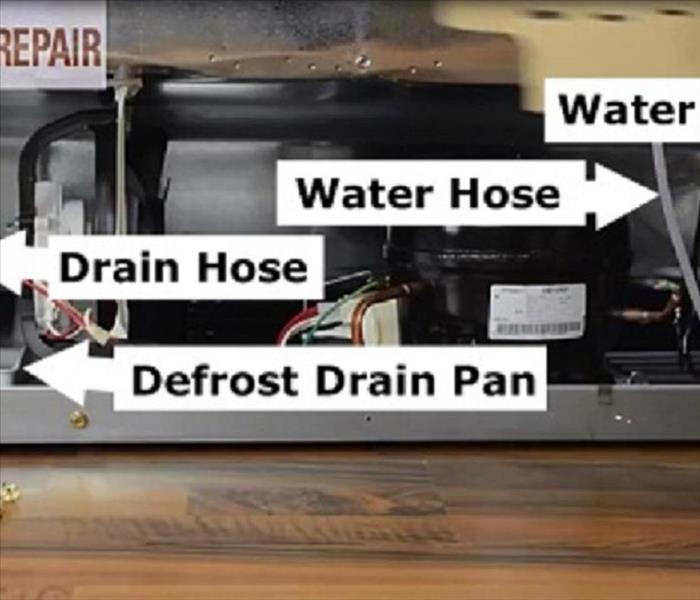 Refrigerator Water Line and Drain Hose Leaks...Prevention Tips!
Refrigerator Water Line and Drain Hose Leaks...Prevention Tips!
Refrigerator Water Line Leaks, Prevention Tips!
The refrigerator is one of the hardest working appliances around the home, so when one breaks down or suffers a leak, the experience can have consequences. If you find that your fridge’s water line has a leak, there are a few simple steps you can follow to troubleshoot the problem and have it running again in no time.
What To Do When Your Refrigerator Water Line Leaks
The first step is to identify the leak. The refrigerator water line connects the household water supply to a refrigerator with an ice maker or water dispenser. The water line typically runs at the back of the fridge. Once the leak has been identified, here is what you can do to fix the problem.
- Turn off the valve that supplies water to the refrigerator and then unplug the refrigerator to turn off the appliance. You will likely find the water shut off valve located beneath the kitchen sink or in some cases, behind the refrigerator itself.
If the valve is located behind the fridge, carefully pull the appliance away from the wall and turn off the valve.
You will now have to loosen the compression nut that secures the supply line to the water intake valve. This can be done with the assistance of an adjustable wrench by turning the nut counter clockwise and then disconnecting the supply line.
Once loosened, remove the compression nut to disconnect the supply line from the valve.
If the supply line is broken or torn in places, replace the old line with a new one making sure that its length and dimensions are the same as the original water line. Material choices range between copper, plastic and stainless steel water lines.
- To fix the new water line in place, thread one end of the supply line to the shut off valve under the sink and tighten until it is snug in place. When using a copper or plastic line, make sure to first slide on a compression nut secured with a compression sleeve or ring onto the end of the line. A stainless steel water line comes with a built in rubber gasket that stops the connection from leaking.
- Thread the other end of the supply line to the water intake valve and tighten it until snug.
- Turn on water and check for any leaks. If there is still a drip, tighten the nuts a bit more.
Purchasing a new water line
When the line is badly damaged and needs replacement there are a few things to keep in mind. For instance, one of the factors at this point would be to choose a line material that will offer durability and long lasting utility. Another is the price tag attached to the new purchase.
Plastic water lines
In terms of materials, plastic lines are the most cost effective but also least durable. The biggest threat lies in these lines cracking, clogging or leaking, causing water damage. While plastic lines may seem to work well in terms of flexibility, especially where space behind the fridge is tight, many people do not prefer this type of line material.
Copper water lines
Another option is to go with copper water lines that yield superior sturdiness but are also more prone to kinkiness. A more flexible version of copper lines is available to allow pushing the tubing into position giving it some flexibility to work well in cramped spaces.
Stainless steel water lines
As an alternative stainless steel braided lines can be considered. Braided steel is a tough, non-kinking option to the more pliable plastic and the ¼ in flexible copper lines. Stainless steel also happens to be the most durable option but will tend to be the most expensive as well.
Whether the leak in your refrigerator water line is caused by a plastic, copper or stainless steel water line, remember that you can always access the professional service of our experts at Tidal Wave in Atlanta to come and resolve all water damage concerns at your home.
Jon Barrett
Marketing and Sales Support
SERVPRO of Cherry Hill/Haddonfield
Phone: (856) 662-2772
Email: JBarrett@SP9157.com
Websites:
http://www.SERVPROcherryhillhaddonfield.com/
http://www.SERVPROmtlaurelmoorestown.com/
flood
1/18/2017 (Permalink)
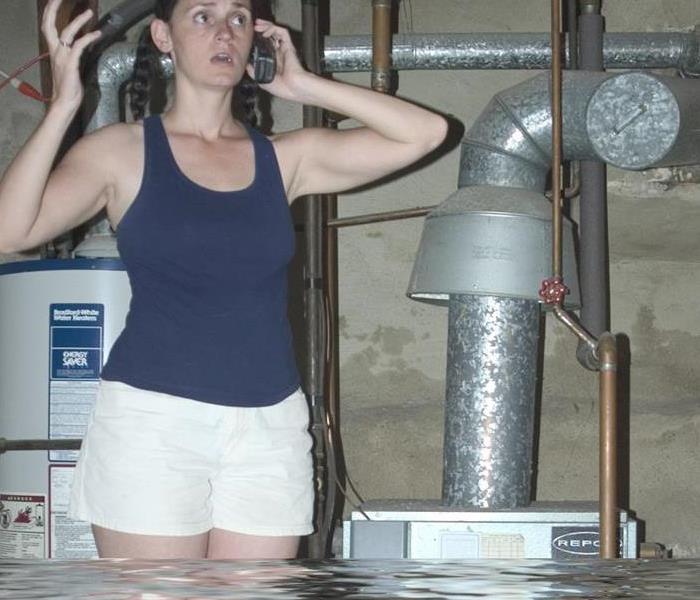 flood
flood
- Floods are the #1 natural disaster in the United States.
- From 2011 to 2015, the average flood claim amounted to more than $46,000.
- From 2006 through 2015, total flood insurance claims averaged more than $1.9 billion per year.
- In 2015, the average policy premium was nearly $700.
- Even though flood insurance isn't federally required, anyone can be financially vulnerable to floods. In fact, people outside of mapped high-risk flood areas file more than 20 percent of all National Flood Insurance Program flood insurance claims and receive one-third of Federal disaster assistance for flooding.
- The NFIP paid more than $839 million in flood insurance claims to all policyholders in 2015.
- 2015 CLAIM REPORT FOR THE TOP 10 STATES
Texas9,670
South Carolina3,715
Florida1,079
New Jersey 1,045
Kentucky 1,034
Water damage
1/13/2017 (Permalink)
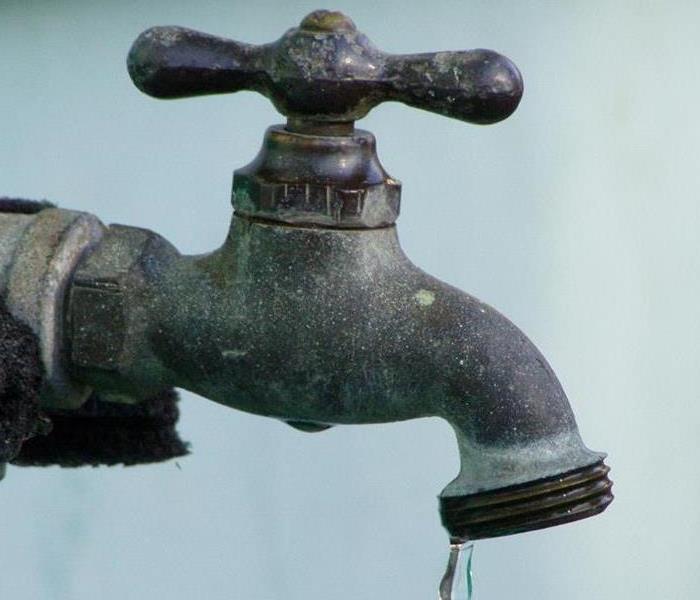 water dripping
water dripping
SERVPRO has the Answer for Property Owners Faced with Water Damage.
Water damage is one of the risks a homeowners face when they buy a home. Indoor plumbing will likely fail at some point, and when it does, it makes for a wet mess. The experienced professionals at SERVPRO can help you identify the source of the problem, correct it, and restore your home to a clean, dry condition. Rapid water extraction, after the source has been eliminated, and then moisture removal to reach standard household levels, will mitigate the dangers of contaminated water and mold growth. One of the first things that need to be determined when you have flooding caused by a plumbing failure is whether the water is clean, gray or black. These classifications indicate where the water is coming from and what sort of contaminants it may contain. Water damage occurs in many forms. Clean Water refers to water that is piped into your home. It has not yet been used for any household purpose, so it is clear and free of any hazardous substances. Drinking water. This water may be leaking from a burst pipe in the walls; it can also be the result of a failed pressure valve on your water heater tank, which allows the water to flood out. There is a large list of possible reasons for an unwanted water intrusion. Gray Water is more damaging. This is water that has flowed in sinks, showers, washing machines and all other plumbing including toilets tanks. Gray water does not contain harmful pathogens, but it does hold food waste, chemical products, and absorbed particulates from the surroundings that can harbor bacteria. Some soaps and other personal care products also contain ingredients that can be toxic if ingested. Black water is the most dangerous. It includes overflow water from a toilet, backed up septic tanks or sewer lines, and degraded gray water. This water contains hazardous bacteria that are linked with raw sewage. If you detect black water flooding, keep yourself and your family out of contact with the water. If you must enter the flooded area, you should wear rubber gloves, safety goggles, and protect your feet with rubber boots or plastic bags. Call the professionals from SERVPRO. Whenever your household plumbing fails, no matter what the source of the water is, we can help. Rapid and safe water removal from your property will mitigate health concerns, water damage to personal possessions, furnishings, and building materials. We can also save you money by repairing and restoring rather than replacing salvageable property. Our IICRC-certified and corporately trained technicians have the skills to return your water damaged home to pre-loss condition "Like it never even happened.
We Use Advanced Drying Equipment and Techniques
As leaders in the water damage industry, SERVPRO has advanced training and expertise, not to mention a tremendous amount of hands-on experience.
ice dams
1/11/2017 (Permalink)
ICE DAMS: Several quick fixes but only one cure.
An Ice Dam is a hump of ice that forms at the edge of a roof under certain wintertime conditions. An ice dam can damage both your roof and the inside of your home. It will put gutters and downspouts at risk too.
Ice Dams are a common sight in winter, and Home Partners has dealt with quite a few. There are several things you can do to avoid getting an ice dam or to reduce the risk of damage after one has formed, but there’s really only one cure: a combination of better sealing, insulation, and venting in the attic and eaves.
HOW DO ICE DAMS FORM?
An ice dam forms when the roof over the attic gets warm enough to melt the underside of the layer of snow on the roof. The water trickles down between the layer of snow and the shingles until it reaches the eave of the roof, which stays cold because it extends beyond the side of the house. There, the water freezes, gradually growing into a mound of ice.
The flatter the pitch of the roof, the easier it is for an ice dam to get a grip. Gutters at the eaves can also trap snow and ice. If snow and ice build up high enough in the gutter, it can provide a foundation for an ice dam.
WHAT DAMAGE DO ICE DAMS CAUSE?
When an ice dam gets big enough, melted water backs up behind it and seeps underneath the shingles. Eventually, it will drip into the insulation and down into the ceilings and exterior walls beneath the eave, ruining sheetrock and paint. If the ice dam breaks free, it can pull shingles and gutters off with it, and it will damage anything it falls on: shrubs, windowsills, cars, pets, and people. If the roof sheathing stays wet, it can form mildew and start to rot
DEALING WITH EXISTING ICE DAMS
1. Remove the ice dam by breaking it free in small chucks. Do NOT use an ax or other sharp tool! You’ll cut through the shingles. Instead, tap lightly with a blunt mallet. This is slow, dangerous work, so hire someone experienced at roofing. Even if you do it safely, the chunks of ice can take pieces of shingle with them.
2. Clear out gutters and downspouts. Again, this is ladder work and an easy way to damage either plastic or metal gutters and spouts.
3. Melt troughs through the ice dam with calcium chloride ice melter. Do NOT use rock salt! It will damage paint, metals, and plants beneath the eave and wherever the salty water drains.
A good trough-maker is a tube of cloth (a leg from an old pair of panty hose works well). Fill it with calcium chloride, tie off the top, and lay it vertically across the ice dam. It will slowly melt its way down through the dam, clearing a path for the underlying water to flow free.
When Winter Weather Strikes
12/23/2016 (Permalink)
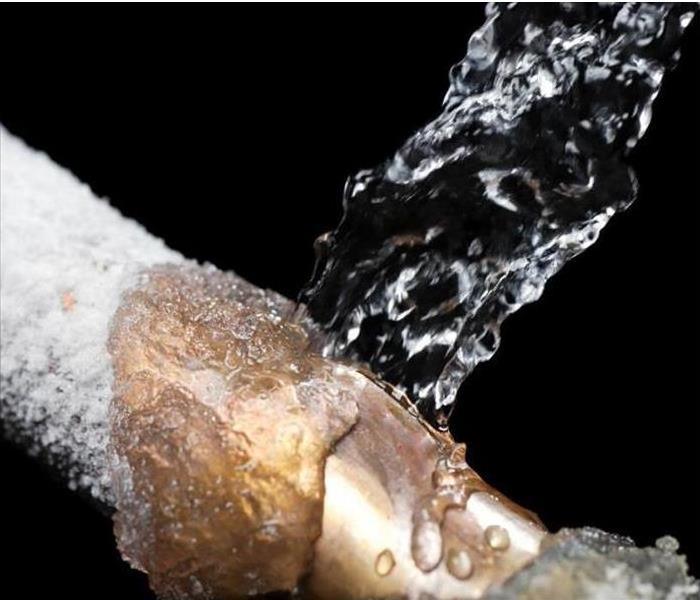 Strike Back at Winter Weather
Strike Back at Winter Weather
When winter weather strikes be ready to strike back. A burst pipe can cause significant water damage in your home or business. Water damage and the potential for mildew and mold taking hold if proper water mitigation is not instituted Faster to Your Disaster can be extremely expensive. Our experts can help coordinate your insurance claim with your home or business insurance carrier. Thankfully, SERVPRO of cherryhill, your local water cleanup and restoration experts are there to make your problem much more manageable.
Frozen pipes can burst at the point where the ice blockage is located. Usually, the rupture is caused by the backflow pressure between the water source and the blockage. A burst pipe can quickly cause considerable damage to your property if not addressed quickly. An inexperienced home or business owner that attempts to fix the problem themselves can easily make the problem worse.
Calling SERVPRO of Cherryhill to assess possible structural damage that is difficult to spot from leaky pipes is crucial in ensuring that even a small amount of water does not cause catastrophic results. The first step is finding the source of the water damage and stopping the flow of the water from continuing from entering. The more water, the bigger the water damage cleanup. If it is a broken pipe that has burst that can’t be seen, the first step is to turn off the water supply into your home or business as quickly as possible. The water main is usually in the garage or in the front yard under a cement plate marked “water”.
Certified professionals can quickly reverse the damage caused by a burst pipe and save as many items as possible through restoration techniques. The professionals will work through the structure and perform a thorough inspection with moisture meters to determine how much moisture is in your home or business. They will pump out any standing water and begin the drying process. If mold or other pathogens are present, they will eliminate them using the proper tools and procedures. Attempting cleanup efforts on your own can lead to injury or illness.
SERVPRO of Bordentown has a 1-4-8 response. Within 1 hour from the notice of loss, a SERVPRO professional will contact you to arrange for service. Within 4 hours, SERVPRO will be on-site and will start mitigation services. Within 8 hours of arriving on-site, a verbal briefing of the scope of the work needed will be communicated to you or your insurance professional. (*Exceptions may apply under certain conditions, such as a local catastrophic or storm situation). The experts know that time is of the essence and come prepared for nearly any situation.
In the aftermath of a winter weather striking a pipe it may feel like the catastrophe is impossible to fix. Contact us 24 hours a day, 365 days a year
How to Protect your Basement from Water Damage
12/21/2016 (Permalink)
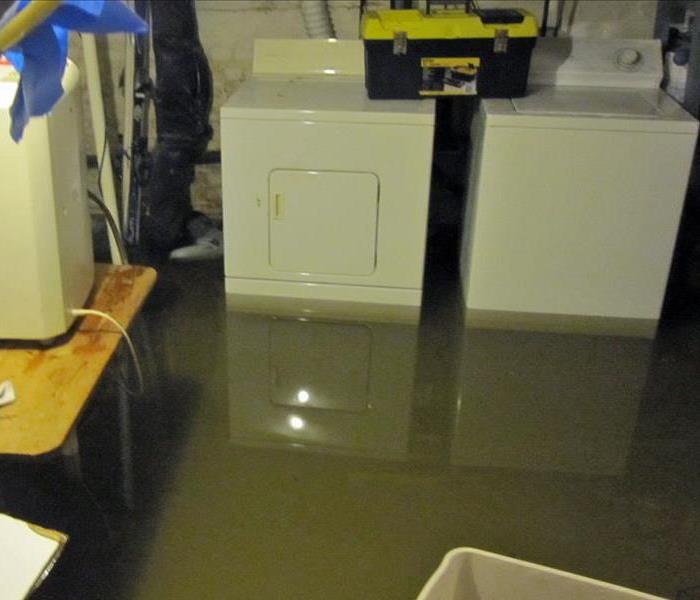 This basement had about a foot of water that needed to be extracted. The dry out process took 5 days
This basement had about a foot of water that needed to be extracted. The dry out process took 5 days
I just bought my first home. Unlike most homebuyers who are looking for an open floor plan or a gourmet kitchen, my first stop was always the basement! My favorite time to look at houses was in the rain, when I could determine if the basement was prone to flooding. Several times, I walked into a house's basement and watched as water ran down the walls.
Obviously, frequent water intrusion in your basement can cause issues with your foundation, and mold. But most people don't know what to look for or how to protect their basement until after they've experienced a water damage. What's obvious to me as someone who has worked in the restoration industry for 4 years may not be obvious to every homeowner, so here are some tips to help you stay dry!
- Get a sump pump. Get the sump pump rider on your insurance policy while you are at it. If you have a sump pump and it fails, your homeowners insurance will not cover the damage. Even if your home or business has never taken on water, it doesn't mean you are immune to it. Get the sump pump and check that it's functioning properly regularly.
- Consider a French drain or some other form of waterproofing. Have a professional do the work. Google the benefits. You may be surprised!
- Keep your gutters free of debris and position downspouts away from the foundation. The goal is to drain water at least three feet away, so if necessary, consider running extensions or troughs.
- If you haven't had your sewer inspected or your septic tank cleaned, now is a good time to do that. During periods of prolonged, heavy rainfall (think Hurricane season!), clogged sewers and over-taxed septics are disasters waiting to happen.
- If you have below-grade basement windows, install window covers that fasten securely to your foundation. Clear acrylic covers allow light to enter while keeping out water.
- Check the age on your hot water heater. They generally last about 10 years. If yours has made it longer, that's not necessarily a good thing! Don't wait for it to fail before you replace it.
- If you use your basement for storage, build shelves at least 6 inches from the ground. Store items in plastic bins. Photograph everything you store down there in case you need to replace it later.
- If you have a finished basement, get a good-quality dehumidifier. Consider tile floors or polished concrete over carpets.
Do's and Don'ts of Water Intrusion
9/23/2016 (Permalink)
Do:
* Remove as much excess water as possible by mopping and blotting.
* Wipe excess water from wood furniture after removal of lamps and table top items.
* Remove and prop wet upholstery and pillow cushions for even drying.
* Place aluminum foil or wood blocks between furniture legs and wet carpeting.
* Turn air conditioning on for maximum drying in summer.
* Remove Oriental rugs or other colored rugs from wet wall-to-wall carpeting.
* Remove valuable paintings and art objects to a safe, dry place.
* Open and place luggage, in sunlight to dry, if possible.
* Gather loose items, toys, etc. from floors.
Don’t:
* Leave wet fabrics in place; dry as soon as possible. Hang furs and leather goods to dry separately at room temperature.
* Leave books, magazines or other colored items on wet carpets or floors.
* Use your household vacuum to remove water.
* Use TVs or other household appliances while standing on wet carpets or floors, especially not on wet concrete floors.
* Turn on ceiling fixtures if ceiling is wet, and keep out
CALL SERVPRO 1-866-838-5200






 24/7 Emergency Service
24/7 Emergency Service